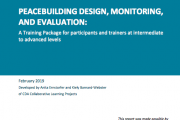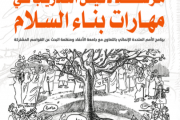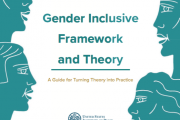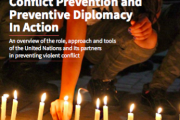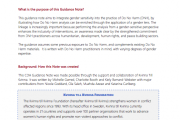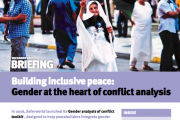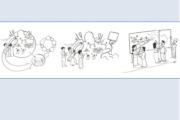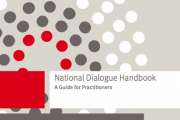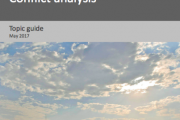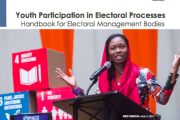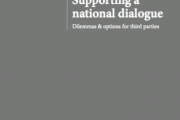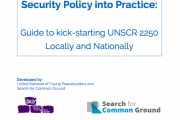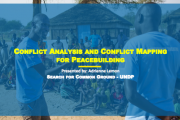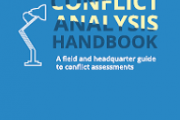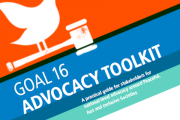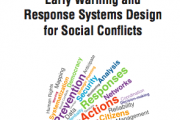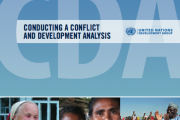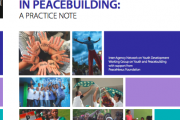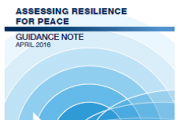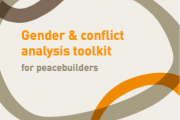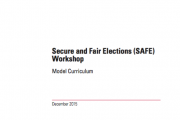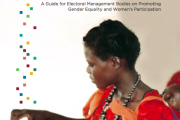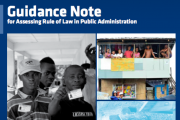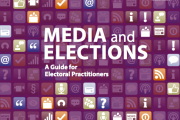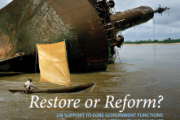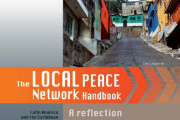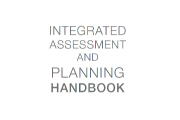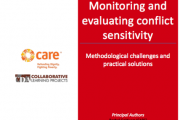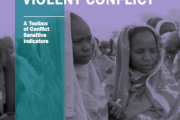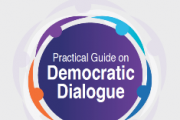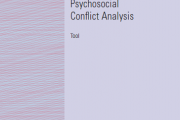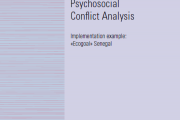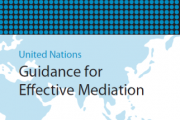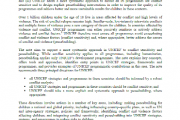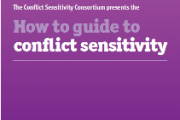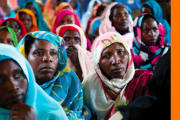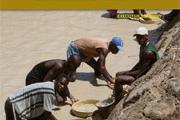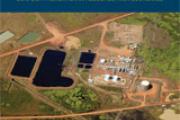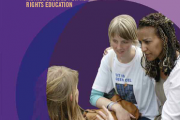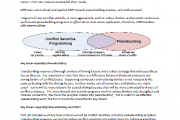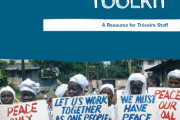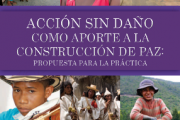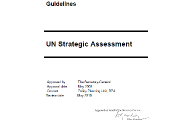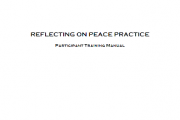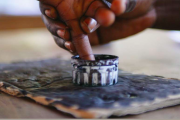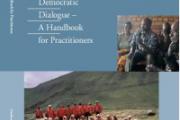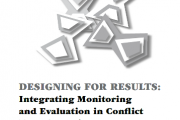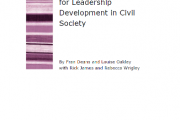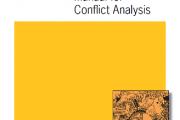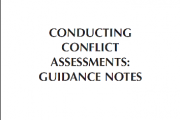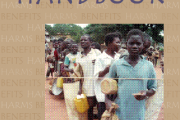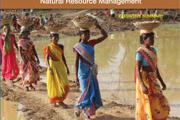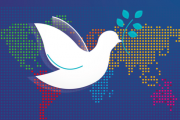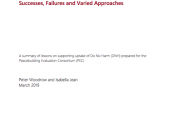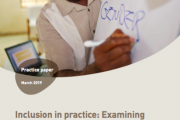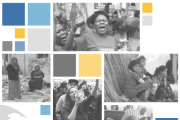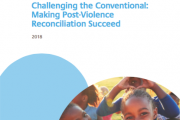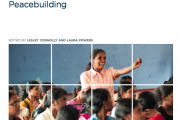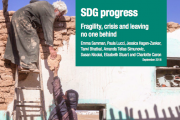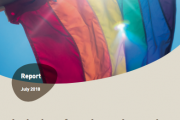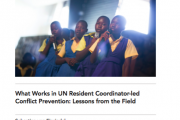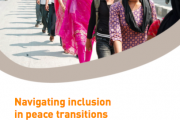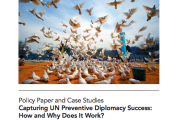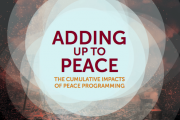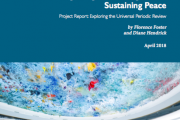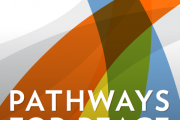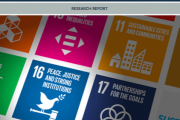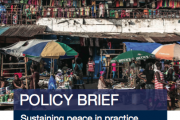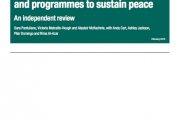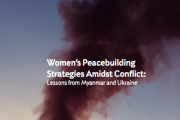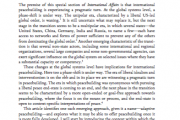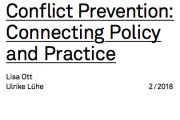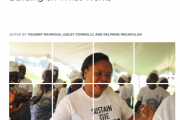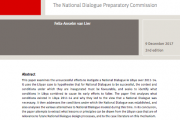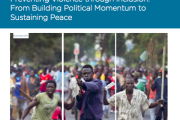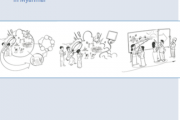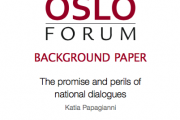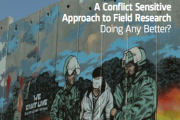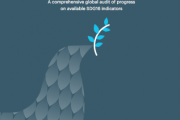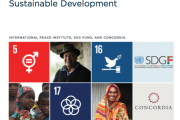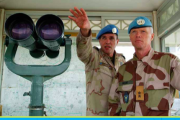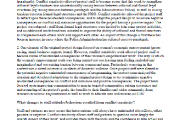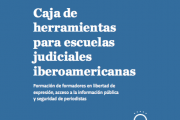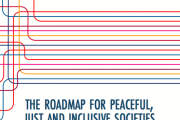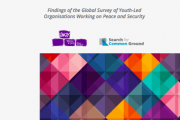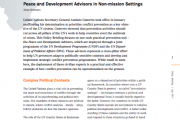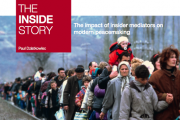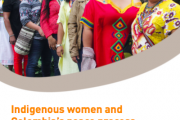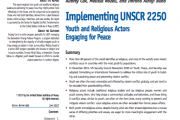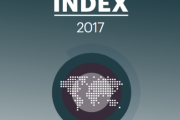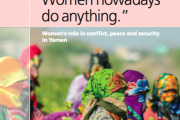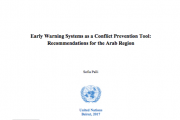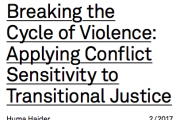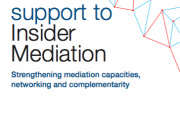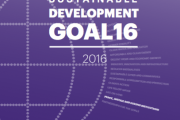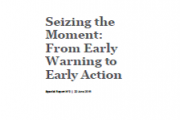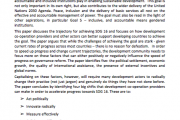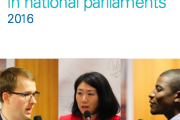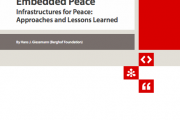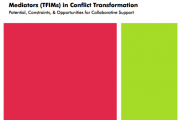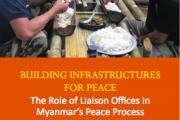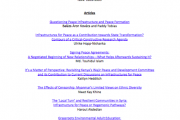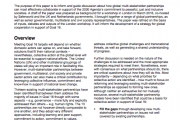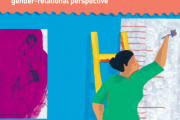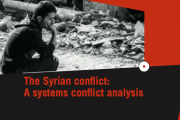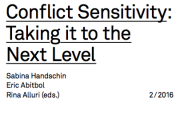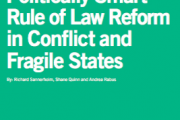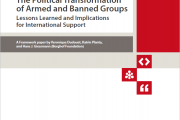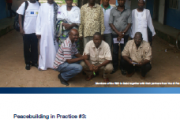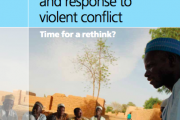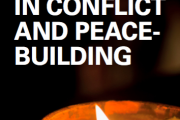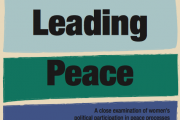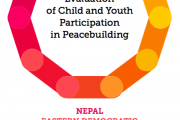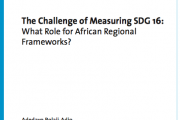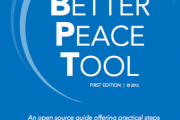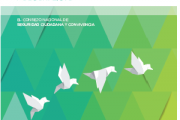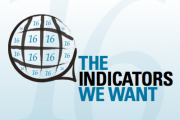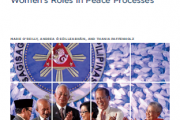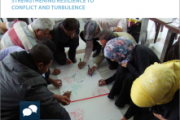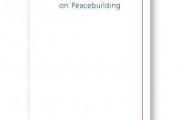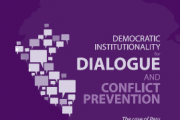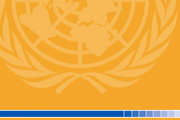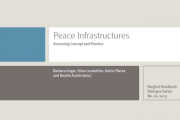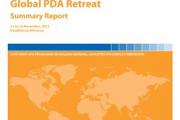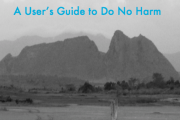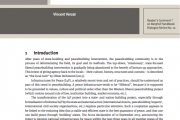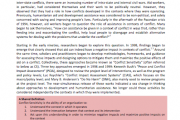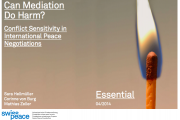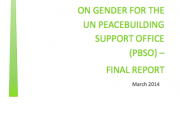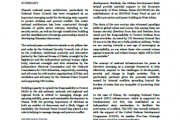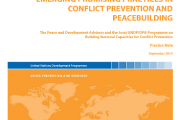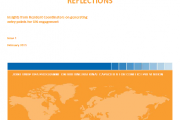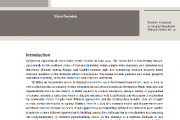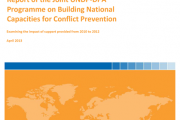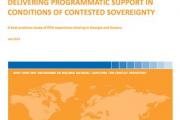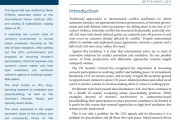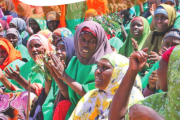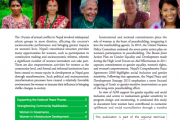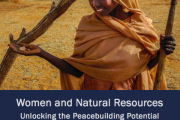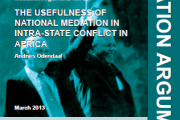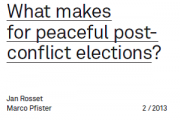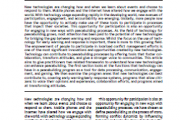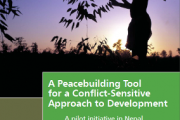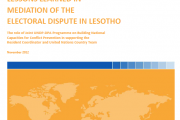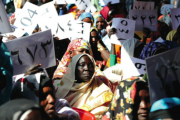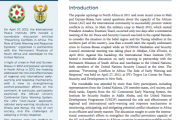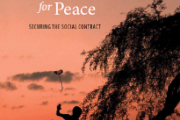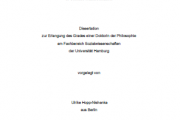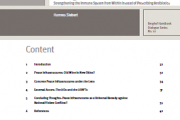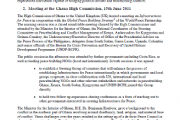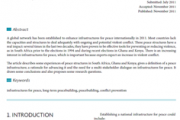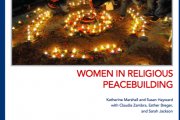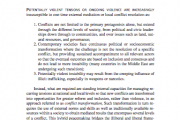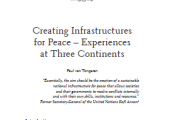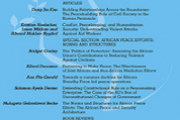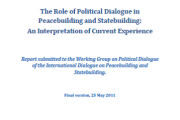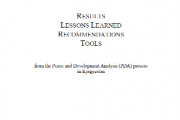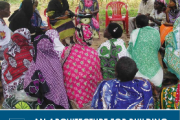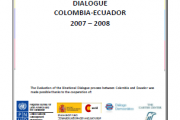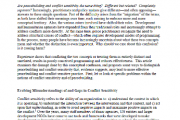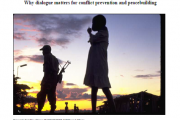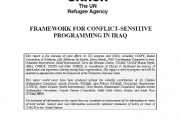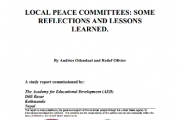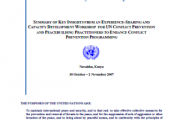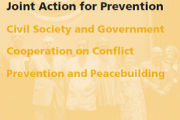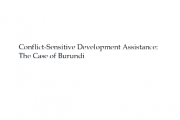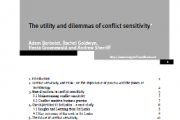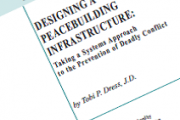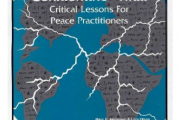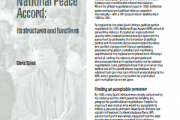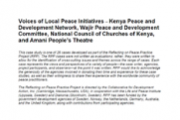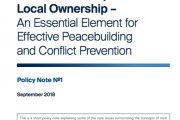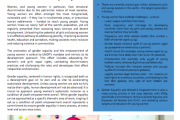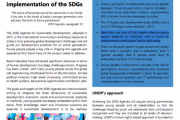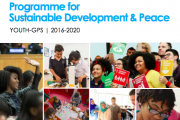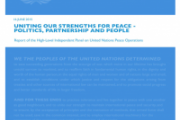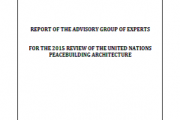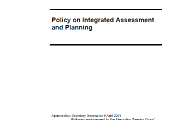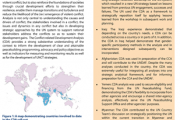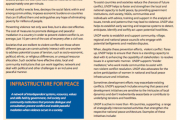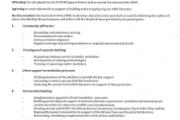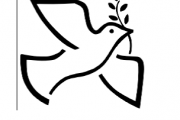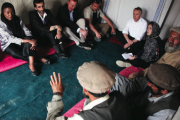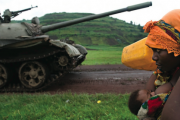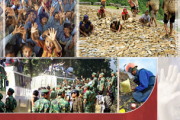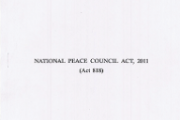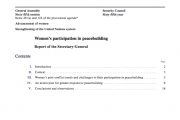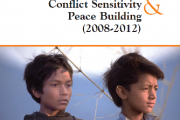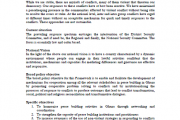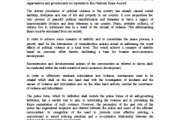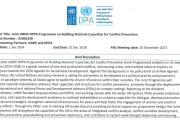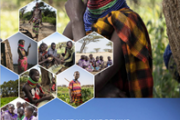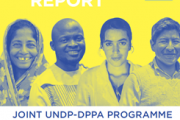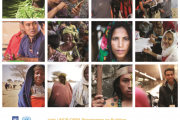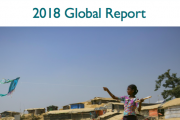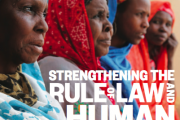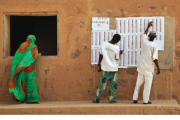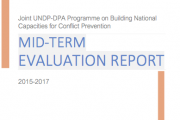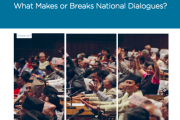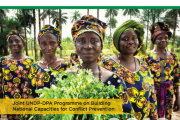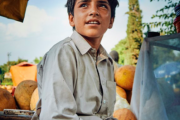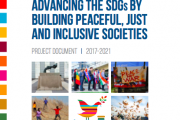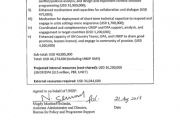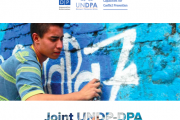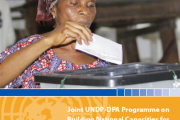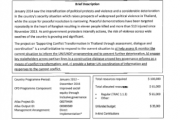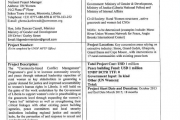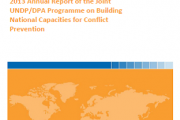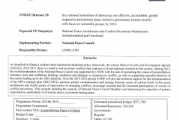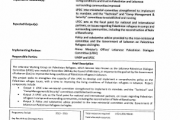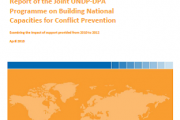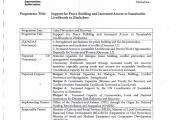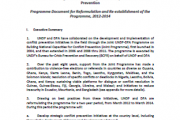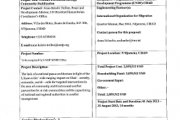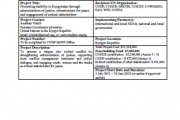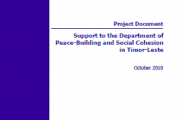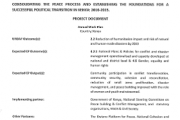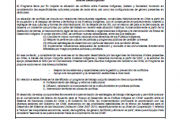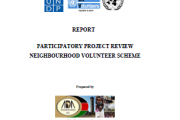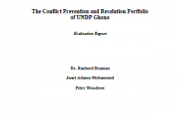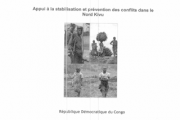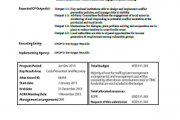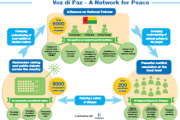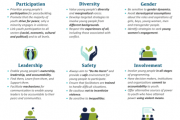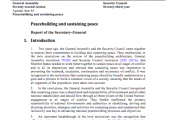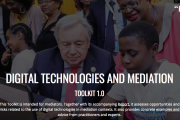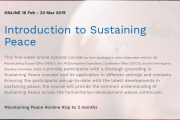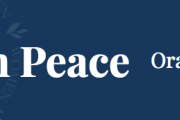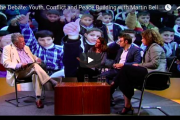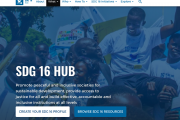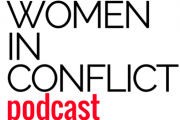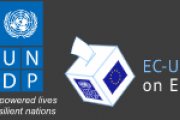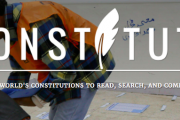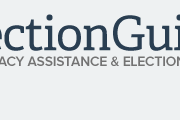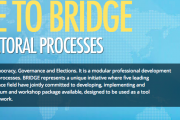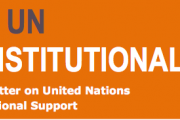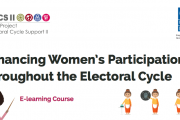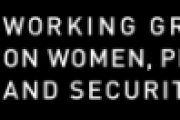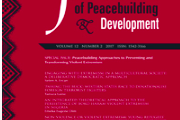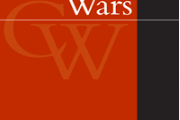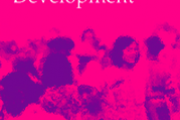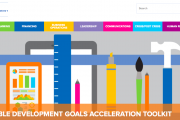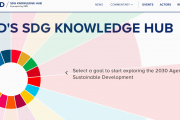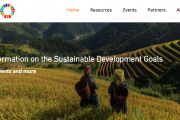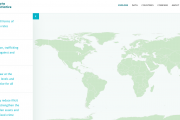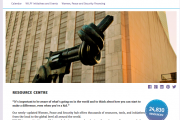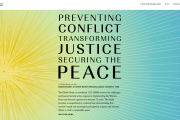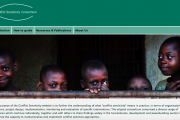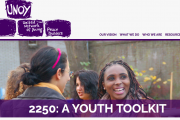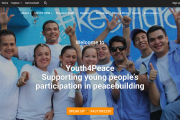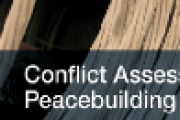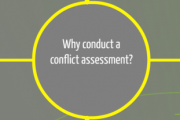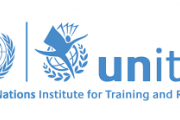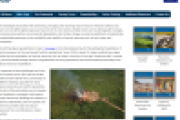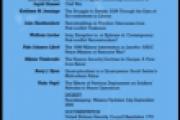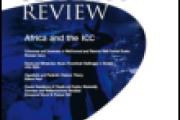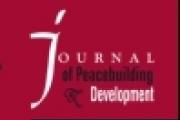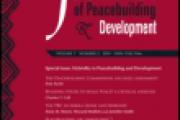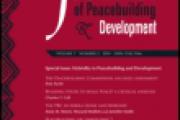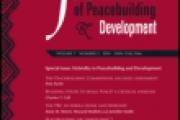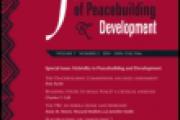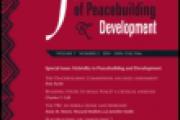
Library
The Library is a repository of documents and online resources intended to assist practitioners and other stakeholders in supporting I4P and conflict prevention initiatives. It contains guidance and training material, research papers, policy and project-related documents that draws on a wide array of sources.
Welcome to Library Search
Search Filters
Country
Regions
Thematic Issue
Type of Document
Source of Document
Date Range
- From:
- To:
Language
No search results found. Please try again with different filters or keywords.
Please choose from the filters on the left or select one of the categories below.
Suggesting Thematics to Search From
- Building National Capacities for Prevention
- Conflict Analysis
- Conflict Prevention
- Conflict Sensitivity
- Democratic Governance
- Dialogue Process
- Early Warning Early Response
- Infrastructures for Peace
- Insider Mediation
- Peace and Development Advisors
- SDG 16
- Sustaining Peace
- Women in Peacebuilding
- Youth & Peacebuilding
Guidance/Handbooks/Training
Guidance on Mediation of Ceasefires
United Nations DPPA, 2024
Guidance on Mediation of Ceasefires || United Nations DPPA || This Guidance document outlines a set of principles, technical factors, and good practices for individuals involved in negotiating or planning ceasefires. It aims to assist United Nations senior leaders, mediators, conflict parties, and other stakeholders in peace processes. Acknowledging that ceasefires are inherently political, this Guidance emphasizes the technical considerations relevant to ceasefire mediation. Given the wide range of conflict settings worldwide, it offers a framework that can be adapted to any context and addresses challenges arising from increasingly complex conflicts, including regional and international aspects. Since ceasefire processes and dynamics are constantly evolving, this Guidance will be reviewed periodically.
|| Insider Mediation || Insider Mediators || Guidance/Handbooks/Training || UN/International Organization || Arabic || English || French || Russian || Spanish
Digital Technologies and Mediation in Armed…
DPPA and Centre for Humanitarian Dialogue , 2019
Digital Technologies and Mediation in Armed Conflict || DPPA and Centre for Humanitarian Dialogue || This report is an attempt to assess the implications of growing connectivity and reliance on digital technologies for what has always been a human-intensive endeavour: the mediation of armed conflicts. It will inform and accompany the development of a Toolkit for mediators. The objective of this work is to: (i) raise awareness among mediation practitioners of the implications of digital technology use in mediation contexts; (ii) promote ongoing reflection and discussion on the topic; (iii) provide mediators with concrete examples and practical information on digital technologies; and (iv) establish a community of practice to exchange information and experiences, including on how to integrate digital technologies into mediation strategies.
The report also showcases the manifold opportunities that digital technologies offer to mediators and their teams to support their work. It focuses on four thematic areas: (1) conflict analysis; (2) engagement with conflict parties; (3) inclusivity; and (4) strategic communications. || Insider Mediation || Conflict Prevention || Conflict Analysis || Inclusivity || Mediation || Guidance/Handbooks/Training || UN/International Organization || English
SDG16+ Progress Report 2019 - A comprehensive…
Institute for Economics and Peace, 2019
SDG16+ Progress Report 2019 - A comprehensive global audit of progress on available SDG16 indicators || Institute for Economics and Peace || This report presents the third in a series of yearly reports produced by the Institute for Economics and Peace on SDG16, which measures peace, justice and strong institutions. Experience from the Millennium Development Goals (MDGs) shows that development is hindered by low peace and weak institutions. As such, in the UN 2030 Agenda on Sustainable Development, SDG16 is considered fundamental to achievements in many of the other SDGs. || SDG 16 || Case Study || Guidance/Handbooks/Training || Academia/Think Tank || English
Peacebuilding Design, Monitoring, and Evaluation …
Anita Ernstorfer and Kiely Barnard-Webster, CDA,…, 2019
Peacebuilding Design, Monitoring, and Evaluation - A Training Package for participants and trainers || Anita Ernstorfer and Kiely Barnard-Webster, CDA, and the Peacebuilding Evaluation Consortium || This manual is designed to support learning led by seasoned trainers with subject matter expertise in peacebuilding program design, conflict analysis, conflict sensitivity, monitoring and evaluation. Though this guide incorporates many of the most widely recognized peacebuilding DM&E guidance materials from the past decade, it has also been intentionally, and explicitly, tailored to support peacebuilding practitioners to improve the quality of their DM&E decision-making.
This training manual has seven modules:
Module 1: Introduction and Orientation
Module 2: Conflict Analysis
Module 3: Peacebuilding Program Design
Module 4: Monitoring, Evaluation, and Learning (MEL) Plan
Module 5: Baseline and Indicator Development
Module 6: Monitoring for Intended and Unintended Impacts and Adaptive Management
Module 7: Evaluation and Other Evaluative Processes || Conflict Analysis || Conflict Prevention || Civil Society || Conflict Sensitivity || Conflict Analysis || Peacebuilding || Project Design || Training/Skills Development || Guidance/Handbooks/Training || Other
Peacebuilding Manual and Guide
UNDP, 2018
Peacebuilding Manual and Guide || UNDP || This unique tool, a Peacebuilding Manual and Guide in Arabic, was developed in a participatory way to address the needs for better and user-friendly material.
|| Sudan || Arab States || Conflict Prevention || Participation || Peacebuilding || Guidance/Handbooks/Training || UN/International Organization || Arabic || Arabic
Gender Inclusive Framework and Theory
Kathleen Kuehnast, Danielle Robertson and USIP, 2018
Gender Inclusive Framework and Theory || Kathleen Kuehnast, Danielle Robertson and USIP || The Gender Inclusive Framework and Theory (GIFT) guide is an approachable and thorough tool that facilitates the integration of gender analysis into project design. Because peacebuilding work is context dependent, the GIFT puts forth three approaches to gender analysis – the Women, Peace and Security Approach; the Peaceful Masculinities Approach; and the Intersecting Identities Approach – that each illuminate the gender dynamics in a given environment to better shape peacebuilding projects. || Conflict Analysis || Women/Gender || Peacebuilding || Project Design || Case Study || Guidance/Handbooks/Training || Government || English
United Nations Conflict Prevention and Preventive…
DPA, 2018
United Nations Conflict Prevention and Preventive Diplomacy in Action || DPA || This booklet, prepared by the Department of Political Affairs in consultation with key partners across the UN system, presents a non-exhaustive, illustrative overview of the UN’s approach to conflict prevention and preventive diplomacy. It summarizes a series of cases--from Burkina Faso, Kyrgyzstan, Liberia, Guyana and Colombia--selected to show prevention at work in diverse contexts, the different tools deployed to support national actors in preventing violent conflict, and the multiple UN actors involved in implementing these efforts, including UNDP, PBSO and OHCHR. || Burkina Faso || Kyrgyzstan || Liberia || Guyana || Colombia || Conflict Prevention || Case Study || Conflict Prevention || Guidance/Handbooks/Training || UN/International Organization || English
Do No Harm and Gender- A Guidance Note
Michelle Garred, Charlotte Booth and Kiely…, 2018
Do No Harm and Gender- A Guidance Note || Michelle Garred, Charlotte Booth and Kiely Barnard-Webster, CDA || This Note aims to integrate gender sensitivity into the practice of Do No Harm by illustrating how Do No Harm analysis can be enriched through the application of a gender lens. The linkage is increasingly important: performing the analysis from a gender-sensitive perspective enhances the inclusivity of interventions, an awareness made clear by the strengthened commitment from DNH practitioners across humanitarian, development, human rights, and peace building sectors.
|| Conflict Sensitivity || Conflict Analysis || Conflict Sensitivity || Women/Gender || Guidance/Handbooks/Training || Academia/Think Tank || English
Religion in Conflict and Peacebuilding Analysis…
Owen Frazer, Mark Owen and USIP, 2018
Religion in Conflict and Peacebuilding Analysis Guide || Owen Frazer, Mark Owen and USIP || An analysis guide written for people who are working to address violent conflicts in which religion plays a part a role or can aid in peacebuilding. It provides guidance on how to understand the religious dimensions of conflict and take them into consideration in
|| Faith-based || Peacebuilding || Conflict Analysis || Guidance/Handbooks/Training || Other || English
Building Inclusive Peace- Gender at the Heart of…
Saferworld, 2017
Building Inclusive Peace- Gender at the Heart of Conflict Analysis || Saferworld || Saferworld’s Gender analysis of conflict toolkit helps peacebuilders understand how gender influences conflict dynamics. This policy briefing, Building Inclusive Peace: Gender at the Heart of Conflict Analysis, explores the toolkit's principles in action and shares findings of participatory conflict analysis and research in Myanmar, Libya and Yemen.Conclusions and recommendations draw from Myanmar, Yemen and Libya, based on findings and funding from country-based women's organisations, Saferworld, the Women’s International League for Peace and Freedom, and Oxfam. || Conflict Analysis || Case Study || Women/Gender || Guidance/Handbooks/Training || Academia/Think Tank || English
Conflict sensitivity - Indicators for local and…
UNDP and International Alert, 2017
Conflict sensitivity - Indicators for local and community development programming in Myanmar || UNDP and International Alert || This guidance is intended for use by organizations approving, designing, implementing or monitoring local and community development projects or programmes in Myanmar. It explains how monitoring against indicators can contribute to making local and community development projects conflict sensitive, by measuring positive and negative interactions between the project’s activities and the context/environment, not only when located in conflict-affected regions, but wherever they are implemented in Myanmar. The first section outlines how to create and use indicators as part of monitoring and evaluation (M&E). The second section explains how to use them to help achieve conflict sensitivity during project implementation. || Myanmar || Asia Pacific || Conflict Sensitivity || Conflict Sensitivity || Monitoring and Evaluation || Project Design || Local/Community-level Initiative || Guidance/Handbooks/Training || UN/International Organization || English
National Dialogue Handbook-A Guide for…
Berghof Foundation and swisspeace, 2017
National Dialogue Handbook-A Guide for Practitioners || Berghof Foundation and swisspeace || Grounded in a series of contemporary case studies, this Handbook aims to contribute to the debate about National Dialogue, bringing together insights and expertise from diverse regions. In doing so,
it seeks to present systematic reflections and offer practical
advice. The Handbook thus supports conflict stakeholders and practitioners (both local and international) to grapple with the challenges they face and to pursue the most appropriate design for their particular context. Aimed at both internal and external actors who seek to plan, conduct, implement and support National Dialogues in an effective and efficient manner, it focuses on how to conduct and support such a process. The purpose of the National Dialogue Handbook is both to offer an analytical framework of National Dialogue processes and to serve as a practical tool for those engaged in the implementation of these processes. || Africa || Arab States || Americas || Dialogue Process || Dialogue || Insider Mediators || Guidance/Handbooks/Training || Academia/Think Tank || French || English || Arabic || Spanish
Conflict Analysis Topic Guide
Siân Herbert and GSDRC, 2017
Conflict Analysis Topic Guide || Siân Herbert and GSDRC || This Topic Guide looks at how conflict analysis is done – at the systematic approaches and tools for conflict analysis developed for policy and practice. It highlights common principles, lessons and challenges identified in the literature.
|| Conflict Analysis || Conflict Analysis || Conflict Sensitivity || Guidance/Handbooks/Training || Academia/Think Tank || English
Advancing the Human Rights and Inclusion of LGBTI…
UNDP and Parliamentarians for Global Action, 2017
Advancing the Human Rights and Inclusion of LGBTI People- A Handbook for Parliamentarians || UNDP and Parliamentarians for Global Action || This Handbook sets out relevant human rights frameworks and highlights the role of parliamentarians in implementing Agenda 2030, to ensure no one, including LGBTI people, is left behind. It offers practical tips, tools and resources designed to support parliamentarians to undertake legislative, representational and oversight activities that advance the rights and inclusion of LGBTI people. || Democratic Governance || Parliaments || Guidance/Handbooks/Training || UN/International Organization || English
Youth Participation in Electoral Processes –…
EC-UNDP Joint Task Force on Electoral Assistance …, 2017
Youth Participation in Electoral Processes – Handbook for Electoral Management Bodies || EC-UNDP Joint Task Force on Electoral Assistance (JTF) || Specifically designed for electoral management bodies (EMBs), this publication acknowledges the crucial role EMBs play in ensuring that all segments of the society, including youth, are empowered to fully participate in the electoral process, be as voters, candidates or officials. The handbook provides strategies and entry points to assist EMBs in removing existing barriers for youth electoral participation at different levels and in different areas, including the national legal and political framework and youth’ lack of confidence in national institutions. || Democratic Governance || Youth || Elections/Electoral Violence || Guidance/Handbooks/Training || Other || English
Positive Youth Development Measurement Toolkit- A…
USAID, 2016
Positive Youth Development Measurement Toolkit- A Practical Guide for Implementers of Youth Programs || USAID || This toolkit provides implementers of youth programming a variety of references, resources, and tools on how to use a positive youth development (PYD) approach for evaluating youth-focused programming. A PYD approach to evaluation will measure whether youth are positively engaged in and benefiting from investments that ultimately empower them to develop in healthy and positive ways so that they can contribute to the development of their communities. || Youth & Peacebuilding || Youth || Guidance/Handbooks/Training || Government || English
Mediation Practice Series - Supporting a National…
Jonathan Harlander and The Centre for…, 2016
Mediation Practice Series - Supporting a National Dialogue || Jonathan Harlander and The Centre for Humanitarian Dialogue || There is no blueprint for a national dialogue. A wide variety of national dialogues have been organised, with diverse mandates, rules of procedure, compositions and outcomes. This diversity reflects the unique political experience and needs of the society and state for which they are designed. This Mediation Practice Series paper will seek to provide concrete examples in order to identify key factors of success for a national dialogue and prepare third parties for the challenges that they might face in supporting such processes. Facilitators and stakeholders should however keep in mind that a national dialogue is not a ‘one- size-fits-all solution’, nor a solution in itself. Other options exist for state reforms or transitions and the enthusiasm for national dialogues which followed the Arab Spring should not hide the fact that such processes are useful only in particular contexts and, if inadequate, can do more harm than good. || Dialogue Process || Dialogue || National-level Initiative || Training/Skills Development || Guidance/Handbooks/Training || Other || English
Women's Rights in Constitutions
UNDP, 2016
Women's Rights in Constitutions || UNDP || This publication is designed to support UNDP staff, partners and national stakeholders who wish to advocate for the inclusion of comprehensive constitutional provisions that protect and advance women’s human rights and fundamental freedoms. It presents good practices for the advancement of gender equality in constitutional provisions through the articulation of women’s political, civil, economic, social and cultural rights. Taking examples from existing constitutions throughout the world, it also shows how gender-inclusive language, temporary special measures, the incorporation and adaptation to the domestic context of human rights treaties and institutional measures can protect and advance women’s rights. || Democratic Governance || Constitution || Women/Gender || Guidance/Handbooks/Training || UN/International Organization || English
Translating Youth, Peace and Security Policy into…
UNOY & SFCG, 2016
Translating Youth, Peace and Security Policy into Practice-Guide to kick-starting UNSCR 2250 Locally and Nationally || UNOY & SFCG || This guide is intended to help those interested in beginning to implement UNSCR 2250 locally and nationally to get started by forming a multi-stakeholder alliance around youth, peace and security. || Youth & Peacebuilding || Youth || Training/Skills Development || Guidance/Handbooks/Training || Other || English
Conflict Analysis And Conflict Mapping For…
Adrienne Lemon, 2016
Conflict Analysis And Conflict Mapping For Peacebuilding || Adrienne Lemon || The following resource is a powerpoint presentation presented by Search for Common Ground's Adrienne Lemon on "Conflict Analysis and Conflict Mapping for Peacebuilding" in South Sudan. This powerpoint highlights steps to a conflict sensitive approach, outlines how to do no harm, and offers brainstorming questions to facilitate a conflict analysis. Mapping & Analysis Workshop for CSOs & Partners". || South Sudan || Africa || Conflict Analysis || Conflict Sensitivity || Conflict Analysis || Conflict Sensitivity || Peacebuilding || Guidance/Handbooks/Training || Other || English
Gender Analysis of Conflict
Saferworld, 2016
Gender Analysis of Conflict || Saferworld || This toolkit for gender analysis of conflict is intended to help national and international non-governmental organisations and other peacebuilding practitioners to integrate gender perspectives into conflict analysis, providing a foundation for more gender-sensitive peacebuilding programmes. This toolkit is designed to be complementary to Conciliation Resources’ Gender and conflict analysis toolkit for peacebuilders. || Conflict Analysis || Conflict Analysis || Case Study || Women/Gender || Guidance/Handbooks/Training || Academia/Think Tank || English
Conflict Analysis Handbook - A Field and…
United Nations System Staff College (UNSSC), 2016
Conflict Analysis Handbook - A Field and Headquarter Guide to Conflict Assessments || United Nations System Staff College (UNSSC) || Developed by the UN Staff College, this handbook provides an overview of the evolution and current practice of conflict analysis; explores the changing patterns of violent conflicts in the world today and suggests how new and unconventional disci¬plines – such as systems thinking – can be integrated to complement traditional conflict analysis approaches; and finally articulates the steps required to conduct an ideal conflict analysis process. It presents some guiding principles and screening questions that are critical to design an effective and fit-for-purpose analysis process; it then walks the user through the imple-mentation of the actual assessment, providing guidance with regard to the various tools. || Conflict Analysis || Conflict Analysis || Guidance/Handbooks/Training || UN/International Organization || English
Goal 16-Advocacy Toolkit
TAP Network, 2016
Goal 16-Advocacy Toolkit || TAP Network || A practical guide for stakeholders for national-level advocacy around Peaceful, Just and Inclusive Societies. || SDG 16 || Guidance/Handbooks/Training || Civil Society || English
Practical Guide Early Warning and Response…
UNDP and Organization of American States, 2016
Practical Guide Early Warning and Response Systems Design for Social Conflicts || UNDP and Organization of American States || The main purpose of this “Practical Guide for Early Warning and Response Systems Design for Social Conflicts” is to contribute to strengthening a preventive approach in addressing social conflict in the region, providing some basic aspects to keep in mind in the design and development of an EWRS from a perspective of conflict prevention and management with a socially and culturally sensitive approach, strengthening democratic governance, respect for human rights, and the rule of law. || Early Warning Early Response || Conflict Analysis || Early Warning and Response || Guidance/Handbooks/Training || UN/International Organization || Spanish || English
Conducting A Conflict And Development Analysis
UNDG, 2016
Conducting A Conflict And Development Analysis || UNDG || The CDA tool provides guidance on conducting conflict analysis and applying the findings of analysis for a range of purposes. The CDA presents an agency-neutral approach to conflict analysis that assists in the gathering of information, brings structure to the analysis and leads to a strong and methodically-substantive understanding of a context with the goal of supporting evidence-based decision-making for UN engagement. The CDA can be conducted as part of a strategic planning process (for example, the development of an UNDAF or at the start of UN Strategic Assessments), in anticipation of a new programme with key conflict dimensions, or in light of a potential trigger event including major elections, referendums, outbreaks of violence, changes in government. The CDA can also be applied to inform early warning systems and ascertain a country or region’s fragility.
|| Conflict Analysis || Conflict Analysis || Early Warning and Response || Peacebuilding || Project Management || Guidance/Handbooks/Training || UN/International Organization || English
Young People's Participation in Peacebuilding- A…
UN Inter-Agency Network on Youth Development…, 2016
Young People's Participation in Peacebuilding- A Practice Note || UN Inter-Agency Network on Youth Development Working Group on Youth and Peacebuilding || The primary objective of this Practice Note is to inform policymakers and donors of key strategic and programming considerations for supporting young people’s participation to peacebuilding. This Practice Note summarizes the situation of youth in conflict-affected environments, argues the importance of investing in youth and peacebuilding, addresses existing assumptions and theories of change regarding youth and peacebuilding, and overviews key issues and highlights a variety of promising practices in different sectors and thematic areas. || Youth & Peacebuilding || Youth || Peacebuilding || Guidance/Handbooks/Training || UN/International Organization || English
Assessing Resilience for Peace - A Guidance Note
Interpeace, Harvard Humanitarian Initiative, CEPAD, 2016
Assessing Resilience for Peace - A Guidance Note || Interpeace, Harvard Humanitarian Initiative, CEPAD || Based on Interpeace’s experience with its Frameworks for Assessing Resilience programme (FAR) in Liberia, Guatemala and Timor-Leste, this Guidance Note proposes that using resilience assessments alongside conflict analyses can make peacebuilding initiatives more context-specific, more locally-owned and therefore more impactful. This note identifies avenues to engage in assessing resilience for peace among communities, societies, and institutional structures, through locally owned and driven processes. It also seeks to inform policy and practice on integrating resilience into peacebuilding and conflict prevention strategies. || Conflict Analysis || Infrastructures for Peace || Conflict Analysis || Conflict Prevention || Infrastructures for Peace || Peacebuilding || Social Cohesion || Guidance/Handbooks/Training || Academia/Think Tank || English
Conflict Analysis Framework- Field Guidelines and…
Global Partnership for the Prevention of Armed…, 2015
Conflict Analysis Framework- Field Guidelines and Procedures || Global Partnership for the Prevention of Armed Conflict || This Conflict Analysis Guide presents guiding principles and practical guidelines for conflict analysis that civil society organisations can adapt and localise to fit their respective contexts and organisational needs. The objectives of the Guide are:
-To strengthen CSOs’ capacity for conflict analysis as a basis for preventive action.
-To promote self-assessment and conflict sensitivity.
-To inform programming/project planning, whether it be direct intervention or advocacy to mobilise other actors. || Conflict Analysis || Conflict Analysis || Guidance/Handbooks/Training || Academia/Think Tank || English
Gender and Conflict Analysis Toolkit for…
Conciliation Resources, 2015
Gender and Conflict Analysis Toolkit for Peacebuilders || Conciliation Resources || This Toolkit provides practical guidance to peacebuilding practitioners on gender and conflict analysis. It is based on Conciliation Resources' experience in conflict-affected contexts and draws on a participatory approach to conflict analysis. The Toolkit was developed over a two-year time frame and involved various members of staff, partners, and numerous external experts. || Conflict Analysis || Women/Gender || Peacebuilding || Inclusivity || Conflict Analysis || Conflict Sensitivity || Guidance/Handbooks/Training || Academia/Think Tank || English
Secure and Fair Elections (SAFE) Workshop-Model…
IDEA, UNDP and The Electoral Integrity Project, 2015
Secure and Fair Elections (SAFE) Workshop-Model Curriculum || IDEA, UNDP and The Electoral Integrity Project || The Secure and Fair Elections (SAFE) workshop bridges theory and practice on a fundamental element of the electoral process: electoral security. Security is an essential part of the electoral process; at best, it supports the credibility and overall success of an election, and at worst it can discredit elections and make them meaningless. The curriculum consists of 14 modules and 9 practical sessions. Topics cover a variety of perspectives, including security and integrity considerations in elections, analytical methodologies, the role of the media, justice mechanisms, and the use of information and communications technologies in the provision of electoral security. The SAFE curriculum can be incorporated in electoral assistance programming, and can play an important role in strengthening the capacity of election practitioners and security-sector agencies. || Democratic Governance || Elections/Electoral Violence || Guidance/Handbooks/Training || Other || English
Inclusive Electoral Processes- A Guide for…
UNDP and UN Women, 2015
Inclusive Electoral Processes- A Guide for Electoral Management Bodies on Promoting Gender Equality || UNDP and UN Women || This publication, jointly produced by UNDP and UN Women, focuses attention on the role of electoral management bodies (EMBs) in encouraging the participation of women across various points in the electoral cycle. The Guide highlights the important work being carried out by the UN and by EMBs, offering concrete examples of steps that can be taken to remove remaining barriers that continue to affect women’s participation in electoral processes. Divided into two parts, the Guide presents strategies to mainstream gender equality within the organizational structure of EMBs (to ensure women participate at all levels of decision-making; data collected is disaggregated by sex; that the organization formalizes its commitment to gender equality through a gender policy) and in the organization and administration of the election by the EMB (voter education and outreach; candidate and voter registration processes; ensuring all voters are able to securely access a polling station). || Democratic Governance || Women/Gender || Elections/Electoral Violence || Guidance/Handbooks/Training || UN/International Organization || Arabic || English || Spanish || French
Natural Resources and Conflict -A Guide for…
UN Environment Programme (UNEP), UN Department of…, 2015
Natural Resources and Conflict -A Guide for Mediation Practitioners || UN Environment Programme (UNEP), UN Department of Political Affairs (DPA) || This Guide collects good practices on the mediation of resource conflicts and consolidates lessons from decades of hands-on experience at both the local and international levels. The document offers a methodology for mediating such conflicts; examines sector-specific challenges that may arise when mediating conflicts over extractive resources, land, or water, and provides guidance on intervention strategies for natural resources in the broader context of peace negotiations. || Mediation || Conflict Prevention || Mediation || Natural Resources/Land || Conflict Prevention || Guidance/Handbooks/Training || UN/International Organization
Guidance Note for Assessing Rule of Law in Public…
UNDP and FBA, 2015
Guidance Note for Assessing Rule of Law in Public Administration || UNDP and FBA || This Guidance Note aims to provide UNDP practitioners, government counterparts, academics, civil society representatives and other development partners, with a better understanding of the necessary links between the rule of law and public administration. This Guidance Note is based on six clearly defined rule of law principles with a specific and direct bearing on public sector service providers: legality, accessibility, accountability, the right to be heard, the right to appeal and transparency. || Democratic Governance || Rule of Law || Guidance/Handbooks/Training || UN/International Organization || English || Spanish
UNDP Guidance Note on Constitution-Making Support
UNDP, 2014
UNDP Guidance Note on Constitution-Making Support || UNDP || This Guidance Note is a first step in developing a stronger knowledge platform to guide UNDP country offices on good–practice constitutional assistance approaches. It provides advice and tips, as well as sharing good practice case studies and lessons learned, to assist UNDP practitioners who are designing and implementing support to constitution-making. || Democratic Governance || Constitution || Guidance/Handbooks/Training || UN/International Organization || English
Media and Elections -A Guide for Electoral…
UNDP, 2014
Media and Elections -A Guide for Electoral Practitioners || UNDP || This Guide is designed to be a key reference tool for electoral practitioners including electoral management bodies, independent broadcasting authorities and international assistance providers. It aims at improving an understanding of some of the key issues related to media and elections. The Guide is comprised of ten chapters that deal with the issues of media and communications during the electoral process. Each chapter can be read independently so that electoral practitioners only concerned with one facet of media and elections can turn directly to that section as a resource. || Democratic Governance || Media/Communication || Elections/Electoral Violence || Guidance/Handbooks/Training || UN/International Organization || French || Spanish || English || Arabic
Users’ Guide for Assessing Rule of Law in Public…
UNDP and FBA, 2014
Users’ Guide for Assessing Rule of Law in Public Administration || UNDP and FBA || This Users’ Guide for assessing rule of law in public administration helps policymakers and assistance providers identify specific challenges, strengths and weaknesses related to the rule of law in the service delivered by a specific public agency to its end users. The Users’ Guide is a self-assessment tool that has been developed with a particular focus on local governance of service delivery and on public service providers with a high degree of interaction with and decision-making that affects the rights and interests of individuals. The self-assessment allows an analysis of the degree of respect for the principles of the rule of law in public administration. The self-assessment is based on six commonly accepted rule of law principles that are fundamental to effective, transparent and accountable public sector governance and service delivery. || Democratic Governance || Rule of Law || Guidance/Handbooks/Training || UN/International Organization || English
Restore or Reform - UN Support to Core Government…
United Nations Working Group on Public…, 2014
Restore or Reform - UN Support to Core Government Functions in the Aftermath of Conflict || United Nations Working Group on Public Administration in Post-Conflict || This report, developed by the United Nations Working Group on Public Administration in Post-Conflict, aims to capture the experience of the United Nations system’s work on public administration in the early years of post-conflict environments and to provide recommendations for more predictable, efficient and timely United Nations support in this area. || Peacebuilding || State Reform || Guidance/Handbooks/Training || UN/International Organization || English
The Local Peace Network Handbook - A Reflection…
American Friends Service Committee, 2013
The Local Peace Network Handbook - A Reflection and Action Guide for Local Violence Reduction || American Friends Service Committee || This handbook is a tool so for community leaders, local institutions and organizations that work in the community to implement peacebuilding programmes in urban settings. The book explores what local and micro peace networks are through a series of stories, examples, and exercises for community leaders, as well as more theoretical discussions. || Americas || Insider Mediation || Infrastructures for Peace || Conflict Prevention || Infrastructures for Peace || Insider Mediators || Local/Community-level Initiative || Dialogue || Community Leaders/Elders/Wise || Training/Skills Development || Guidance/Handbooks/Training || Civil Society || English || Spanish
UN Integrated Assessment and Planning Handbook
United Nations, 2013
UN Integrated Assessment and Planning Handbook || United Nations || This handbook was developed to guide the implementation of the United Nations’ Policy on Integrated Assessment and Planning. It provides guidance on methodologies, tools and approaches that may be used to meet the IAP Policy’s mandatory requirements and minimum standards. The Handbook captures the breadth of innovation already on display in contexts as varied as Lebanon, Timor-Leste, the Democratic Republic of Congo (DRC) and Haiti, and across all levels and areas of United Nations support. || Conflict Analysis || Conflict Analysis || Project Management || Project Design || Monitoring and Evaluation || Planning and Implementation || Guidance/Handbooks/Training || UN/International Organization || English
Monitoring and Evaluating Conflict Sensitivity
Rachel Goldwyn, Diana Chigas and DFID, 2013
Monitoring and Evaluating Conflict Sensitivity || Rachel Goldwyn, Diana Chigas and DFID || This document gives practical guidance on how to monitor and evaluate the interaction between an intervention and conflict. It includes a discussion of the methodological questions that arise when embarking on a process to monitor and evaluate for unintended interactions with conflict, as well as a range of practical and field-tested tools to enable the reader to do this.
This document should help anyone designing a monitoring or evaluation process for conflict sensitivity – at whatever level they are concerned with (country operational plan, sector level, programme or project). It should assist both those within DFID and implementing partners, as it provides guidance that can assist with the methodological considerations and practical dilemmas facing both these groups. || Conflict Sensitivity || Conflict Sensitivity || Monitoring and Evaluation || Peacebuilding || Guidance/Handbooks/Training || Government || English
Humanitarian Response in Violent Conflict-A…
Leslie M. Wingender and Catholic Relief Services, 2013
Humanitarian Response in Violent Conflict-A Toolkbox of Conflict Sensitive Indiactors || Leslie M. Wingender and Catholic Relief Services || The indicators presented in this document, along with their accompanying guidance, will enable humanitarian response and peacebuilding program practitioners to modify and harmonize the design and implementation of their respective interventions to capture synergies and reduce unintended negative impacts. Humanitarian response and peacebuilding practitioners are encouraged to adapt the templates and guidance provided in this document to create their own indicators, as needed, to meet the context and operational exigencies of the implementing environment. The references listed in the annexes at the end of this guide provide additional technical support for adopting best practices. || Conflict Sensitivity || Conflict Sensitivity || Process Design || Guidance/Handbooks/Training || Civil Society || English
Practical Guide on Democratic Dialogue
UNDP, OAS, 2013
Practical Guide on Democratic Dialogue || UNDP, OAS || This Guide seeks to offer criteria, guidelines, and tools that will allow the different stakeholders in society to understand what the process of democratic dialogue involves and how to engage in successful dialogic initiatives. || Dialogue Process || Dialogue || Process Design || Monitoring and Evaluation || Guidance/Handbooks/Training || UN/International Organization || English
Psychosocial Conflict Analysis – Tool
Fastenopfer, SDC, 2012
Psychosocial Conflict Analysis – Tool || Fastenopfer, SDC || The psychosocial conflict analysis is a tool for evaluation that integrates the Do No Harm approach with the psychosocial approach. The analysis aims at improving the understanding and handling of conflicts in the context of projects in order to increase the conflicts transformative effect of the work. The Tool guides the reader step-by-step through the analysis. Each task and procedure is described and, where necessary, the underlying conceptual basis is explained. It supplements the Guide for the Psychosocial Conflict Analysis and the Implementation Example || Conflict Analysis || Conflict Prevention || Conflict Analysis || Conflict Prevention || Guidance/Handbooks/Training || Academia/Think Tank || English || German || Spanish || French || Creole
Psychosocial Conflict Analysis – Implementation…
Fastenopfer, SDC, 2012
Psychosocial Conflict Analysis – Implementation Example Ecogoal Senegal || Fastenopfer, SDC || The psychosocial conflict analysis is a tool for evaluation that integrates the Do No Harm approach with the psychosocial approach. The analysis aims at improving the understanding and handling of conflicts in the context of projects in order to increase the conflicts transformative effect of the work. The Implementation example from Senegal completes the Guide and the Tool for Psychosocial Conflict Analysis. It aims to show users with a practical way how the psychosocial conflict analysis works. || Senegal || Africa || Conflict Analysis || Conflict Prevention || Conflict Analysis || Conflict Prevention || Guidance/Handbooks/Training || Academia/Think Tank || French || German || Spanish || English
Psychosocial Conflict Analysis – Guide
Fastenopfer, SDC, 2012
Psychosocial Conflict Analysis – Guide || Fastenopfer, SDC || The psychosocial conflict analysis is a tool for evaluation that integrates the Do No Harm approach with the psychosocial approach. The analysis aims at improving the understanding and handling of conflicts in the context of projects in order to increase the conflicts transformative effect of the work. The Guide provides practical recommendations regarding the conduct of the analysis and gives detailed tips for each step, explanations regarding the specific objectives of the different exercises and recommendations on handling difficulties. It is intended for facilitators that will lead through the process, and supplements the Tool for the Psychosocial Conflict Analysis. || Conflict Analysis || Conflict Analysis || Conflict Sensitivity || Training/Skills Development || Guidance/Handbooks/Training || Academia/Think Tank || English || Creole || Spanish || French || German
Guidance for Effective Mediation
United Nations, 2012
Guidance for Effective Mediation || United Nations || This guidance document aims to inform the design and management of mediation processes. It was prepared in response to the request of the General Assembly and in conformity with the Charter of the United Nations. The Guidance identifies a number of key fundamentals that should be considered in a mediation effort: preparedness; consent; impartiality; inclusivity; national ownership; international law and normative frameworks; coherence, coordination and complementarity of the mediation effort; and quality peace agreements. The Guidance explains each fundamental, outlines some potential challenges and dilemmas facing mediators and offers some guidance. || Insider Mediation || Mediation || Guidance/Handbooks/Training || UN/International Organization || Russian || Chinese || Arabic || Spanish || French || English
Conflict Sensitivity and Peacebuilding in UNICEF …
UNICEF, 2012
Conflict Sensitivity and Peacebuilding in UNICEF - Technical Note || UNICEF || This note aims to support a more systematic approach in UNICEF to ensure all its programmes are conflict sensitive in order to improve the quality of its programmes and achieve better and more sustainable results for children in these contexts. The note explains key concepts, offers tools and approaches, identifies entry points in UNICEF strategies, frameworks and programmes, and provides examples of UNICEF programmatic contributions in this area. || Conflict Sensitivity || Conflict Sensitivity || Children || Peacebuilding || Guidance/Handbooks/Training || UN/International Organization || English
Gender Sensitive Indicators for Situation Analysis
ICAN, 2012
Gender Sensitive Indicators for Situation Analysis || ICAN || This document provides a series of questions serving as a guide for undertaking gendered situation analysis in countries affected by conflict and transition. || Conflict Analysis || Women in Peacebuilding || Guidance/Handbooks/Training || Academia/Think Tank || English
How to Guide to Conflict Sensitivity
Conflict Sensitivity Consortium, 2012
How to Guide to Conflict Sensitivity || Conflict Sensitivity Consortium || This Guide aims to provide practical advice suitable for anyone aiming to improve conflict sensitivity. It is organized into six chapters which include: conflict analysis and conflict sensitivity in the programme cycle. || Georgia || Americas || Conflict Sensitivity || Conflict Prevention || Guidance/Handbooks/Training || Academia/Think Tank || English
Gender-Responsive Early Warning- Overview and How…
UN Women, 2012
Gender-Responsive Early Warning- Overview and How-to Guide || UN Women || This paper summarizes the last decade’s efforts to mainstream gender into early warning systems, as well as the latest develop- ments in this area. As practical guidance, it provides a simple checklist of recommendations for those planning, implementing, or evaluating gender-responsive, community-led early warning.
|| Early Warning Early Response || Early Warning and Response || Women/Gender || Guidance/Handbooks/Training || UN/International Organization || English
Toolkit and Guidance for Preventing and Managing…
EU-UN Partnership, 2012
Toolkit and Guidance for Preventing and Managing Land and Natural Resources Conflict – Land and Conflict || EU-UN Partnership || This Guidance Note focuses on the role of natural resources in triggering, escalating or sustaining violent conflict. Its aim is to provide practical guidance on the role that the UN and EU can play in early warning and assessment, structural conflict prevention (long-term measures) and direct conflict prevention (short-term measures). It is meant to provide a combination of strategic advice and operational guidance, as well as to unite existing tools and guidance under a single framework. || Conflict Prevention || Conflict Prevention || Natural Resources/Land || Guidance/Handbooks/Training || UN/International Organization || English
Toolkit and Guidance for Preventing and Managing…
EU-UN Partnership, 2012
Toolkit and Guidance for Preventing and Managing Land and Natural Resources Conflict –Extractive Industries and Conflict || EU-UN Partnership || This Guidance Note focuses on the role of natural resources in triggering, escalating or sustaining violent conflict. Its aim is to provide practical guidance on the role that the UN and EU can play in early warning and assessment, structural conflict prevention (long-term measures) and direct conflict prevention (short-term measures). Extractive industries present particular challenges for both fragile states and developing nations; the exploitation of non-renewable natural resources, including oil, gas, minerals and timber has often been cited as a key factor in triggering, escalating or sustaining violent conflicts around the globe. || Conflict Prevention || Conflict Prevention || Natural Resources/Land || Guidance/Handbooks/Training || UN/International Organization || English
Toolkit and Guidance for Preventing and Managing…
EU-UN Partnership, 2012
Toolkit and Guidance for Preventing and Managing Land and Natural Resources Conflict – In Resource-Rich Economies || EU-UN Partnership || This Guidance Note focuses on the role of natural resources in triggering, escalating or sustaining violent conflict, in particular in resource-dependent countries. Its aim is to provide practical guidance on the role that the UN and EU can play in early warning and assessment, structural conflict prevention (long-term measures) and direct conflict prevention (short-term measures). || Conflict Prevention || Conflict Prevention || Natural Resources/Land || Guidance/Handbooks/Training || UN/International Organization || English
Toolkit and Guidance for Preventing and Managing…
EU-UN Partnership, 2012
Toolkit and Guidance for Preventing and Managing Land and Natural Resources Conflict – Renewable Resources and Conflict || EU-UN Partnership || This Guidance Note focuses on the role of natural resources in triggering, escalating or sustaining violent conflict. This document focuses in particular on disputes over the degradation or depletion of natural resources. Its aim is to provide practical guidance on the role that the UN and EU can play in early warning and assessment, structural conflict prevention (long-term measures) and direct conflict prevention (short-term measures). || Conflict Prevention || Conflict Prevention || Natural Resources/Land || Guidance/Handbooks/Training || UN/International Organization || English
Facilitation Manual - A Guide to Using…
Amnesty International, 2011
Facilitation Manual - A Guide to Using Participatory Methodologies for Human Rights Education || Amnesty International || This Facilitation Manual is a resource for educators (teachers, youth workers and leaders, community activists, etc.) who wish to use participatory methodologies in human rights education and to generally better their facilitation skills. The Manual contains simple theoretical perspectives on human rights education and participatory methodologies and on other related concepts such as participation, facilitation, taking action and evaluation. It also offers seven sample activities to use when training facilitators in the use of participatory methodologies. || Insider Mediation || Insider Mediators || Training/Skills Development || Human Rights || Civil Society || Facilitation || Guidance/Handbooks/Training || Civil Society || French || Chinese || Spanish || English || Italian || Arabic || Slovenian
DNH Guidance Note - Peacebuilding and Do No Harm
CDA Collaborative Learning Projects, 2011
DNH Guidance Note - Peacebuilding and Do No Harm || CDA Collaborative Learning Projects || This guidance note sets out some guidelines to apply the do no harm (DNH) approach to peacebuilding programmes. It outlines the different ways DNH can be used by peacebuilders and offers a set of questions that need to be considered when using DNH as a peacebuilding tool. || Conflict Sensitivity || Conflict Sensitivity || Peacebuilding || Guidance/Handbooks/Training || Academia/Think Tank || English
Trocaire Conflict Sensitivity Toolkit
Trocaire, 2011
Trocaire Conflict Sensitivity Toolkit || Trocaire || This toolkit was primarily developed for Trócaire staff to have tools that facilitate their work in conflict scenarios. It seeks to ensure that conflict analysis is systematized, and programme, projects and monitoring and evaluation are conflict sensitive. The toolkit comprises of three parts which include lessons learned and case studies. Part one presents key conflict concepts and issues, part two conflict-sensitive approaches to development, and part three focuses on integrating conflict sensitivity in Torcaire’s programme. || Conflict Sensitivity || Conflict Analysis || Conflict Sensitivity || Project Management || Planning and Implementation || Monitoring and Evaluation || Guidance/Handbooks/Training || Civil Society || English
Acción Sin Daño y Construcción de Paz - Propuesta…
National University of Colombia, Synergia, UNDP,…, 2011
Acción Sin Daño y Construcción de Paz - Propuesta para la Práctica || National University of Colombia, Synergia, UNDP, GIZ, SDC || This publication reflects on the framework of do no harm in the Colombian context and how it can contribute to peacebuilding. Intended for civil society organizations, government institutions, and international community, the publication provides a set of mechanisms and tools to ensure that development and humanitarian interventions are conflict sensitive || Colombia || Americas || Conflict Sensitivity || Guidance/Handbooks/Training || Other || Spanish
Constitution-making and Reform
Interpeace, 2011
Constitution-making and Reform || Interpeace || The handbook emphasizes the goal of making a constitution in a democratic, participatory, transparent, inclusive, and representative way while underscoring the deeply political nature of constitution-making and the risks and opportunities that relate to applying these principles in a sensitive manner at each step in the process. This handbook is not about the contents of a constitution (about whether to have a presidential system or a parliamentary one, whether to have a right to food, or an audit court, and so on), but just about the processes that can be used to make the decisions about contents. The handbook pays particular attention to the special needs of constitution-making processes intended to end violent conflict, or to contribute to reconciliation and consensus in otherwise deeply divided societies. || Democratic Governance || Constitution || Guidance/Handbooks/Training || Academia/Think Tank || Arabic || English
Guidelines on UN Strategic Assessment
United Nations, 2010
Guidelines on UN Strategic Assessment || United Nations || These guidelines outline a process for UN staff to conduct an interdepartmental and inter-agency Strategic Assessment of a political crisis, conflict or post-conflict situation. The Strategic Assessment provides a mechanism for joint analysis and strategic discussions that cut across the political, security, development, humanitarian and human rights aspects of the UN’s work. It brings together the key UN departments and agencies in each of these areas and is intended to allow senior decision-makers, in particular the Secretary-General, to consider new or re-oriented forms of UN engagement based on the country’s needs. || Conflict Analysis || Conflict Analysis || Planning and Implementation || Guidance/Handbooks/Training || UN/International Organization || English
Reflecting on Peace Practice - Participant…
CDA Collaborative Learning Projects, 2009
Reflecting on Peace Practice - Participant Training Manual || CDA Collaborative Learning Projects || This training manual contains exercises for participants that complements the Reflecting on Peace Practice Project (RPP) Facilitator’s Training manual. The goal of the RPP project and this manual is to improve the effectiveness of international peacebuilding efforts. The manual offers an introduction followed by exercises on four areas of programme design: conflict analysis and program strategies; assessing programme strategies; theories of change; and criteria of effectiveness. || Conflict Analysis || Conflict Sensitivity || Conflict Analysis || Conflict Sensitivity || Training/Skills Development || Project Design || Guidance/Handbooks/Training || Academia/Think Tank || French || English || Spanish
Accord Handbook – Community Social Peace and…
Accord, 2009
Accord Handbook – Community Social Peace and Recovery Model || Accord || The Handbook provides background and methodological information for the implementation of the Community Social Peace and Recovery Model. The CSPR is a process of community-driven dialogue aimed at analyzing root causes of conflict to begin healing of traumas and undertaking negotiations to secure formal commitments for durable peaceful cohabitation and community-based recovery. The Handbook has been developed from the wealth of experiences gathered by ACORD during the Community Social Peace and Recovery programmes in Burundi and Kenya. || Kenya || Burundi || Africa || Dialogue || Local/Community-level Initiative || Peacebuilding || Women/Gender || Planning and Implementation || Guidance/Handbooks/Training || Civil Society
A Guide for Training Public Dialogue Facilitators
Everyday Democracy, 2008
A Guide for Training Public Dialogue Facilitators || Everyday Democracy || This guide is designed to assist the training of public dialogue facilitators. It is intended primarily for trainers who work in community settings where many small dialogue groups meet simultaneously across a city, town, or region. The principles set out in the guide apply, regardless of the setting, topic, or scale of the effort. The guide provides information and tips to lay the foundation for a comprehensive training program. The material includes guiding principles, information on recruiting trainees, finding training sites, annotated agendas, and evaluation tools. The guide also includes a chapter on training young people. || Insider Mediation || Insider Mediators || Dialogue || Civil Society || Training/Skills Development || Guidance/Handbooks/Training || Civil Society || English
UNDP Electoral Assistance Implementation Guide
UNDP, 2007
UNDP Electoral Assistance Implementation Guide || UNDP || The purpose of this Guide is to provide Country Office staff with clear direction on how to plan, formulate, monitor and implement electoral assistance using the concept of the Electoral Cycle to identify effective entry points, rather than approaching elections as a one-off event. || Democratic Governance || Elections/Electoral Violence || Guidance/Handbooks/Training || UN/International Organization || English
Democratic Dialogue Handbook for Practitioners
Canadian International Development Agency (CIDA),…, 2007
Democratic Dialogue Handbook for Practitioners || Canadian International Development Agency (CIDA), International IDEA, Organization of American States (OAS), United Nations Development Programme (UNDP) || The Handbook examines current practice in the field of dialogue and seeks to demonstrate how dialogue can contribute to peace, development and democratic governance. The Handbooks offers practioners conceptual approaches to dialogue as well as options and tools on designing, facilitating, implementing, and assessing dialogue processes. The last sections presents three fully developed cases showing different approaches in different regions - in Latin America, Africa and Asia. || Dialogue Process || Dialogue || Facilitation || Local/Community-level Initiative || Monitoring and Evaluation || Planning and Implementation || Project Design || Training/Skills Development || Peacebuilding || Guidance/Handbooks/Training || UN/International Organization || English || Spanish || French || Arabic
Designing for Results - Integrating Monitoring…
Cheyanne Church and Mark M. Rogers, Search for…, 2006
Designing for Results - Integrating Monitoring and Evaluation in Conflict Transformation Programs || Cheyanne Church and Mark M. Rogers, Search for Common Ground || This manual aims to introduce the concepts, tools, and methods needed to incorporate better design, monitoring, and evaluation practices into peacebuilding programming. Intended for peacebuilding professionals, the manual offers general information on learning and change in addition to chapters dedicated to specific issues such as programme design, indicators, baselines, monitoring, and evaluation. || Conflict Analysis || Conflict Prevention || Conflict Analysis || Conflict Prevention || Project Design || Project Management || Monitoring and Evaluation || Guidance/Handbooks/Training || Academia/Think Tank || English
Coaching and Mentoring for Leadership Development…
Fran Deans, Louise Oakley, Rick James and Rebecca…, 2006
Coaching and Mentoring for Leadership Development in Civil Society || Fran Deans, Louise Oakley, Rick James and Rebecca Wrigley, INTRAC || This paper examines a range of practitioners’ experiences of using mentoring and coaching with leaders of civil society organizations in a range of contexts. The paper first defines the difference in approach between coaching and mentoring, then looks into the practice and experiences from civil society, and finally outlines the key factors in successful coaching and mentoring. It also gives an overview of common coaching models and tools. || Insider Mediation || Insider Mediators || Civil Society || Training/Skills Development || Guidance/Handbooks/Training || Academia/Think Tank || English
SIDA Manual for Conflict Analysis
SIDA, 2006
SIDA Manual for Conflict Analysis || SIDA || This manual offers conflict analysis tools and is based on lessons learned by the Swedish International Development Cooperation Agency (Sida) and other development cooperation actors. The conflict analysis methodology presented in the document include tools that can be applied at the strategic (regional/national), sector, and project levels. || Conflict Analysis || Conflict Sensitivity || Conflict Analysis || Project Management || Planning and Implementation || Project Design || Monitoring and Evaluation || Guidance/Handbooks/Training || Government || English
Conducting Conflict Assessments - Guidance Notes
DFID, 2002
Conducting Conflict Assessments - Guidance Notes || DFID || This booklet offers a methodology for conflict assessments at the country or regional level. Based on the UK Department for International Development's (DFID) experience in conducting Strategic Conflict Assessments, the document aims to help practitioners to analyze conflict; better assess conflict related risks associated with development or humanitarian assistance; and develop options for more conflict sensitive policies and programmes. It is intended for staff of DFID and partner bilateral and multilateral agencies. There is an accompanying booklet to this guide entitled “Conducting Conflict Assessments: An
Introduction.”
|| Conflict Analysis || Conflict Sensitivity || Conflict Prevention || Conflict Analysis || Conflict Sensitivity || Conflict Prevention || Guidance/Handbooks/Training || Government || English
Benefits-harms Handbook
Care, 2001
Benefits-harms Handbook || Care || This handbook provides relief and development organizations with a set of tools that can be used to better understand and improve the overall impact of their projects. The document first looks at the purpose of benefits-harms analysis and it foundation in Human Right, defines the framework for benefits-harms analysis, and finally offers a methodology for using these tools during the project cycle. The tools for benefits-harms analysis are designed for flexible use by programmers with different needs, resources, time and experience. || Conflict Analysis || Conflict Sensitivity || Conflict Analysis || Guidance/Handbooks/Training || Civil Society || English
Toolkit and Guidance for Preventing and Managing…
EU-UN Partnership, 2001
Toolkit and Guidance for Preventing and Managing Land and Natural Resources Conflict – Strengthening Capacity || EU-UN Partnership || This Guidance Note focuses on the role of natural resources in triggering, escalating or sustaining violent conflict. This document focuses in particular on disputes over the degradation or depletion of natural resources. Its aim is to provide practical guidance on the role that the UN and EU can play in early warning and assessment, structural conflict prevention (long-term measures) and direct conflict prevention (short-term measures). This Note first identifies some of the challenges associated with capacity-building for natural resource management (NRM) that arise in conflict-affected and fragile states; it then focuses on the goals of NRM and capacity-building. || Conflict Prevention || Conflict Prevention || Natural Resources/Land || Training/Skills Development || Guidance/Handbooks/Training || UN/International Organization || English
Showing
4
of
71
key documents.
Research/Lessons Learned
Enabling the Implementation of the 2030 Agenda…
Global Alliance, 2019
Enabling the Implementation of the 2030 Agenda Through SDG 16+ - Anchoring Peace, Justice and Inclusion || Global Alliance || This report provides an overview of country level actions and progress on SDG 16+ across different regions and development contexts and highlights key trends and findings on SDG 16+ implementation globally. The report has been informed by a series of regional multi-stakeholder consultations on SDG 16+, 25 country case studies and draws from evidence of recent research and analysis across SDG 16+ targets. || SDG 16 || Case Study || Research/Lessons Learned || UN/International Organization || English
Getting Do No Harm to Stick -Successes, Failures…
Peter Woodrow, Isabella Jean and CDA, 2019
Getting Do No Harm to Stick -Successes, Failures and Varied Approaches || Peter Woodrow, Isabella Jean and CDA || This summary of lessons draws from several decades of CDA Collaborative Learning Projects’ efforts to diffuse the Do No Harm (DNH) Framework as widely as possible and to support its application and integration by humanitarian and development actors. This brief paper recounts the range of methods used, their successes, and challenges. The lessons outlined in this paper are relevant to organizations in the aid sector that focus on changing norms, practices and policies in an effort to improve the processes and results of their support to local actors and communities in conflict- , disaster-and poverty-affected contexts. || Conflict Sensitivity || Conflict Sensitivity || Case Study || Research/Lessons Learned || Other || English
Inclusion in practice - Examining gender…
Conciliation Resources, 2019
Inclusion in practice - Examining gender-sensitive conflict analysis || Conciliation Resources || This practice paper examines the experiences of peacebuilding practitioners and policy actors in undertaking gender-sensitive conflict analysis and integrating that analysis into programming and policymaking in conflict-affected contexts. It aims to identify and promote good practice by exploring the challenges faced by different actors in doing this work and identifying lessons learned from their experiences. The paper sets out why and how peacebuilders might make gender-sensitive conflict analysis a peacebuilding activity in itself – an approach which entails re-envisioning the relationship between analysis and practice. || Conflict Analysis || Case Study || Conflict Analysis || Women/Gender || Peacebuilding || Research/Lessons Learned || UN/International Organization || English
Invisible Women- Gendered Dimensions of Return,…
ICAN and UNDP, 2019
Invisible Women- Gendered Dimensions of Return, Reintegration and Rehabilitation || ICAN and UNDP || The global study, Invisible Women: Gendered Dimensions of Return, Reintegration and Rehabilitation, conducted in partnership with the International Civil Society Action Network, responds to a pressing need for action-oriented research that improves our understanding of women’s roles in reintegration and rehabilitation processes, and the work of women-led organizations in supporting these processes. The study considers their experiences as critical lessons for the design and implementation of initiatives to prevent violent extremism. In doing so, it makes an important contribution to an expanding evidence base on the reintegration of violent extremists.
|| Conflict Prevention || Civil Society || Women/Gender || Case Study || Research/Lessons Learned || UN/International Organization || English
A Seat at the Table - Capacities and Limitations…
Ben Miller, Brian Ganson, Sarah Cechvala, Jason…, 2019
A Seat at the Table - Capacities and Limitations of Private Sector Peacebuilding || Ben Miller, Brian Ganson, Sarah Cechvala, Jason Miklian and CDA Collaborative Learning Projects || A Seat at the Table is the capstone report of a two-and-a-half year learning project entitled “Engaging the Private Sector as a New Peacebuilding Actor.” It documents the efforts of individual companies, as well as those of associations of companies acting collectively, as they sought to transform the dynamics of conflict unfolding around them. The analysis identifies patterns that are common to effective approaches to peace and conflict by private sector actors, and the specific means and resources through which private sector actors implemented those approaches in successful cases. It offers insights for individual companies, for peacebuilding actors, and for policy organizations seeking to define and establish a role for the private sector in efforts to address fragility and conflict. The report systematizes and builds on insights gleaned over the course of the project through literature reviews, case study development, and consultations with a range of experts. || Conflict Prevention || Peacebuilding || Research/Lessons Learned || Other || English
Challenging the Conventional - Making Post…
Interpeace and Kofi Annan Foundation, 2018
Challenging the Conventional - Making Post-Violence Reconciliation Succeed || Interpeace and Kofi Annan Foundation || Reconciliation is a deeply complex process, which has gained increasing prominence on the agenda of post-violence peacebuilding. Yet reconciliation remains a contested and highly context-specific notion. Together with the Kofi Annan Foundation and with support of the Government of Finland and the Robert Bosch Stiftung, Interpeace developed a report entitled – Challenging the Conventional: Making Post-Violence Reconciliation Succeed, addressing the design and implementation of reconciliation processes, based on studies in Guatemala, Northern Ireland, DRC and South Africa. This report argues that reconciliation requires a tailor-made approach and lasting attention from all segments of society. || Dem Rep of Congo || Guatemala || South Africa || Conflict Prevention || Case Study || Local/Community-level Initiative || Peacebuilding || Research/Lessons Learned || UN/International Organization || English
The Missing Peace - Independent Progress Study on…
Graeme Simpson, Advisory Group of Experts, etc. , 2018
The Missing Peace - Independent Progress Study on Youth, Peace and Security || Graeme Simpson, Advisory Group of Experts, etc. || The UN Secretary-General appointed in August 2016 an independent lead author, Graeme Simpson, to develop the Progress Study, as well as an Advisory Group of Experts, including 21 scholars, practitioners and young leaders. The Study is supported by the UN system and partners but it is independent, demonstrating young people’s positive role in sustaining peace and proposing concrete recommendations for the peace and security community to work with young people in new ways. The Study defines critical issues and areas of interventions for the YPS agenda. It is an agenda-setting document, defining a strategy for the implementation of SCR 2250. || Youth & Peacebuilding || Youth || Peacebuilding || Civil Society || Case Study || Research/Lessons Learned || Other || Arabic || Spanish || English || French
Local Networks for Peace - Lessons from Community…
Lesley Connolly, Laura Powers and IPI, 2018
Local Networks for Peace - Lessons from Community-Led Peacebuilding || Lesley Connolly, Laura Powers and IPI || This report includes case studies of community-led peacebuilding networks in Burundi, the Central African Republic, Colombia, Kenya, Liberia, South Africa, Sri Lanka, and Zimbabwe to identify approaches for more inclusive and integrated peacebuilding. These case studies, written by local peacebuilders working in each of the countries, underscore the organizational, political, and financial advantages and risks to operating as part of a broader network. The aim of this report is to enhance understanding among international peacebuilding practitioners and policymakers of peacebuilding network structures, including their comparative advantages and challenges. || Burundi || Central African Rep || Colombia || Kenya || Liberia || South Africa || Sri Lanka || Zimbabwe || Conflict Prevention || Peacebuilding || Women/Gender || Youth || Case Study || Local/Community-level Initiative || Civil Society || Research/Lessons Learned || Academia/Think Tank || English
SDG Progress - Fragility, crisis and leaving no…
ODI, 2018
SDG Progress - Fragility, crisis and leaving no one behind || ODI || This report highlights one left-behind group that has received too little attention: people caught in crisis. These people – those living in conflict, and those who are displaced within their own countries or across borders – often fall through the cracks of different authorities’ responsibilities or are explicitly excluded by governments in their national and sectoral plans. Without the concerted efforts of the international community to address the needs of people caught in crisis and to measure the impact of this support, we will not achieve the SDGs for all, and the gap between this marginalised group and the rest of the world will grow. This report aims to prepare the ground in the lead up to the September 2019 HLPF – also known as the SDG Summit. It identifies the gaps in SDG progress for fragile and conflict-affected states, highlights the challenges and opportunities for meeting the SDGs for people caught in crisis and makes recommendations for further action – both in terms of preparation ahead of the September 2019 HLPF meeting and commitments to be made at the meeting itself. || Conflict Prevention || Fragility || Research/Lessons Learned || Academia/Think Tank || English
Inclusion of Gender and Sexual Minorities in…
Conciliation Resources, 2018
Inclusion of Gender and Sexual Minorities in Peacebuilding || Conciliation Resources || Drawing on case studies from Colombia and Nigeria, this report explores the barriers to, and benefits of, meaningful participation of gender and sexual minorities in peace processes. It looks at how their participation can be supported, and what their experiences tell us about inclusion in peace processes more broadly. || Colombia || Nigeria || Case Study || Participation || Women/Gender || Inclusivity || Peacebuilding || Research/Lessons Learned || UN/International Organization || English
Global Peace Index 2018
Institute for Economics & Peace, 2018
Global Peace Index 2018 || Institute for Economics & Peace || This is the twelfth edition of the Global Peace Index (GPI), which ranks 163 independent states and territories according to their level of peacefulness. Produced by the Institute for Economics and Peace, the GPI is the world’s leading measure of global peacefulness. This report presents the most comprehensive data-driven analysis to-date on trends in peace, its economic value, and how to develop peaceful societies.The results of the 2018 GPI find that the global level of peace has deteriorated by 0.27 per cent in the last year, marking the fourth successive year of deteriorations. Ninety-two countries deteriorated, while 71 countries improved. || Africa || Americas || Arab States || Asia Pacific || Europe and CIS || Conflict Prevention || Sustaining Peace || Conflict Prevention || Case Study || Research/Lessons Learned || Academia/Think Tank || English
What Works in UN Resident Coordinator led…
Sebastian Einseidel and the UN University, 2018
What Works in UN Resident Coordinator led Conflict Prevention- Lessons from the Field || Sebastian Einseidel and the UN University || This paper is a synthesis of lessons learned from a research project that looks at nine case studies (Bolivia, Colombia, Guinea, Guyana, Kenya, Kyrgyzstan, Malawi, Nepal and Tunisia) of UN Resident Coordinators who have supportive preventive action. It focuses on success stories (instances where RCs have meaningfully contributed to conflict prevention), since failures have already been well documented (for good reason: failures call for accountability and successful prevention is difficult to prove). This paper offers ten areas where the case studies showed patterns of success, suggests that these patterns may serve as guidance for how to maximize the preventive potential of current and future RCs, and provides recommendations for how the UN may support RCs in prevention work. || Bolivia || Colombia || Guinea || Guyana || Kenya || Kyrgyzstan || Malawi || Nepal || Tunisia || Conflict Prevention || Case Study || Conflict Prevention || Research/Lessons Learned || UN/International Organization || English
Navigating Inclusion in Peace Transitions
Conciliation Resources, 2018
Navigating Inclusion in Peace Transitions || Conciliation Resources || Based on analysis of four contexts (Nepal, Nigeria, the Somali Region of Ethiopia (Ogaden) and Colombia) this report explores how inclusion is negotiated in peace processes and associated avenues for resolving conflict and effecting political change. While analysis of peacebuilding and peace processes often focuses on elite-led negotiations, this research examines how change is perceived by those living in conflict-affected contexts, and strategies used by different groups to influence political change. || Colombia || Nepal || Nigeria || Inclusivity || Case Study || Marginalization/Exclusion || Research/Lessons Learned || UN/International Organization || English
Young Women in Peace and Security - At the…
UN Women, 2018
Young Women in Peace and Security - At the intersection of the YPS and WPS agendas || UN Women || This paper addresses the gaps in both the “women, peace, and security” (WPS) and the “youth, peace, and security” (YPS) agendas when it comes to visibility, inclusion and participation of young women in all aspects of preventing and recovering from conflict and building peace, and offers concrete recommendations to governments, UN agencies, and civil society partners about how to ensure that young women’s voices and experiences are heard, and that young women themselves have opportunities to meaningfully contribute to building and sustaining peace || Youth & Peacebuilding || Women in Peacebuilding || Peacebuilding || Women/Gender || Youth || Research/Lessons Learned || UN/International Organization || English
Capturing UN Preventive Diplomacy Success - How…
United Nations University, 2018
Capturing UN Preventive Diplomacy Success - How and Why Does It Work || United Nations University || This paper presents the findings and recommendations of the research project, 'Capturing UN Preventive Diplomacy Success: How and Why Does It Work?' The aims of the project were to deepen the UN’s understanding of successful preventive diplomacy; produce a framework for assessing preventive diplomacy; and contribute to improved planning of preventive diplomacy missions. Primary research was conducted through six in-depth case studies on UN preventive diplomacy: Guinea (2008-10); Lebanon (2011- 17); Malawi (2011-12); Nigeria (2015); Sudan (2010-11); and Yemen (2011). These findings demonstrate the real impact the UN can have in complex conflict settings, and the many challenges in linking short-term interventions with longer-term sustainable peace. || Guinea || Lebanon || Malawi || Nigeria || Sudan || Yemen || Conflict Prevention || Case Study || Dialogue || Elections/Electoral Violence || Research/Lessons Learned || UN/International Organization || English
Adding Up to Peace-The Cumulative Impacts of…
Diana Chigas, Peter Woodrow and CDA Collaborative…, 2018
Adding Up to Peace-The Cumulative Impacts of Peace Initiatives || Diana Chigas, Peter Woodrow and CDA Collaborative Learning Project || Adding Up to Peace: The Cumulative Impacts of Peace Initiatives aims to identify how cumulative impacts in peace practice operate at all levels, in order to provide practical lessons for policymakers, donors and practitioners to develop more effective strategies for greater progress towards peace. This book builds on CDA’s Reflecting on Peace Practice Project, launched to answer the question: What works—and what doesn’t work—in peacebuilding? It seeks to deepen understanding of how multiple peacebuilding initiatives in a conflict zone interacted and added up (or didn’t), to result in progress towards larger societal level peace, or Peace Writ Large. The findings are a product of sixteen case studies conducted between 2007 and 2012, gathering the perceptions of both local and international stakeholders. || Conflict Sensitivity || Case Study || Peacebuilding || Research/Lessons Learned || Academia/Think Tank || English
Integrating Human Rights and Sustaining Peace
Diane Hendrick, Florence Foster and Quaker United…, 2018
Integrating Human Rights and Sustaining Peace || Diane Hendrick, Florence Foster and Quaker United Nations Office || This report brings together the learning from a project undertaken from February 2017 to April 2018 to explore the Universal Periodic Review (UPR) as a vehicle for better linking human rights and sustaining peace. The aim of this project was to contribute to overcoming the fragmentation within the United Nations (UN) and promoting the value of integrated action between peacebuilding and human rights actors on the ground and in the UN system by using the UPR to explore present practice and untapped potential within a specific process. This report is intended to provide input to the discussions following the Secretary-General’s Report to the General Assembly on Sustaining Peace and to consideration of how to take this work forward in the UN. || Sustaining Peace || Human Rights || Research/Lessons Learned || UN/International Organization || English
Pathways For Peace-Inclusive Approaches to…
World Bank Group and UN, 2018
Pathways For Peace-Inclusive Approaches to Preventing Violent Conflict || World Bank Group and UN || Pathways for Peace: Inclusive Approaches to Preventing Violent Conflict is a joint United Nations and World Bank study that looks at how development processes can better interact with diplomacy and mediation, security and other tools to prevent conflict from becoming violent. To understand ‘what works,’ it reviews the experience of different countries and institutions to highlight elements that have contributed to peace. Central to these efforts is the need to address grievances around exclusion from access to power, opportunity and security. States hold the primary responsibility for prevention, but to be effective, civil society, the private sector, regional and international organizations must be involved. || Conflict Prevention || Conflict Prevention || Research/Lessons Learned || UN/International Organization || English
Conflict and Development Analysis-The Gambia
Government of The Gambia, WANEP, Joint UNDP-DPA…, 2018
Conflict and Development Analysis-The Gambia || Government of The Gambia, WANEP, Joint UNDP-DPA Programme and UNOWAS || In order to systemically assess the nature of peace and conflict dynamics amidst transformations shaping The Gambia today, a participatory, inclusive, and nationally-driven Conflict and Development Analysis (CDA) was conducted between April and May of 2018. This report provides a methodological overview and description of analytical findings revealed through the CDA process, illuminating strategic areas of attention and a set of targeted recommendations, which emerge in service of sustaining progress and stability in the country. The analysis was carried out by a Project Management Team consisting of the Government of the Gambia through the Ministry of the Interior, and the West Africa Network for Peacebuilding-The Gambia (WANEP). Support also came from the United Nations, under the Joint UNDP-DPA Programme for Building National Capacities for Conflict Prevention. The primary value of this study’s methodology, is thus the participatory, inclusive, and Gambian-driven systems analysis for understanding critical issues around how the key conflict dynamics, as well as existing engines for peace operate or manifest, shaping the Gambian context today. || Gambia || Conflict Analysis || Conflict Analysis || Case Study || Research/Lessons Learned || Other || English
The Role of the Private Sector in Support of…
One Earth Future and The Global Alliance for…, 2018
The Role of the Private Sector in Support of Reporting Under SDG 16 || One Earth Future and The Global Alliance for Reporting Progress on Peaceful, Just and Inclusive Societies || This report explores public-private partnerships as one tool for expanding the capacity of governments to collect and release data on good governance and peace. Based on case studies, interviews, and a small survey of private sector actors, this report argues that there is a role for private sector actors to support data collection and dissemination under SDG 16, but that unlocking this potential will require addressing concerns and potential issues that could hamper the effectiveness of the partnership. This report is a partnership between OEF Research and the Global Alliance for Reporting Progress on Peaceful, Just and Inclusive Societies. || SDG 16 || Case Study || ICTs/Technology || Research/Lessons Learned || Other || English
Sustaining Peace in Practice- Liberia and Sierra…
ISS, NYU CIC and PRIO, 2018
Sustaining Peace in Practice- Liberia and Sierra Leone || ISS, NYU CIC and PRIO || Liberia and Sierra Leone are undergoing important transitions. The countries provide important case studies on how the United Nations can ensure successful transitions, not only from peacekeeping to peacebuilding, but also from conflict to building a sustainable peace. With the current UN focus on conflict prevention for sustaining peace, this policy brief provides practical recommendations on what this means in practice. || Liberia || Sierra Leone || Sustaining Peace || Case Study || Research/Lessons Learned || Academia/Think Tank || English
The capacity of UN agencies, funds and programmes…
ODI, 2018
The capacity of UN agencies, funds and programmes to sustain peace- an independent review || ODI || The concept of ‘sustaining peace’ espouses a whole-of-system approach that builds on all three pillars of the UN system – human rights, peace and security, and development – in a mutually reinforcing way. But the UN has as yet little systematic evaluation of the extent to which its agencies, funds and programmes' (AFPs) objectives and operations do or could actually help in sustaining peace. This review offers strategic goals, objectives and corresponding actions and principles to address the specific actions needed to enhance the capacities of AFPs to sustain peace. It considers the capacities of AFPs with a view to recommending how they may be augmented in order to enhance the wider UN system’s efforts to sustain peace, with five cases in Colombia, Kyrgyzstan, Lebanon, Liberia and the Philippines. || Colombia || Kyrgyzstan || Lebanon || Liberia || Philippines || Sustaining Peace || Case Study || Research/Lessons Learned || Academia/Think Tank || English
Women’s Peacebuilding Strategies Amidst Conflict …
Georgetown Institute for Women, Peace and Security, 2018
Women’s Peacebuilding Strategies Amidst Conflict - Lessons from Myanmar and Ukraine || Georgetown Institute for Women, Peace and Security || In both Myanmar and Ukraine, broad-based and inclusive peace is still a work in progress. Amidst these challenges, women are developing effective strategies to participate in peace and security mechanisms and to advance women’s rights. Based on field interviews with civil society leaders and government officials in Myanmar and Ukraine and a review of the literature, this study examines how women are building peace amidst ongoing conflicts. The study finds that, in both countries, women use a variety of strategies to advance peace and security. || Myanmar || Ukraine || Women in Peacebuilding || Case Study || Women/Gender || Peacebuilding || Research/Lessons Learned || Academia/Think Tank || English
Adaptive Peacebuilding
Cedric de Coning, International Affairs Magazine, 2018
Adaptive Peacebuilding || Cedric de Coning, International Affairs Magazine || International peacebuilding is experiencing a pragmatic turn. The era of liberal idealism is waning, and in its place new approaches to peacebuilding are emerging. The article argues that the adaptive peacebuilding approach is well placed to facilitate the shift in peacebuilding towards a long-term investment in preventing conflict and sustaining peace, with a focus on strengthening the resilience of social institutions, and investing in social cohesion and related capacities that assist societies to self-sustain their peace processes. This article explores how adaptive peacebuilding, can assist in operationalizing the new sustaining peace concept. || Sustaining Peace || Conflict Prevention || Peacebuilding || Research/Lessons Learned || Academia/Think Tank || English
Conflict Prevention-Connecting Policy and Practice
Lisa Ott, Ulrike Lühe, and SwissPeace, 2018
Conflict Prevention-Connecting Policy and Practice || Lisa Ott, Ulrike Lühe, and SwissPeace || This paper addresses the most recent paradigm shift in conflict prevention, noting that the international community’s understanding of conflict prevention is consistently evolving. The paper offers a concise history of the recent evolution of conflict prevention at the UN and clarifies how specific conflict prevention efforts relate to conceptual discussions. It examines how conflict prevention efforts can be improved based on recent policy debates, including the Pathways for Peace report, which was recently jointly published by the UN and the World Bank and which describes the current paradigm. A major takeaway is the point that information about the sources of conflict and violence exist, what is lacking is decisive action to prevent them and the political will needed to motivate such action. || Conflict Prevention || Early Warning and Response || Peace Committee/Council || Women/Gender || Infrastructures for Peace || Research/Lessons Learned || Academia/Think Tank || English
Sustaining Peace in Practice-Building on What…
Youssef Mahmoud, Lesley Connoly, Delphine…, 2018
Sustaining Peace in Practice-Building on What Works || Youssef Mahmoud, Lesley Connoly, Delphine Mechoulan and IPI || The goal of this publication is to build a shared understanding of what sustaining peace and prevention look like in practice at the national and international levels. Many of its chapters were previously published as issue briefs that fed into a series of monthly, high-level conversations convened at IPI in 2016 and 2017.
The volume is divided into four parts. The first part explores the concept of sustaining peace and what it means in practice. The second applies sustaining peace to five areas: SDG 5, entrepreneurship, human rights, local governance, and preventing violent extremism. The third part looks at sustaining peace and the United Nations, specifically UN peace operations and regional political offices. The final part looks at a specific country—the Gambia—through the lens of sustaining peace. || Sustaining Peace || Case Study || Conflict Prevention || Human Rights || Research/Lessons Learned || Academia/Think Tank || English
National Dialogue in Libya- The National Dialogue…
Felix-Anselm van Lier and the Berghof Foundation, 2017
National Dialogue in Libya- The National Dialogue Preparatory Commission || Felix-Anselm van Lier and the Berghof Foundation || This paper examines the unsuccessful efforts to instigate a National Dialogue in Libya over 2011-14. It uses the Libyan case to hypothesise that for National Dialogues to be successful, the context and conditions under which they are inaugurated must be favourable, and seeks to identify what conditions in Libya combined to cause its early efforts to falter. The paper first analyses what conditions existed in Libya 2011-14 and why they led to the view that a National Dialogue was necessary. It then addresses the conditions under which the National Dialogue was established, and also analyses the various alternatives to National Dialogue mooted during this time. In its conclusion, the paper attempts to extract what lessons or principles can be drawn from the Libyan case that are of relevance to future National Dialogue design processes, and to the case literature on this mechanism. || Libya || Arab States || Dialogue Process || Dialogue || Case Study || Research/Lessons Learned || Academia/Think Tank || English
Preventing Violence through Inclusion- From…
Inclusive Peace & Transition Initiative (IPTI), 2017
Preventing Violence through Inclusion- From Building Political Momentum to Sustaining Peace || Inclusive Peace & Transition Initiative (IPTI) || This study analyzes when, how, and under what conditions the inclusion of a broad range of actors in peace and political transition processes contributes to the prevention of violence and armed conflict. It has been produced as a contribution to the United Nations–World Bank Study “Pathways to Peace: Inclusive Approaches to Preventing Violent Conflict.” The study provides a comparative qualitative analysis of three globally unique qualitative datasets, comprised of more than 40 in-depth qualitative case studies of inclusive peace and transition processes, compiled by IPTI. || Sustaining Peace || Inclusivity || Armed Groups (Engaging/Transition) || Civil Society || Case Study || Research/Lessons Learned || Academia/Think Tank || English
Conflict sensitivity - Experiences from local and…
UNDP and International Alert, 2017
Conflict sensitivity - Experiences from local and community development practice in Myanmar || UNDP and International Alert || This report aims to present experiences and lessons learned for integrating conflict sensitivity into local and community development programmes in Myanmar. While this report focuses on local and community development, many of the findings are equally relevant to other types of development support and investment. The report first assesses broad strategic conflict- sensitivity considerations for development actors operating in Myanmar, before moving on to consider specific practices and experiences of integrating conflict sensitivity into projects at various stages of the project cycle. || Myanmar || Asia Pacific || Conflict Sensitivity || Conflict Sensitivity || Local/Community-level Initiative || Project Design || Research/Lessons Learned || UN/International Organization || English
The Promise and Perils of National Dialogue
Katia Papagianni and The Centre for Humanitarian…, 2017
The Promise and Perils of National Dialogue || Katia Papagianni and The Centre for Humanitarian Dialogue || Are national dialogues the appropriate tool for both conflict resolution and political transformation? What can be the consequences for processes pursuing both objectives simultaneously? This publication points out that peacemakers need to have realistic expectations about the extent to which national dialogues can contribute to ending conflicts and to launching political transitions. Dr Papagianni argues that, while national dialogues constitute practical tools to strengthen and legitimise deals which have already been struck, they may be less suitable for developing elite-level trust and a commitment to dialogue when neither of these have been established. She concludes that a failure to clarify whether a national dialogue is intended to resolve concrete disputes or promote political transformation can lead to overly ambitious agendas, inefficient decision-making mechanisms, and a lack of flexibility in the process, all of which can prevent national dialogues from being successful. || Dialogue Process || Dialogue || National-level Initiative || Research/Lessons Learned || Other || English
Positive Peace Report 2017
Institute for Economics & Peace, 2017
Positive Peace Report 2017 || Institute for Economics & Peace || The 2017 Positive Peace Report outlines a new approach to societal development through the application of Positive Peace and systems thinking. Positive Peace is defined as the attitudes, institutions and structures that create and sustain peaceful
societies. The same factors that create peace also lead to many other positive outcomes that societies aspire to, such as thriving economies, better inclusion, high levels of resilience and societies that are more capable of adapting to change. Positive Peace is associated with many of the indicators in the SDGs of the 2030 Agenda. It therefore provides a useful analytical framework for orienting international action that can serve to sustain peace. || Sustaining Peace || Peacebuilding || Research/Lessons Learned || Academia/Think Tank || English
A Conflict Sensitive Approach to Field Research
The Swiss Academies of Arts and Sciences, 2017
A Conflict Sensitive Approach to Field Research || The Swiss Academies of Arts and Sciences || This publication applies a conflict sensitive approach to research at the conceptual level, while also introducing some examples at the practical level. The publication is split into three sections. The first addresses the “theoretical application of conflict sensitivity to field research” by providing an analytical framework for applying conflict sensitivity to field research. The second section introduces practical examples to illustrate how field research influences local contexts. The third section provides examples of how context impacts field research. The publication concludes with reflections on how to open up the prospects of a “critical” conflict sensitivity approach for researchers. || Nepal || South Sudan || Conflict Sensitivity || Case Study || Conflict Sensitivity || Research/Lessons Learned || Academia/Think Tank || English
Constitution-building in States with…
International IDEA and the Melbourne Law School’s…, 2017
Constitution-building in States with Territorially Based Societal Conflict || International IDEA and the Melbourne Law School’s Constitution Transformation Network. || This report contains some of the key insights from the first Melbourne Forum on Constitution-Building in Asia and the Pacific held in Melbourne in August 2016. The focus of the Forum was constitution-building in polities in the region experiencing societal conflict that is territorially defined. This is a familiar context for constitution-building throughout the world, as shown by states as disparate as Iraq, Kenya, Libya and Spain. Many states that today appear relatively settled have constitutional arrangements that historically evolved as a response to societal conflicts of this kind. Canada, Italy and Switzerland are examples. || Asia Pacific || Democratic Governance || Constitution || Case Study || Research/Lessons Learned || Other || English
SDG 16 Progress Report
Institute for Economics & Peace, 2017
SDG 16 Progress Report || Institute for Economics & Peace || This report presents one of the first comprehensive progress audits on SDG16, which measures peace, justice and strong institutions. While a lot of the work on SDG16 thus far has been theoretical, this report begins the process of measuring the actual performance and progress of countries against the 12 SDG16 targets, based on the existing data identified by the international community, IEP and other third party organisations. Of the 22 SDG16 indicators covered in this report, eight still have data for less than 50 per cent of countries and only seven indicators have data for more than 90% of countries. || Africa || Americas || Arab States || Asia Pacific || Europe and CIS || SDG 16 || Research/Lessons Learned || Academia/Think Tank || English
A New Way of Doing Business- Partnering for Peace…
IPI, SDG Fund and Concordia, 2017
A New Way of Doing Business- Partnering for Peace and Sustainable Development || IPI, SDG Fund and Concordia || This joint research project by the SDG Fund, Concordia, and the International Peace Institute focuses on the following questions: What does it mean in practice for the private sector to become a partner for sustainable development and sustaining peace? How can companies reduce the risks associated with investing in countries under stress? And what are the tools to scale up investments and unlock the resources needed to implement the 2030 Agenda? This report also seeks to contribute to ongoing discussions on the repositioning of the UN development system to deliver on the 2030 Agenda. || Research/Lessons Learned || Other || English
Journey to Extremism in Africa- Drivers,…
UNDP, 2017
Journey to Extremism in Africa- Drivers, Incentives and the Tipping Point for Recruitment || UNDP || Journey to Extremism in Africa: Drivers, Incentives and the Tipping Point for Recruitment presents the results of a two-year UNDP Africa study on recruitment in the most prominent extremist groups in Africa. The study reveals a picture of a frustrated individual, marginalized and neglected over the course of his life, starting in childhood. With few economic prospects or outlets for meaningful civic participation that can bring about change, and little trust in the state to either provide services or respect human rights, the study suggests, such an individual could, upon witnessing or experiencing perceived abuse of power by the state, be tipped over the edge into extremism. || Africa || Research/Lessons Learned || UN/International Organization || English
Improving U.N. Situational Awareness
Haidi Willmot and Stimson Center, 2017
Improving U.N. Situational Awareness || Haidi Willmot and Stimson Center || This report offers pragmatic recommendations to improve U.N. situational awareness, cognizant of the constraints that have undermined past attempts. It begins by defining and explaining key concepts (situational awareness, intelligence, early warning, etc.). It then examines the need for improved situational awareness, comparing the U.N. with national systems, and considers the fate of past reform efforts. The report goes on to map out existing situational awareness entities and processes within the U.N. before analyzing the opportunities and challenges involved in improving U.N. situational awareness. Finally, it offers recommendations for the establishment of a U.N. situational awareness system. || Early Warning Early Response || Early Warning and Response || Research/Lessons Learned || Academia/Think Tank || English
Applying Conflict Sensitivity at Project Level –…
Conflict Sensitivity Consortium, 2017
Applying Conflict Sensitivity at Project Level – 4 Case Studies from Care International || Conflict Sensitivity Consortium || This paper explores the impact of conflict sensitivity when applied at the project level. It examines four Care International projects in Kenya and Sierra Leone. The case studies consider questions such as: What changes to the project resulted from conflict sensitivity? What changes to staff attitudes/behavior resulted from conflict sensitivity? Why has applying conflict sensitivity to this project been effective/useful? What is the added value of conflict sensitivity to your organization? Do donors ever impede conflict sensitivity at project level? || Kenya || Sierra Leone || Africa || Conflict Sensitivity || Conflict Sensitivity || Project Management || Donors || Research/Lessons Learned || Academia/Think Tank || English
Caja de Herramientas Para Escuelas Judiciales…
UNESCO, 2017
Caja de Herramientas Para Escuelas Judiciales Iberoamericanas || UNESCO || Esta Caja de Herramientas para Escuelas Judiciales es una pieza adicional en este engranaje de empoderamiento de los Sistemas de Justicia de Iberoamérica, con el fin último de garantizar la protección y promoción de los derechos humanos. Esta publicación han diseñado un conjunto de estrategias para el fortalecimiento de las capacidades de los operadores ju- diciales de Iberoamérica en la protección y promoción de la libertad de expre- sión, del acceso a la información pública y la seguridad de los y las periodista || SDG 16 || Research/Lessons Learned || UN/International Organization || Spanish
The Roadmap for Peaceful, Just and Inclusive…
David Steven and Pathfinders, 2017
The Roadmap for Peaceful, Just and Inclusive Societies- A Call to Action to Change our World || David Steven and Pathfinders || The roadmap was developed by the Pathfinders for Peaceful, Just and Inclusive Societies, a group of member states, global partnerships, international organizations, and other partners. The roadmap emphasizes the need for increased evidence, data, learning, and finance, and for a movement that will mobilize partners from all sectors behind a shared vision. || SDG 16 || Research/Lessons Learned || Academia/Think Tank || Spanish || English || French
Mapping a Sector- Bridging the Evidence Gap on…
SFCG and UNOY, 2017
Mapping a Sector- Bridging the Evidence Gap on Youth-Driven Peacebuilding || SFCG and UNOY || This report is a descriptive analysis of the 399 responses from youth-led organisations to the Global Survey. It provides a snapshot and broad overview of the activities, achievements, strengths and needs of youth-led organisations as reported by them. The responses provided by youth-led organisations working on peace and security indicate that despite various challenges, youth-led organisations are engaged in noteworthy endeavours for peace, and have achieved remarkable successes. The survey’s findings confirm the underlying premise of UNSCR 2250 and a number of assumptions about the sector, notably that young people are contributing in meaningful ways to building peace and security in their communities around the world. || Youth & Peacebuilding || Youth || Civil Society || Peacebuilding || Research/Lessons Learned || Other || English
Operationalizing Conflict Prevention- Peace and…
ZIF Center for International Peace Operations , 2017
Operationalizing Conflict Prevention- Peace and Development Advisors in Non-mission Settings || ZIF Center for International Peace Operations || United Nations Secretary-General António Guterres took office in January 2017 reaffirming his determination to prioritize conflict prevention as a key objective of the UN system. This Policy Briefing focuses on one such practical prevention tool – the Peace and Development Advisors, which are deployed through the Joint UNDP-DPA Programme on Building National Capacities for Conflict Prevention. These advisors represent a cross-pillar effort to help UN presences adapt to politically sensitive contexts and develop and implement strategic conflict prevention programmes. The deployment of these civilian experts is a practical and effective example of how conflict prevention can be operationalized on the ground. || Peace and Development Advisors || Conflict Prevention || Research/Lessons Learned || Government || English
The Inside Story-The impact of insider mediators…
Paul Dziatkowiec and The Centre for Humanitarian…, 2017
The Inside Story-The impact of insider mediators on modern peacemaking || Paul Dziatkowiec and The Centre for Humanitarian Dialogue || Author Paul Dziatkowiec profiles several of the Centre for Humanitarian Dialogue's insider mediators, highlighting their key roles in advancing peace processes and their critical contribution to the organisation’s mission to help prevent, mitigate and resolve armed conflicts through dialogue and mediation. The publication draws on a series of personal interviews with the organisation’s insider mediators from Indonesia, Kenya, Mali, Myanmar, Nigeria, Thailand and Tunisia to illustrate how pivotal they are to peacemaking in their countries. || Kenya || Thailand || Africa || Asia Pacific || Insider Mediation || Insider Mediators || Mediation || Dialogue || Research/Lessons Learned || Other || English
Indigenous Women and Colombia’s Peace Process
Conciliation Resources, 2017
Indigenous Women and Colombia’s Peace Process || Conciliation Resources || This report explores the historic experience of indigenous women in Colombia and how formal and customary institutions impact their inclusion in Colombia’s political settlement. It charts the emergence of different pathways for change for indigenous women, including the evolution of women’s engagement in the Colombian peace process as well as the inclusion of gender and ethnic minority issues in negotiations. The report looks at how the peace process is an opportunity for indigenous women to play a key role in peacebuilding and the reconfiguration of the political settlement in Colombia. || Colombia || Women in Peacebuilding || Case Study || Indigenous Peoples || Participation || Peacebuilding || Women/Gender || Research/Lessons Learned || UN/International Organization || English
Implementing UNSCR 2250- Youth and Religious…
Aubrey Cox, Melissa Nozell and Imrana Alhaji Buba…, 2017
Implementing UNSCR 2250- Youth and Religious Actors Engaging for Peace || Aubrey Cox, Melissa Nozell and Imrana Alhaji Buba and USIP || This report explores how youth and traditional religious leaders are partnering for peace, how they might partner more effectively in the future, and the unique role to be played by those who hold both identities. This report highlights the gaps and opportunities related to the implementation of Resolution 2250 through three pillars: partnership, prevention, and participation. These pillars are areas in which religious actors, youth leaders, and religious youth leaders can work together, and where international and local stakeholders can support them. || Youth & Peacebuilding || Youth || Faith-based || Peacebuilding || Research/Lessons Learned || Government || English
Global Peace Index 2017
Institute for Economics & Peace, 2017
Global Peace Index 2017 || Institute for Economics & Peace || This is the eleventh edition of the Global Peace Index (GPI), which ranks 163 independent states and territories according to their level of peacefulness. Produced by the Institute for Economics and Peace, the GPI is the world’s leading measure of global peacefulness. This report presents the most comprehensive data-driven analysis to-date on trends in peace, its economic value, and how to develop peaceful societies. || Africa || Americas || Arab States || Asia Pacific || Europe and CIS || Conflict Prevention || Peacebuilding || Case Study || Research/Lessons Learned || Academia/Think Tank || English
Women nowadays do anything- Women’s role in…
Marie-Christine Heinze, Marwa Baabbad and…, 2017
Women nowadays do anything- Women’s role in conflict, peace and security in Yemen || Marie-Christine Heinze, Marwa Baabbad and Saferworld || This report brings to the fore the voices of women in the two governorates of Ibb and Aden, to better understand their lived experiences of the conflict in Yemen. It also highlights different ways through which women are contributing to community cohesion, and highlights opportunities to support their role in peacebuilding. Conducted in collaboration with the Center for Applied Research in Partnership with the Orient (CARPO) and the Yemen Polling Center (YPC), with the support of the National Foundation for Development and Humanitarian Response (NFDHR) and Wogood for Human Security, this report, which is based on qualitative field research, presents women’s stories of the conflict, highlights the strength of their actions and outlines ways to enhance their roles as peacebuilders. || Arab States || Women in Peacebuilding || Women/Gender || Research/Lessons Learned || Academia/Think Tank || English
Early Warning Systems as a Conflict Prevention…
Sofia Palli and ESCWA, 2017
Early Warning Systems as a Conflict Prevention Tool- Recommendations for the Arab Region || Sofia Palli and ESCWA || This study looks at the efficiency of early warning systems as a conflict prevention tool. Drawing on interviews with Early Warning Systems scholars and practitioners, this paper takes stock of the emerging normative and policy frameworks for the evolution of conflict early warning and critically analyzes the most advanced existing mechanisms, with a focus on regional organizations. The paper presents a systematic categorization of Early Warning Systems based on their achievements and limitations. The study concludes by charting recommendations for the design of an early warning mechanism in the Arab context. || Arab States || Early Warning Early Response || Early Warning and Response || Conflict Prevention || Case Study || Research/Lessons Learned || UN/International Organization || English
Breaking the Cycle of Violence-Applying Conflict…
Huma Haider and Swisspeace, 2017
Breaking the Cycle of Violence-Applying Conflict Sensitivity to Transitional Justice || Huma Haider and Swisspeace || This working paper bridges work on transitional justice and reconciliation on the one hand, and conflict sensitivity on the other. It argues that transitional justice actors need to question and explore the actual effects of various approaches, processes and mechanisms. This paper proposes that conflict sensitivity be applied to transitional justice policies and programming in order to allow for this reflection and for more effective interventions. The paper first looks at the divisive legacy of violent communal conflict, followed by an overview of the concepts of transitional justice and reconciliation. This is followed by discussion on the political nature of transitional justice. It then discusses the concept of conflict sensitivity and the need to practice conflict sensitive transitional justice. The article then focuses on conflict sensitive tools that can be applied to transitional justice and explores key factors and guiding questions to consider when designing, planning and implementing conflict sensitive transitional justice programs, activities and approaches. || Conflict Sensitivity || Conflict Sensitivity || Research/Lessons Learned || Academia/Think Tank || English
OSCE Support to Insider Mediation - Strengthening…
Mir Mubashir, Engjellushe Morina, Luxshi…, 2016
OSCE Support to Insider Mediation - Strengthening Mediation Capacities, Networking and Complementarity || Mir Mubashir, Engjellushe Morina, Luxshi Vimalarajah and Berghof Foundation || This study aims to probe more deeply into the potential opportunities and challenges that exist for the OSCE in supporting insider mediators, and to develop interfaces for mutual support that can maximize complementarity between them. To this end, in-depth case studies were conducted in Kosovo, Kyrgyzstan, and Ukraine to gather OSCE experiences, and identify lessons and operational recommendations. This study was commissioned to enhance conceptual clarity and provide operational guidance as to how the OSCE could better support insider mediation as well as to reflect on possible challenges and constraints. || Kyrgyzstan || Kosovo || Ukraine || Europe and CIS || Insider Mediation || Insider Mediators || Mediation || Dialogue || Research/Lessons Learned || Academia/Think Tank || English
From Now to 2030-What is Needed to Measure Goal 16
Institute for Economics & Peace, 2016
From Now to 2030-What is Needed to Measure Goal 16 || Institute for Economics & Peace || This report by the Institute for Economics and Peace focuses on how to practically measure Sustainable Development Goal 16 - Peace, justice and strong institutions. In many respects, Goal 16 is the most ambitious goal of the Sustainable Development Goals and faces unique practical challenges in its measurement and implementation. || SDG 16 || Research/Lessons Learned || Academia/Think Tank || English
Seizing the Moment - From Early Warning to Early…
International Crisis Group, 2016
Seizing the Moment - From Early Warning to Early Action || International Crisis Group || This report, drawing on Crisis Group’s field-centred analysis and policy recommendations from the past five years, sets out a broad strategic framework for preventive diplomacy. It provides key recommendations on how early, strategic, well-designed engagement predicated on the discipline of close analysis, development of anticipatory relationships and framework diplomacy may help prevent conflict or limit its escalation. || Conflict Prevention || Early Warning and Response || Research/Lessons Learned || Academia/Think Tank || English
Achieving the Impossible-Can we be SDG 16…
Alan Whaites and OECD, 2016
Achieving the Impossible-Can we be SDG 16 believers || Alan Whaites and OECD || This paper discusses the trajectory for achieving SDG 16 and focuses on how development co-operation providers and other actors can better support developing countries to achieve the goal. The paper argues that while the challenges of achieving the goal are stark - given current rates of progress across most countries – there is no reason for defeatism. In order to speed up progress and change current trajectories, the development community needs to focus more on those factors that can either positively or negatively influence the speed of progress on governance reform. The paper identifies five: the political settlement, economic growth, the quality of international assistance, the presence of external incentives and global norms. || SDG 16 || Research/Lessons Learned || UN/International Organization || English
Youth Participation in National Parliaments 2016
Inter-Parliamentary Union, 2016
Youth Participation in National Parliaments 2016 || Inter-Parliamentary Union || This report, based on information from 128 counties, raises the alarm on the significant under-representation of young people in the world’s parliaments. It offers 10 recommendations for action by parliaments, political parties and other relevant groups to engage more youth in the political process.
|| Democratic Governance || Youth || Parliaments || Research/Lessons Learned || Other || English || French
Embedded Peace Infrastructures for Peace…
Hans J. Giessmann and Berghof Foundation, 2016
Embedded Peace Infrastructures for Peace-Approaches and Lessons Learned || Hans J. Giessmann and Berghof Foundation || This paper argues that “Infrastructures for Peace” can help reconcile tensions that can arise from simultaneously addressing the dynamics of political, social and economic transformation, especially in contexts where the capacities to deal with conflict in a peaceful manner are weak. In addition to providing key insights on the concept, design and tailoring of I4P processes to national contexts, this paper also elaborates on recommendations to improve and expand the potential role that UNDP can play in promoting and supporting I4P - both in conceptual terms and in practice. || South Africa || Ghana || Nepal || Thailand || Africa || Asia Pacific || Infrastructures for Peace || Infrastructures for Peace || Dialogue || Peace Committee/Council || Insider Mediators || Research/Lessons Learned || Academia/Think Tank || English
Tradition- and Faith-Oriented Insider Mediators …
Mir Mubashir, Luxshi Vimalarajah, and The Network…, 2016
Tradition- and Faith-Oriented Insider Mediators (TFIMs) in Conflict Transformation || Mir Mubashir, Luxshi Vimalarajah, and The Network for Religious and Tradtional Peacemakers || This study stems from an observation made by The Network for Religious and Traditional Peacemakers that in certain conflict con- texts religious and traditional peacemakers exhibit potential as mediators, and that they may have specific mediation support needs that, if met, could further enhance their contribution to peacemaking.The case studies carried out in this study include Myanmar, Southern Thailand, Lebanon, Colombia, Kenya and Mali. || Colombia || Thailand || Kenya || Lebanon || Africa || Asia Pacific || Arab States || Insider Mediation || Insider Mediators || Faith-based || Community Leaders/Elders/Wise || Research/Lessons Learned || Other || English
Building infrastructures for Peace-The Role of…
Quinn Davis and The Centre for Peace and Conflict…, 2016
Building infrastructures for Peace-The Role of Liaison Offices in Myanmar’s Peace Process || Quinn Davis and The Centre for Peace and Conflict Studies || This paper examines the Myanmar peace process under a framework of peace infrastructure to identify spaces to strengthen the foundation of peace in Myanmar, namely by building the capacity of liaison offices, institutions that have been established to strengthen communication and coordination between conflict parties and facilitate wider community engagement in the peace process. Based on the Centre for Peace and Conflict (CPCS) observations and interviews with over 100 liaison office staff, it provides an analysis of liaison offices in the scope of the larger peace process to provoke insights on how liaison offices can work to address some of the more deeply rooted causes of conflict in the country. This paper concludes with a series of recommendations for providing greater support to liaison offices so they can fulfill their potential as effective structural supports of peace in Myanmar. || Asia Pacific || Infrastructures for Peace || Infrastructures for Peace || Research/Lessons Learned || Other || English
Peace and Conflict Review
University for Peace, 2016
Peace and Conflict Review || University for Peace || Peace and Conflict Review is a peer-reviewed, open-access journal dedicated to the publication of high quality academic articles in the field of peace and conflict studies on a semi-annual basis. In this issue 9.1, there are a series of articles which discuss I4P, such as "Questioning Peace Infrastructure and Peace Formation," "Infrastructures for Peace as a Contribution towards State Transformation? Contours of a Critical-Constructive Research Agenda" and "It’s a Matter of Perspective: Revisiting Kenya’s Wajir Peace and Development Committee and its Contribution to Current Discussions on Infrastructures for Peace." || Arab States || Asia Pacific || Africa || Infrastructures for Peace || Infrastructures for Peace || Research/Lessons Learned || UN/International Organization || English
Greater Than the Sum of Our Parts-Global…
Saferworld, 2016
Greater Than the Sum of Our Parts-Global Partnerships for Goal 16 || Saferworld || The purpose of this paper is to inform and guide discussion about how global multi-stakeholder partnerships can most effectively collaborate in support of the 2030 Agenda’s commitment to peaceful, just and inclusive societies. || SDG 16 || Research/Lessons Learned || Academia/Think Tank || English
‘Measuring gender’ in Peacebuilding
Henri Myrttinen, Nicola Popovic, Lana Khattab and…, 2016
‘Measuring gender’ in Peacebuilding || Henri Myrttinen, Nicola Popovic, Lana Khattab and International Alert || This report aims to help peacebuilders better capture the impact of integrating gender into peacebuilding projects. It is based on a review of existing design, monitoring and evaluation tools and approaches to examining gender in a peacebuilding context, discussions with practitioners and academia, as well as case studies. The main objective of this project is to help identify innovative, comprehensive and realistic ways of measuring the interplay of peacebuilding projects and gender relations. || Lebanon || Timor-Leste || Democratic Republic of the Congo || Africa || Asia Pacific || Arab States || Women in Peacebuilding || Case Study || Women/Gender || Peacebuilding || Research/Lessons Learned || Other || English
The Syrian Conflict-A Systems Conflict Analysis
ARK Group DMCC, 2016
The Syrian Conflict-A Systems Conflict Analysis || ARK Group DMCC || This conflict analysis report represents the first-ever attempt to understand the Syrian crisis through the lens of systems conflict analysis. This report offers a fresh perspective on conflict dynamics in Syria, with a focus on understanding key drivers of conflict, the relationships and dynamics between those conflict drivers, and their interactions with particular stakeholders, which are also analyzed in more detail in the report. || Syria || Arab States || Conflict Analysis || Conflict Analysis || Research/Lessons Learned || Other || English
Conflict Sensitivity- Taking it to the Next Level
Sabina Handschin, Eric Abitbol, Rina Alluri and…, 2016
Conflict Sensitivity- Taking it to the Next Level || Sabina Handschin, Eric Abitbol, Rina Alluri and Swisspeace || The impetus for this special Working Paper on Conflict Sensitivity emerged after Swisspeace hosted a three-day Conflict Sensitivity Retreat in 2014 in Oberhofen, Switzerland. The motivation underpinning this working paper compilation is to ‘take conflict sensitivity to the next level’ by engaging with it both critically and appreciably, as it relates to different sectors, debates, levels and activities. The first chapter launches into critical reflections on conflict sensitivity. Authors in the second chapter on policy debates examine and assess the ways in which conflict sensitivity has, or has yet, to meaningfully inform policy processes, frameworks and tools, programming and evaluation. In the third chapter on conflict sensitivity and business, authors critically examine the ways and extent to which the private sector has engaged with conflict sensitivity as priority and practice. Authors included in the fourth and final chapter discuss conflict sensitivity as a vector for peacebuilding across sectors. || Conflict Sensitivity || Conflict Sensitivity || Peacebuilding || Research/Lessons Learned || Academia/Think Tank || English
Responsive and Responsible Politically Smart Rule…
Richard Sannerholm, Shane Quinn, Andrea Rabus and…, 2016
Responsive and Responsible Politically Smart Rule of Law Reform in Conflict and Fragile States || Richard Sannerholm, Shane Quinn, Andrea Rabus and FBA || This study, draws on a review of literature (academic and policy) and interviews with rule of law practitioners, examines why politics has been only marginally represented in rule of law reform. It looks at why this matters, and then goes on to consider how politics and working politically smart can be included in rule of law practice. The report focuses on UN and UNDP in particular but also other agencies in the field of rule of law – such as donors and implementing organisations. The main message is that for agencies such as UNDP more responsive and responsible policies and actions are required in order to effectively meet the demands and challenges of complex transformational rule of law change in fragile and conflict-ridden settings. || Democratic Governance || Rule of Law || Research/Lessons Learned || UN/International Organization || English
The Political Transformation of Armed and Banned…
Berghof Foundation, UNDP, 2016
The Political Transformation of Armed and Banned Groups - Lessons Learned and Implications for International Support || Berghof Foundation, UNDP || This study was published by UNDP as part of its ongoing reflection regarding the transformation of armed and banned groups towards actors engaged in peaceful political activity. The paper seeks to answer several key questions: how can we define and explain successful political transformations on the part of armed and banned groups, and how can we account for varying degrees of success regarding integration into the formalised political landscape? What factors help or hinder armed and banned groups in the process of transitioning into actors capable of engaging in peaceful political activity, and willing to pursue their goals through peaceful means? Are there particular strategies or actions that international actors can pursue in order to help support such groups to undertake this transition? What are the lessons learned from past engagements by external actors, and which approaches/instruments can be nurtured to support such transitions, notably by UNDP? || Conflict Prevention || Armed Groups (Engaging/Transition) || Research/Lessons Learned || Academia/Think Tank || English
Local Infrastructures for Peace in Guinea-Bissau …
Voz di Paz, Interpeace, 2015
Local Infrastructures for Peace in Guinea-Bissau - The contribution of the Regional Spaces for Dialogue to Peacebuilding || Voz di Paz, Interpeace || This paper documents the contribution of the Regional Spaces for Dialogues to peacebuilding in Guinea-Bissuau. This network of 10 permanent dialogue groups and 31 community radio stations are presented in this case study as a successful infrastructure widely used on a national level to foster a culture of dialogue for conflict management. This initiative was launched in 2007 by Interpeace and the national NGO Voz di Paz. || Guinea-Bissau || Africa || Infrastructures for Peace || Infrastructures for Peace || Local/Community-level Initiative || Dialogue || Media/Communication || Research/Lessons Learned || Civil Society || English || French || Portuguese
Early Warning and Response to Violent Conflict…
David Nyheim and Saferworld, 2015
Early Warning and Response to Violent Conflict-Time for a Rethink || David Nyheim and Saferworld || This briefing intends to stimulate discussion about the future direction of early warning and response systems. The author highlights how existing early warning and response is beset by numerous unresolved challenges. || Early Warning Early Response || Early Warning and Response || Research/Lessons Learned || Academia/Think Tank || English
National Dialogues A Tool for Conflict…
USIP, 2015
National Dialogues A Tool for Conflict Transformation || USIP || This issue brief hypothesizes that national dialogues will have a higher likelihood of success if they incorporate the following principles: inclusion, transparency and public participation, a far-reaching agenda, a credible convener, appropriate and clear rules of procedure, and an implementation plan. National dialogue deserves attention as a tool with the potential to facilitate peaceful political transformation, but it is no magic bullet. Even in the most successful instances, national dialogue is but one step along the long and arduous path of building a peaceful society.
|| Dialogue Process || Dialogue || Inclusivity || Research/Lessons Learned || Government || English
The Role of Religion in Conflict and Peacebuilding
Sara Silvestri, James Mayall and DFID, 2015
The Role of Religion in Conflict and Peacebuilding || Sara Silvestri, James Mayall and DFID || This report explores how the role of religion in conflict and peacebuilding has all too often been depicted in binary terms, which have obscured the complexity of the subject. The report argues that religion is never a static or isolated entity but should rather be understood as a fluid system of variables, contingent upon a large number of contextual and historical factors. By observing how religion operates and interacts with other aspects of the human experience at the global, institutional, group and individual levels, this report aims to gain a more nuanced understanding of its role (or potential role) in both conflict and peacebuilding. || Faith-based || Peacebuilding || Case Study || Research/Lessons Learned || Government || English
Women Leading Peace
The Georgetown Institute for Women, Peace and…, 2015
Women Leading Peace || The Georgetown Institute for Women, Peace and Security (GIWPS) || This study was conducted between 2013 and 2015 and provides an historical record of how women influenced peace processes in four distinct cases. In addition to providing a thorough literature review, this report draws upon extensive fieldwork in Northern Ireland, Guatemala, Kenya, and the Philippines. Rich and insightful interviews with women and men from civil society organizations, government institutions, rebel or opposition groups, and subject matter experts provide the basis for many of the findings in this report, which is a unique resource for those interested in learning about how women accessed formal peace processes in these four countries and how they shaped and influenced the progress of negotiations and the content of resulting peace agreements. A rigorous research methodology, combined with extensive mapping of stakeholders in each country, enabled the authors of this report to engage directly with dozens of women peacebuilders and to learn first-hand how they accomplished what they did, where their strategies and efforts fell short, and what they would advise others to do differently.
|| Kenya || Philippines || Africa || Asia Pacific || Europe and CIS || Americas || Women in Peacebuilding || Women/Gender || Peacebuilding || Participation || Civil Society || Research/Lessons Learned || Academia/Think Tank || English
Evaluation of Child and Youth Participation in…
Global Partnership for Children and Youth in…, 2015
Evaluation of Child and Youth Participation in Peacebuilding || Global Partnership for Children and Youth in Peacebuilding || This report is a multi-agency, multi-country, multi-donor (3M) evaluation in Colombia, Democratic Republic of Congo and Nepal to 1) Map who is doing what and where to support child and youth peacebuilding (CYP), 2) Nurture durable partnerships increasing CYP quantity, quality, and impact 3) With children and youth, assess the quality and impact of child and youth participation in peacebuilding and variables influencing CYP impact; 4) Build the capacity of children and youth to meaningfully participate in CYP evaluations; and 5) Present key findings and recommendations to stakeholders to help increase the quantity, quality and impact of CYP work. || Nepal || Democratic Republic of the Congo || Colombia || Asia Pacific || Africa || Americas || Youth & Peacebuilding || Youth || Peacebuilding || Case Study || Research/Lessons Learned || Other || English
The Challenge of Measuring SDG 16-What Role for…
Adedayo Bolaji-Adio and the European Centre for…, 2015
The Challenge of Measuring SDG 16-What Role for African Region Frameworks || Adedayo Bolaji-Adio and the European Centre for Development Policy Management || Report by the ECPM on measuring SDG16. It emphasizes that a “common but differentiated reponsibility” approach to developing indicators could be a good way to measure Goal 16. The report indicates that regional initiatives such as the African Peer Review Mechanism (APRM) can provide in-depth analysis of country-specific targets under Goal 16, as well as highlight effective local approaches to addressing challenges. || Africa || SDG 16 || Research/Lessons Learned || Regional Organization || English
The Better Peace Tool
ICAN, 2015
The Better Peace Tool || ICAN || The Better Peace Tool explores the history and evolution of peacemaking in modern times. It considers six common barriers to inclusion and how to overcome them. And it presents a four-part framework for the inclusion of women peacebuilders, offering proactive steps to broaden participation. This is an open source guide offering practical steps for the effective inclusion of women peacebuilders and gender perspectives in mediation, conflict prevention, and peacemaking. || Women in Peacebuilding || Women/Gender || Peacebuilding || Participation || Inclusivity || Research/Lessons Learned || Civil Society || Spanish || French || Arabic || English || Russian
Diálogo y consensos en democracia - una…
UNDP, 2015
Diálogo y consensos en democracia - una experiencia salvadoreña posconflicto || UNDP || This publication focuses an initiative of the Government of El Salvador, carried out with the support of UNDP, to convene a civil society dialogue on the issues of violence and citizen security. This initiative resulted in the creation of a National Council for Citizen Security and Coexistence, and in the elaboration and implementation of a national plan entitled “Plan El Salvador Seguro.” This paper provides a thorough analysis and lessons learned from the design and the implementation of the dialogue process, the workings of the National Council, as well as the support role played by the international community. || El Salvador || Americas || Dialogue Process || Dialogue || National-level Initiative || Project Design || Research/Lessons Learned || UN/International Organization || Spanish
Goal 16-The Indicators We Want
UNDP, 2015
Goal 16-The Indicators We Want || UNDP || This report represents a short, current stocktaking of knowledge of a group of experts, the Virtual Network for the Development of Indicators on Peaceful, Just, and Inclusive Societies for Goal 16, working on measurement of the complex issues. The Virtual Network on Goal 16 was convened by UNDP in collaboration with other partners to contribute substantively on the design of a top-level global monitoring framework for Goal 16 as an input to the work of the IAEG-SDGs, and to explore in detail additional supplementary indicators for possible use in national settings. || SDG 16 || Research/Lessons Learned || UN/International Organization || English
Reimagining Peacemaking - Women’s Roles in Peace…
Marie O’reilly, Andrea Ó Súilleabháin, and Thania…, 2015
Reimagining Peacemaking - Women’s Roles in Peace Processes || Marie O’reilly, Andrea Ó Súilleabháin, and Thania Paffenholz (IPI) || This report examines the challenges and opportunities presented by women’s participation in peace and transition processes, and offers recommendations for reimagining the traditional approach to peacemaking with a view to building a more durable peace. The paper first explores the barriers to women’s participation; presents new evidence about the impact of women’s participation on the likelihood of achieving an agreement and on the durability of the peace that follows; examines models for inclusion that have been used in a variety of settings, including in the Philippines which has the highest rates of women’s participation. Finally, the report presents practical strategies to create more inclusive peace and transition processes in any context. || Philippines || Asia Pacific || Conflict Prevention || Women in Peacebuilding || Mediation || Women/Gender || Participation || Case Study || Research/Lessons Learned || Academia/Think Tank || English
Guidance Note on Supporting Insider Mediation -…
United Nations, European Union, 2015
Guidance Note on Supporting Insider Mediation - Strengthening Resilience to Conflict and Turbulence || United Nations, European Union || This guidance note builds on the experience of the UN and the EU in supporting national counterparts in preventing and resolving violent tensions, and is the first attempt at documenting and distilling best practices on insider mediation. The Guidance Note explores the concept of insider mediation, the types of approaches used, and the work undertaken by insider mediators; provides a step-by-step guide to supporting insider mediators and their work; as well and strategies and approaches for supporting insider mediators, including guidance and tips for designing effective processes.
A summary of the Guidance Note is available in Arabic, English, French, and Spanish.
|| Insider Mediation || Insider Mediators || Infrastructures for Peace || Research/Lessons Learned || UN/International Organization || French || Spanish || Arabic || English || English
White Paper on Peacebuilding
Geneva Peacebuilding Platform (Coordinator), 2015
White Paper on Peacebuilding || Geneva Peacebuilding Platform (Coordinator) || This White Paper presents a range of voices and perspectives about the challenges, opportunities and future of peacebuilding practice. Published in anticipation of the 10-year review of the UN Peacebuilding Architecture, the White Paper has three specific objectives:
1) Analyze the evolution and practice trends of the broader peacebuilding universe since the end of the Cold War,
2) Situate UN peacebuilding within this broader peacebuilding universe and practice trends in order to identify comparative advantages of UN peacebuilding, and
3) Articulate visions for building peace in violent and fragile contexts.
|| Conflict Prevention || Peacebuilding || Research/Lessons Learned || Other || English || French || Spanish
Democratic Institutionality for Dialogue and…
Gaston Ain, UNDP, 2015
Democratic Institutionality for Dialogue and Conflict Prevention - The case of Peru || Gaston Ain, UNDP || The purpose of this paper is to document and disseminate the process of institutionalization of dialogue and conflict prevention that has taken place in Peru. The document was produced as part of the project “Prevention of Social Conflicts in the Use of Natural Resources” implemented by UNDP Peru. || Peru || Americas || Dialogue Process || Case Study || Conflict Prevention || Dialogue || Natural Resources/Land || Research/Lessons Learned || UN/International Organization || English || Spanish
Emerging Promising Practices in Conflict…
UNDP, UN Department of Political Affairs, 2014
Emerging Promising Practices in Conflict Prevention and Peacebuilding - Issue 2 || UNDP, UN Department of Political Affairs || This Practice Note profiles the work of UNDP-DPA’s Peace and Development Advisors (PDAs), identifying areas of promising practice and the factors that are driving them. The Note begins by discussing the institutional context in which the work of PDAs takes place. It then identifies and investigates a number of emerging areas of promising practice from PDAs’ work globally, exploring both the challenges and the innovative practical responses to such challenges. These areas include: political and conflict analysis, conflict prevention strategy and programming, dialogue and mediation support, reconciliation, social cohesion, and Infrastructures for Peace. The Annex of this Practice Note includes three case studies of PDA experiences in Ghana, Guyana, and Kyrgyzstan. || Ghana || Guyana || Kyrgyzstan || Africa || Americas || Asia Pacific || Peace and Development Advisors || Building National Capacities for Prevention || Conflict Prevention || Social Cohesion || Infrastructures for Peace || Research/Lessons Learned || UN/International Organization || English
Peace Infrastructures - Assessing Concept and…
Barbara Unger, Stina Lundström, Katrin Planta and…, 2014
Peace Infrastructures - Assessing Concept and Practice || Barbara Unger, Stina Lundström, Katrin Planta and Beatrix Austin (eds.), Berghof Foundation || This publication is part of Berghof’s Handbook Dialogue Series. It invited practitioners and academics to lead forward the debate on the emerging practice and theory of “peace infrastructures”. The series draws from examples from Sri Lanka, Nepal, South Africa, Colombia, Lebanon and Cyprus. The authors discuss whether and how peace should be given “an address” – and if so, how we best can support peace infrastructures while avoiding pitfalls. || Infrastructures for Peace || Infrastructures for Peace || Peace Committee/Council || Research/Lessons Learned || Academia/Think Tank || English
Global PDA Retreat - A Summary Report 2013
UNDP, UN Department of Political Affairs, 2014
Global PDA Retreat - A Summary Report 2013 || UNDP, UN Department of Political Affairs || The report provides a summary of the discussions that took place in the PDA retreat. The participants discussed the role of PDAs, the evolving role of peacebuilders, and the support to building local capacities for conflict prevention. || Nepal || Africa || Americas || Arab States || Asia Pacific || Europe and CIS || Peace and Development Advisors || Conflict Prevention || Building National Capacities for Prevention || Research/Lessons Learned || UN/International Organization || English
From Principle to Practice- A User’s Guide to Do…
Marshall Wallace and CDA, 2014
From Principle to Practice- A User’s Guide to Do No Harm || Marshall Wallace and CDA || This book contains the lessons learned from the Do No Harm Project over the past twenty years. These lessons are largely techniques that allow practitioners to work in complex environments with confidence and effectiveness. The six overarching lessons learned by the Do No Harm Project form the basis of understanding how interventions have impacts. || Conflict Sensitivity || Conflict Sensitivity || Research/Lessons Learned || Academia/Think Tank || English
Infrastructures for Peace- A Grass-roots Way To…
Vincent Verzat and Berghof Foundation, 2014
Infrastructures for Peace- A Grass-roots Way To Do State-building || Vincent Verzat and Berghof Foundation || The transformation of the infrastructures for peace project into a state- and nation-building project, especially through the formalisation of informal I4P by the state and external actors, requires particular attention. Such a cooptation appears to be linked to the enduring idea that a stable and efficient state is the best guarantor of peace, and that one can build peace through ‘building’ states. In this article, the author explores whether infrastructures for peace can be an alternative entry door for the liberal state-building agenda. It builds upon Oliver Richmond’s article in the Berghof Handbook Dialogue No. 10, which stresses that “peace infrastructures bear significant potential as long as they are internally and not externally shaped”, by further exploring the contradictory elements of externally driven I4P. || Ghana || Africa || Infrastructures for Peace || Infrastructures for Peace || Research/Lessons Learned || Academia/Think Tank || English
Conflict Sensitivity Mainstreaming Efforts
Nicole Goddard and CDA Collaborative Learning…, 2014
Conflict Sensitivity Mainstreaming Efforts || Nicole Goddard and CDA Collaborative Learning Projects || This paper seeks to review what has been done in an effort to mainstream conflict sensitivity over the past fifteen years and what the impacts of those efforts have been. It is meant to look at the types of efforts that have been made in an attempt to look forward at what more could be done to fully integrate conflict-sensitive thinking and analysis into the work of aid agencies and corporations specifically.
|| Conflict Sensitivity || Conflict Sensitivity || Research/Lessons Learned || Academia/Think Tank || English
Can Mediation Do Harm-Conflict Sensitivity in…
Sara Hellmüller, Corinne von Burg, Mathias Zeller…, 2014
Can Mediation Do Harm-Conflict Sensitivity in International Peace Negotiations || Sara Hellmüller, Corinne von Burg, Mathias Zeller and Swisspeace || This article presents a conflict sensitive approach to mediation based on a three-step-model. It proposes guiding questions that a mediation team should ask during the planning, implementation and adaptation of an intervention in order to avoid doing unintentional harm and to increase its positive impact. || Conflict Sensitivity || Conflict Sensitivity || Mediation || Research/Lessons Learned || Academia/Think Tank || English
Independent Thematic Review on Gender for the UN…
Dr. Eleanor O’Gorman and PBSO, 2014
Independent Thematic Review on Gender for the UN Peacebuilding Support Office (PBSO)-Final Report || Dr. Eleanor O’Gorman and PBSO || The UN Peacebuilding Support Office (PBSO) commissioned this Independent Thematic Review on Gender to contribute to knowledge building and operational learning about peacebuilding practices. The Terms of Reference for the Review set out two main areas of work (Annex I). The first is an external focus to scope out in the international domain the emerging good practices in implementing what is increasingly termed ‘gender- responsive peacebuilding’. The second area focuses on the PBSO itself and the UN Peacebuilding Fund (PBF) and its efforts and potential to promote and enhance the implementation of gender-responsive peacebuilding programmes through targeted and mainstreaming approaches. || Women in Peacebuilding || Women/Gender || Peacebuilding || Research/Lessons Learned || UN/International Organization || English
Ghana’s National Peace Council
William A. Awinador-Kanyirige, Global Centre for…, 2014
Ghana’s National Peace Council || William A. Awinador-Kanyirige, Global Centre for the Responsibility to Protect || This policy brief looks at Ghana’s National Peace Council as an evolving best practice that could benefit the country as well as the ECOWAS and African Union agendas for peace and state capacity to protect civilians. The paper examines the origins, mandate and functions of the NPC and highlights the strategic role of non-state actors as key partners in the process of building peace infrastructure. On the basis of Ghana’s experience recommendations for further action are made to national, sub-regional, regional and global stakeholders. || Ghana || Africa || Infrastructures for Peace || Peace Committees || Infrastructures for Peace || Peace Committee/Council || Case Study || National-level Initiative || Regional/International Involvement || Research/Lessons Learned || Academia/Think Tank || English
Emerging Promising Practices in Conflict…
UNDP, UN Department of Political Affairs, 2013
Emerging Promising Practices in Conflict Prevention and Peacebuilding - Issue 1 || UNDP, UN Department of Political Affairs || This Practice Note profiles the work of the UN’s Peace and Development Advisors, identifying areas of promising practice and the factors that are driving them. The main areas of PDA efforts examined in the Note are: political and conflict analysis, conflict prevention strategy and programming, catalyzing and facilitating conflict prevention and peacebuilding initiatives. An annex provides a greater level of detail on three case studies of PDA experience in Ghana, Guyana and Kyrgyzstan. || Ghana || Kyrgyzstan || Guyana || Africa || Americas || Europe and CIS || Conflict Prevention || Peace and Development Advisors || Building National Capacities for Prevention || Peacebuilding || Conflict Analysis || Planning and Implementation || Project Management || Research/Lessons Learned || UN/International Organization || English
Reflections 1 - Insights from Resident…
UNDP, UN Department of Political Affairs, 2013
Reflections 1 - Insights from Resident Coordinators on Generating Entry Points for UN Engagement || UNDP, UN Department of Political Affairs || This publication is the first of a series of Reflections to be developed by the Joint UNDP/DPA Programme on Building National Capacities for Conflict Prevention. The Reflections seek to highlight emerging examples of innovative approaches and raise awareness about the types of roles the UN can play in mediating or supporting efforts that bring national stakeholders together to address development and political challenges. Through interviews with the former Resident Coordinators of Lesotho, Kenya, Malawi, Panama and Lebanon, this issue portrays the variety of country contexts in which the UN works and the types of situations that Country Teams are required to manage. || Lesotho || Kenya || Malawi || Panama || Lebanon || Africa || Americas || Arab States || Conflict Prevention || Peace and Development Advisors || Building National Capacities for Prevention || Peacebuilding || Conflict Prevention || Mediation || Research/Lessons Learned || UN/International Organization || English
Reflections 2 - Insights from Resident…
UNDP, UN Department of Political Affairs, 2013
Reflections 2 - Insights from Resident Coordinators on Generating Entry Points for UN Engagement || UNDP, UN Department of Political Affairs || This publication is the second of a series of Reflections to be developed by the Joint UNDP/DPA Programme on Building National Capacities for Conflict Prevention. The Reflections seek to highlight emerging examples of innovative approaches and raise awareness about the types of roles the UN can play in mediating or supporting efforts that bring national stakeholders together to address development and political challenges. Through interviews with the former Resident Coordinators of Bolivia, Costa Rica, Ghana, Nepal and Timor-Leste, this issue portrays the variety of country contexts in which the UN works and the types of situations that Country Teams are required to manage. || Nepal || Ghana || Bolivia || Costa Rica || Timor-Leste || Africa || Americas || Conflict Prevention || Peace and Development Advisors || Building National Capacities for Prevention || Conflict Prevention || Peacebuilding || Research/Lessons Learned || UN/International Organization || English
Serving People’s Need for Peace - Infrastructures…
Jeannine Suurmond and Prakash Mani Sharma,…, 2013
Serving People’s Need for Peace - Infrastructures for Peace, the Peace Sector, and the Case of Nepal || Jeannine Suurmond and Prakash Mani Sharma, Berghof Foundation || This paper is a reader's comment to Berghof’s Handbook Dialogue No. 10 on Peace Infrastructures. The authors reflect on the peace needs in Nepal and how it can contribute to clarifying the concept of Infrastructure for Peace. They also discuss the practical implications and potential developments in Nepal’s peace sector. || Nepal || Asia Pacific || Infrastructures for Peace || Infrastructures for Peace || Research/Lessons Learned || Academia/Think Tank || English
External Aid Incorporated - Infrastructures for…
Silvia Danielak, Berghof Foundation, 2013
External Aid Incorporated - Infrastructures for Peace and the Challenge of Coordination in Kyrgyzstan || Silvia Danielak, Berghof Foundation || This paper is a comment to Berghof’s Handbook Dialogue No. 10 on Peace Infrastructures. Using the case of Kyrgyzstan, the author reflects on the extent to which peace infrastructure can help coordinate external aid interventions and overcome some of the divergent and competing visions of external peacebuilding actors. || Kyrgyzstan || Europe and CIS || Infrastructures for Peace || Infrastructures for Peace || Donors || Research/Lessons Learned || Academia/Think Tank || English
Building National “Infrastructures for Peace” -…
Chetan Kumar, 2013
Building National “Infrastructures for Peace” - UN Assistance for Internally Negotiated Solutions to Violent Conflict || Chetan Kumar || This paper presents the concept of infrastructures for peace as departing from the traditional approaches to conflict prevention. It states that external mediation may need to be complemented or substituted where entry points do not exist, with the development and application of national and local capacities for conflict prevention and for internal mediation. The paper offers examples of recent United Nations assistance on building such local capacities, and gives some preliminary best practices and pointers toward future conflict-prevention practice. || Infrastructures for Peace || Insider Mediation || Research/Lessons Learned || Academia/Think Tank || English
Report of the Joint UNDP-DPA Programme on…
UNDP, UN Department of Political Affairs, 2013
Report of the Joint UNDP-DPA Programme on Building National Capacities for Conflict Prevention 2010-12 || UNDP, UN Department of Political Affairs || This report provides an overview of the impact of support provided through the UNDP/DPA joint Programme. It reflects on the support provided since 2010 and identifies four areas of impact. || Conflict Prevention || Peace and Development Advisors || Building National Capacities for Prevention || Research/Lessons Learned || UN/International Organization || English
Delivering Programmatic Support in Conditions of…
Stan Veitsman and Paul Partner, 2013
Delivering Programmatic Support in Conditions of Contested Sovereignty || Stan Veitsman and Paul Partner || This paper is a study of Peace and Development Advisors' experiences in Georgia and Kosovo. It outlines the key challenges, opportunities and lessons learnt in planning and delivering UN assistance under conditions of contested sovereignty. || Georgia || Europe and CIS || Peace and Development Advisors || Conflict Prevention || Building National Capacities for Prevention || Research/Lessons Learned || UN/International Organization || English
Women in Conflict Mediation - Why It Matters
Marie O'Reilly, Andrea Ó Súilleabháin (IPI), 2013
Women in Conflict Mediation - Why It Matters || Marie O'Reilly, Andrea Ó Súilleabháin (IPI) || This brief examines the current state of women’s involvement in formal peace processes, focusing on the role of lead mediators. After setting out the UN’s commitments and progress on ensuring women’s participation, the brief explores why women’s voices matter and how lead mediators can reinforce women’s agency in building sustain-able peace. || Women in Peacebuilding || Insider Mediation || Dialogue Process || Conflict Prevention || Conflict Prevention || Women/Gender || Peacebuilding || Participation || Mediation || Inclusivity || Research/Lessons Learned || Academia/Think Tank || English
Accord Insight-Women Building Peace
Conciliation Resources, 2013
Accord Insight-Women Building Peace || Conciliation Resources || This first Accord Insight presents nine articles drawn from previous editions of Accord that examine the roles women have played in addressing violence and building peace. The case studies cover a period from 1998 to 2010 and case studies from Cambodia, Sierra Leone, northern Uganda, Papua New Guinea, Northern Ireland, Angola, Sudan, Indonesia and Somalia. This publication highlights women’s first hand peacebuilding practice: providing insights into what women peacebuilders can achieve, the challenges they faced, the opportunities they created and how they can be effectively supported in their efforts.
|| Sierra Leone || Uganda || Sudan || Somalia || Asia Pacific || Africa || Europe and CIS || Women in Peacebuilding || Women/Gender || Peacebuilding || Inclusivity || Research/Lessons Learned || Other || English
The Role of Women in Peacebuilding in Nepal
Asian Development Bank, 2013
The Role of Women in Peacebuilding in Nepal || Asian Development Bank || This fragility assessment documents how women have contributed to Nepal's economic upliftment and social reconciliation through a number of civil society organizations and development projects, in particular ADB-supported projects. || Nepal || Asia Pacific || Women in Peacebuilding || Case Study || Women/Gender || Peacebuilding || Research/Lessons Learned || Regional Organization || English
Women and Natural Resources-Unlocking the…
UNEP, UN Women, UNDP and PBSO, 2013
Women and Natural Resources-Unlocking the Peacebuilding Potential || UNEP, UN Women, UNDP and PBSO || This report focuses on the relationship between women and natural resources in conflict-affected settings, and discusses how the management of natural resources can be used to enhance women’s engagement and empowerment in peacebuilding processes. Part I of the report examines the relationship between women and natural resources in peacebuilding contexts, reviewing key issues across three main categories of resources: land, renewable and extractive resources. Part II discusses entry points for peacebuilding practitioners to address risks and opportunities related to women and natural resource management, focusing on political participation, protection and economic empowerment. || Uganda || Nepal || Sierra Leone || Liberia || Burundi || Sudan || Afghanistan || Colombia || Asia Pacific || Africa || Arab States || Americas || Women in Peacebuilding || Women/Gender || Natural Resources/Land || Peacebuilding || Case Study || Research/Lessons Learned || UN/International Organization || English
The Usefulness of National Mediation in Intra…
Andries Odendaal, CMA, 2013
The Usefulness of National Mediation in Intra-state Conflict in Africa || Andries Odendaal, CMA || This paper explores the feasibility of national mediation in Africa. It analyses the role of national mediation in South Africa (1985–1996) and Lesotho (2009–2012) and, taking Ghana as the primary example, the role of national peace councils, which have an institutionalized mandate to mediate in internal conflict. It discusses the complementarity of national and international roles in national mediation, the issue of leverage, the conditions for national mediation (including insider mediators), the composition of mediation teams and their mediation capacity, and the benefits of national mediation. || South Africa || Lesotho || Ghana || Africa || Insider Mediation || Mediation || Insider Mediators || Peace Committee/Council || Infrastructures for Peace || Case Study || Research/Lessons Learned || Academia/Think Tank || English
What Makes for Peaceful Post-conflict Elections
Jan Rosset and Marco Pfister, Swisspeace, 2013
What Makes for Peaceful Post-conflict Elections || Jan Rosset and Marco Pfister, Swisspeace || This working paper focuses on two post-conflict elections (Sierra Leone in 2007, and Nepal in 2008) with the aim to identify the factors and measures that may have played an important role in contributing to peaceful elections. Each case study outlines the risks associated with the elections and then analyzes the violence and conflict preventing factors. || Sierra Leone || Nepal || Africa || Asia Pacific || Conflict Prevention || Elections/Electoral Violence || Conflict Prevention || Case Study || Research/Lessons Learned || Academia/Think Tank
Technology for Peacebuilding
Anne Kahl and Helena Puig Larrauri, Stability -…, 2013
Technology for Peacebuilding || Anne Kahl and Helena Puig Larrauri, Stability - International Journal of Security and Development 2(3): 61 || Intended for practioners, this article presents two frameworks allowing to understand how new technologies can support peacebuilding efforts. The first framework focuses on the functions that technology can have in a peacebuilding programme as a tool for data processing, communication, engagement, and gaming. The second looks at how technologies can contribute to different programme areas, such as early warning and early response systems, citizen participation and collaboration, as well as programmes aimed at transforming attitudes. || ICT for Peace || ICTs/Technology || Conflict Prevention || Peacebuilding || Early Warning and Response || Research/Lessons Learned || Other || English
A Peacebuilding Tool for a Conflict-Sensitive…
Asian Development Bank, 2012
A Peacebuilding Tool for a Conflict-Sensitive Approach to Development - A pilot initiative in Nepal || Asian Development Bank || In the publication, the Asian Development Bank, highlights the experiences and lessons learned in applying the peacebuilding tool in Nepal. || Nepal || Asia Pacific || Conflict Sensitivity || Conflict Sensitivity || Peacebuilding || Research/Lessons Learned || Regional Organization || English
Lessons Learned in Mediation of the Electoral…
UNDP, UN Department of Political Affairs, 2012
Lessons Learned in Mediation of the Electoral Dispute in Lesotho || UNDP, UN Department of Political Affairs || This paper seeks insights from the mediation of a prolonged electoral dispute in Lesotho, where the UN played an important role in supporting national stakeholders to engage in dialogue process convened and facilitated by local civil society leaders. || Lesotho || Africa || Peace and Development Advisors || Conflict Prevention || Insider Mediation || Building National Capacities for Prevention || Research/Lessons Learned || UN/International Organization || English
Women’s Participation in Peace Negotiations-…
UN Women, 2012
Women’s Participation in Peace Negotiations- Connections between Presence and Influence || UN Women || This paper reviews the modalities of engagement that have been used in various peace processes to enhance women’s participation or the availability of gender expertise. It summarizes women’s demands during peace negotiations as articulated in statements and declarations, assesses the gender-related content of peace agreements, and offers recommendations for the way forward. The findings outlined here will not be news to advocates and activists, but can provide a useful reality check to donors, policy makers and those within the UN and regional organizations upon whom rests the obligation to address the disparity between the goals of resolution 1325 (2000) and the reality of women’s participation in peace processes. || Women in Peacebuilding || Women/Gender || Participation || Research/Lessons Learned || UN/International Organization || English || Spanish || French || Arabic
Preventing Conflicts in Africa-Early Warning and…
International Peace Institute, 2012
Preventing Conflicts in Africa-Early Warning and Response || International Peace Institute || On April 27, 2012, the International Peace Institute (IPI) hosted a roundtable discussion entitled “Preventing Conflicts in Africa: The Role of Early Warning and Response Systems,” organized in partnership with the Permanent Missions of South Africa and Azerbaijan to the United Nations. This report summarizes the key points that emerged from the meeting. The roundtable participants discussed the range of conflict-prevention and early warning tools that are currently available at the national, regional, and interna- tional levels, and their ability to lead to effective response. They assessed the opportunities, challenges, and prospects of the AU Continental Early Warning System (CEWS) to collect, analyze, and report on conflict-relevant information, as well as its engagement with decision makers responsible for policy response. || Ghana || Kenya || Africa || Early Warning Early Response || Early Warning and Response || Conflict Prevention || Civil Society || Research/Lessons Learned || Academia/Think Tank || English
The African Union Panel of the Wise -…
Accord, 2012
The African Union Panel of the Wise - Strengthening Relations with Similar Regional Mechanisms || Accord || This report seeks to captures the discussions and recommendations that emerged from the inaugural High Level Retreat of the AU Panel of the Wise. The first part assesses the state of peace and security in Africa, while part two provides an overview of current trends and challenges in preventing and resolving conflict on the continent. In part three, the report examines opportunities for peace and security in Africa, including progress achieved in the operationalization of the African Peace and Security Architecture (APSA), democratization efforts on the continent, increased collaboration between the AU and RECs and the move towards African ownership to resolve the continent's challenges. Part four examines how to capitalize on existing potentials, such as mediation efforts by various African panels and councils of the wise, and provides recommendations for AU member states, the AU and RECs, the AU PW and other panels and councils of the wise. As the retreat aimed at and focused on strengthening relations between the AU PW and similar mechanisms on the continent, the establishment and operationalization of the Pan-Wise was a key aspect of the deliberations, as reflected in part five of the report. || Africa || Infrastructures for Peace || Insider Mediation || Infrastructures for Peace || Community Leaders/Elders/Wise || International/Regional Mechanism || Research/Lessons Learned || Civil Society || English
Governance for Peace - Securing the Social…
UNDP, 2012
Governance for Peace - Securing the Social Contract || UNDP || Based upon an extensive stocktaking of UNDP’s experience in crisis affected contexts, Gthis publication provides insights on new approaches to governance promotion, analysis and programming adapted to today's challenges of fragility. The paper highlights four core objectives that should influence and shape governance support strategies in the coming years; including fostering resilient societies by mobilising local capacities to adapt and cope with stress and crisis; and promoting inclusive political processes and facilitating state-society dialogue through institutions of political governance. || Peacebuilding || Conflict Prevention || Research/Lessons Learned || UN/International Organization || English
Crowdsourcing for Collaborative Prevention
William Tsuma, Christy McConnell, Peter Mwamachi…, 2012
Crowdsourcing for Collaborative Prevention || William Tsuma, Christy McConnell, Peter Mwamachi and Anne Kahl || Subtitled “Strengthening the 4th generation conflict early warning for multi-stakeholder response,” this background paper provides an overview of components of crowdsourcing and lessons learned for using crowdsourcing for conflict prevention. Highlighting the considerations needed for practical engagement and programming in this field, the paper discusses the strengths and limitations of crowdsourcing for prevention. The Uwiano Platform, used in Kenya ahead of the 2010 Referendum, is used as a key example of a system for early warning and response for conflict prevention. || Kenya || Africa || Infrastructures for Peace || ICT for Peace || Infrastructures for Peace || Elections/Electoral Violence || Early Warning and Response || ICTs/Technology || Research/Lessons Learned || Other || English
Between Negotiation Support, Relationship…
Ulrike Hopp-Nishanka, 2012
Between Negotiation Support, Relationship Building and Propaganda - The Contribution of the Peace Secretariats in Sri Lanka || Ulrike Hopp-Nishanka || This dissertation seeks to understand the contribution of Sri Lanka’s peace secretariats to the peace negotiations and their impact in the transformation of the conflict. It also examines how the contributions and possible limitations of these infrastructures for peace can be explained. The study focuses on three peace secretariats: the government’s Secretariat for the Coordination of the Peace Process (SCOPP), the Peace Secretariat of the Liberation Tigers of Tamil Eelam (LTTE PS) and the Peace Secretariat for the Muslims (PSM). || Sri Lanka || Asia Pacific || Infrastructures for Peace || Infrastructures for Peace || Peace Secretariat || Mandate || Case Study || Research/Lessons Learned || Academia/Think Tank || English
National Peace and Dialogue Structures -…
Hannes Siebert, Berghof Foundation, 2012
National Peace and Dialogue Structures - Strengthening the Immune System from Within instead of Prescribing Antibiotics || Hannes Siebert, Berghof Foundation || In this article, the author reflects on the role of external actors in supporting infrastructures for peace, and presents some pitfalls of interventionist approaches. He builds on his experience working with peace infrastructures in different countries (Lebanon, Sri Lanka, Nepal, and South Africa) to highlights some good practice examples where they have received external support. He concludes by underlining the opportunities and limitations of these “peace and dialogue structures” for transforming violent conflicts.
This paper is part of the Berghof Dialogue series on infrastructures for peace. In this article, the author responds to Ulrike Hopp-Nishanka’s views in “Giving Peace an Address? Reflections on the Potential and Challenges of Creating Peace Infrastructures”. || Lebanon || Sri Lanka || South Africa || Nepal || Africa || Asia Pacific || Arab States || Infrastructures for Peace || Dialogue Process || Infrastructures for Peace || Dialogue || Regional/International Involvement || Research/Lessons Learned || Academia/Think Tank || English
Infrastructures for Peace - Latest Developments
Paul van Tongeren, 2011
Infrastructures for Peace - Latest Developments || Paul van Tongeren || This short paper provides an overview on the discussions and outcomes of the meeting on Infrastructures for Peace hosted by the High Commission of Ghana to the United Kingdom in cooperation with the Global Peace Building Strategy of the World Peace Partnership in June 2011. || Infrastructures for Peace || Infrastructures for Peace || Research/Lessons Learned || Academia/Think Tank || English
Increasing Interest in Infrastructures for Peace
Paul van Tongeren, Journal of Conflictology, 2011
Increasing Interest in Infrastructures for Peace || Paul van Tongeren, Journal of Conflictology || The article describes some experiences of peace structures in South Africa, Ghana and Kenya; gives a definition of a peace infrastructure; a rationale for advancing it and the need for a multi-stakeholder dialogue on infrastructures for peace. It draws some conclusions and also proposes some research questions. || Infrastructures for Peace || Conflict Prevention || Research/Lessons Learned || Academia/Think Tank || English
Women in Religious Peacebuilding
USIP, 2011
Women in Religious Peacebuilding || USIP || To recognize and understand better the role of women in religious peacebuilding, the United States Institute of Peace, the World Faiths Development Dialogue (WFDD), and Georgetown University’s Berkley Center for Religion, Peace, and World Affairs launched an initiative with a symposium on July 7 and 8, 2010, at Georgetown University. It focused on the ways in which women inspired by or linked to religious ideals and institutions worked for and maintained sustainable, positive peace. The symposium brought together practitioners, academics, and policymakers from several distinct fields and backgrounds. This report highlights the initiative’s main findings to date. || Women in Peacebuilding || Faith-based || Peacebuilding || Women/Gender || Research/Lessons Learned || Government || English
Hybrid Peacemaking- Building National…
Chetan Kumar and Jos De la Haye, 2011
Hybrid Peacemaking- Building National Infrastructures for Peace || Chetan Kumar and Jos De la Haye || The authors of this paper explore how developing infrastructures for peace constitutes a distinctive method of hybrid peacemaking. The examples highlighted in this paper, in Guyana, Bolivia, Ghana, Kenya, Ecuador-Colombia, Kyrgystan, Sierra Leone, Lesotho and Timor-Leste, demonstrate that it is possible to equip national and local actors to resolve conflicts, prevent violence, and build consensus over contentious issues in an inclusive and credible manner. || Bolivia || Ecuador || Ghana || Guyana || Kenya || Kyrgyzstan || Sierra Leone || Lesotho || Timor-Leste || Africa || Europe and CIS || Americas || Infrastructures for Peace || Infrastructures for Peace || Research/Lessons Learned || UN/International Organization || English
Creating Infrastructures for Peace – Experiences…
Paul van Tongeren, Pensamiento Propio, 2011
Creating Infrastructures for Peace – Experiences at Three Continents || Paul van Tongeren, Pensamiento Propio || The article reviews the concept of infrastructures for peace and elaborates on its components describing experiences in Colombia, Costa Rica, Democratic Republic of the Congo, Ghana, Kenya, Peru, Nicaragua, Nepal, The Philippines, South Africa, and South Sudan. The paper also looks into how elections can be an entry-point for starting a national debate on the need for infrastructures for peace. || Colombia || Costa Rica || Democratic Republic of the Congo || Ghana || Kenya || Peru || Nicaragua || Nepal || Philippines || South Africa || South Sudan || Americas || Asia Pacific || Africa || Infrastructures for Peace || Peace Committees || Infrastructures for Peace || Peace Committee/Council || Elections/Electoral Violence || Research/Lessons Learned || Academia/Think Tank || English
UN Early Warning for Preventing Conflict
Micah Zenko, Rebecca Friedman and the Journal of…, 2011
UN Early Warning for Preventing Conflict || Micah Zenko, Rebecca Friedman and the Journal of International Peacekeeping || Despite repeated calls for a coordinated UN early warning system for preventing conflict, early warning is currently performed piecemeal by seven UN bodies and one ad hoc initiative. Due to the difficulties inherent in the UN’s structure – the transparency of the organization and member states’ sensitivity about perceived encroachments on their sovereignty – the UN cannot, and arguably should not, develop a comprehensive early warning system for preventing conflict. Instead, the UN could improve its ability to analyse and absorb early warning information already in the system by: reforming the Executive Office of the Secretary-General; strengthening the early warning and assessment capacities within the aforementioned bodies; soliciting greater cooperation with the US intelligence community and regional organizations; and promoting enhanced inter-agency cooperation. || Early Warning Early Response || Early Warning and Response || Research/Lessons Learned || Other || English
The Role of Political Dialogue in Peacebuilding…
Andries Odendaal, 2011
The Role of Political Dialogue in Peacebuilding and Statebuilding - An Interpretation of Current Experience || Andries Odendaal || The report reviews experiences with political dialogue in a broad range of countries and based on this identifies four main types of dialogues (high-level or summit dialogues, track two interventions, political dialogue, and multi-level dialogue), and presents preconditions for successful dialogue. The paper also proposes five strategies that may contribute to effective political dialogue: support to enhancing the dialogue capabilities of the collective leadership; the establishment of ‘infrastructures for peace’; strengthening the interdependence between planning processes and political dialogue; attention to the problem of implementing results of political dialogue processes; and support to specialist institutions.
The report was submitted to the Working Group on Political Dialogue of the International Dialogue on Peacebuilding and Statebuilding. || Dialogue Process || Dialogue || Infrastructures for Peace || Peacebuilding || Civil Society || Research/Lessons Learned || Academia/Think Tank || English
Results, Lessons Learned, Recommendations, Tools…
Karin Andersson and Peter Reed, 2010
Results, Lessons Learned, Recommendations, Tools from the Peace and Development Analysis process in Kyrgyzstan || Karin Andersson and Peter Reed || This paper seeks to promote learning on the role of participatory analysis processes in preventing conflict by sharing the strategic results, recommendations and tools from the experience of the Peace and Development Analysis (PDA) process in Kyrgyzstan undertaken by the Government and supported by UNDP. The document gives a short explanation of the PDA approach, the conflict context of Kyrgyzstan and the PDA process as carried out in the country. The rationale behind undertaking the PDA process is also described, followed by a presentation of the impact and results from the process. || Kyrgyzstan || Europe and CIS || Conflict Analysis || Conflict Prevention || Conflict Prevention || Conflict Analysis || Research/Lessons Learned || UN/International Organization || English
An Architecture for Building Peace at the Local…
Andries Odendaal, UNDP, 2010
An Architecture for Building Peace at the Local Level - A Comparative Study of Local Peace Committees || Andries Odendaal, UNDP || This discussion paper explores local peace mechanisms and particularly focuses on structures established as part of a larger peace architecture. The study starts by briefly discussing the basic theoretical assumptions that are the basis of local peacebuilding, and by clarifying the concept local peace committees. It then presents a systematic classification of LPCs and assesses their impact. The study concludes with recommendations for the UN system. Cases studies are presented in the annex. || Nicaragua || South Africa || Ghana || Kenya || Sierra Leone || Nepal || FYR Macedonia || Africa || Americas || Arab States || Asia Pacific || Europe and CIS || Infrastructures for Peace || Peace Committees || Conflict Prevention || Local/Community-level Initiative || Peace Committee/Council || Research/Lessons Learned || UN/International Organization || English
Assessing the Binational Dialogue Colombia…
UNDP, AECID, Diálogo Democrático, The Carter…, 2010
Assessing the Binational Dialogue Colombia-Ecuador 2007 – 2008 || UNDP, AECID, Diálogo Democrático, The Carter Center || This document summarizes the main findings of the Evaluation process of the Binational Dialogue Colombia-Ecuador, which consisted of a sequence of bilateral meetings and other activities between citizens from the two countries. The document provides a comprehensive analysis of the initiative. It also offers conclusions and lessons learned in the field of dialogue, and identifies issues in terms of impact on and challenges facing the initiative, in order to generate specific recommendations and lessons learned that might be applied to similar processes in the future. || Colombia || Ecuador || Americas || Dialogue Process || Dialogue || Local/Community-level Initiative || Civil Society || Research/Lessons Learned || UN/International Organization
Insider Mediators - Exploring Their Key Role in…
Simon Mason, Berghof Foundation, Mediation…, 2009
Insider Mediators - Exploring Their Key Role in Informal Peace Processes || Simon Mason, Berghof Foundation, Mediation Support Project || This paper explores the role, potential and limitations of local and regional insider mediators in peace processes. The study is based on the experience and presentations of insider mediators from different countries. The following chapters are included: 1) Where there is no formal outsider meditator, 2) Peace can change their violent behavior, 3) Waiting and understanding silence, 4) The trusted government official, 5) Negotiator-cum-mediator, 6) Network of network of mediators, 7) Women mediating between men. The study ends with a number of insights and recommendations. || Insider Mediation || Insider Mediators || Infrastructures for Peace || Women/Gender || Mediation || Research/Lessons Learned || Academia/Think Tank || English
A Distinction with a Difference - Conflict…
Peter Woodrow and Diana Chigas, CDA Collaborative…, 2009
A Distinction with a Difference - Conflict Sensitivity and Peacebuilding || Peter Woodrow and Diana Chigas, CDA Collaborative Learning Projects || This paper reflects on the existing confusion between peacebuilding and conflict sensitivity which can negatively affect programming efforts. The paper first outlines some specific problems within the notions of conflict sensitivity and of peacebuilding, and then proposes some ways to distinguish them. It includes a table comparing the concepts along a series of dimensions: main aim, applicability to whom and what kinds of programming, analysis requirements, and standards/measures. || Conflict Sensitivity || Conflict Prevention || Conflict Sensitivity || Peacebuilding || Research/Lessons Learned || Academia/Think Tank || English
Preventing Violence, War and State Collapse- The…
David Nyheim and OECD, 2009
Preventing Violence, War and State Collapse- The Future of Conflict Early Warning and Response || David Nyheim and OECD || This report identifies gaps in the early warning landscape, but also the opportunities that arise from current developments. In this way, the publication aims to support the efforts of OECD-DAC members and other organisations active in the field of conflict prevention and peacebuilding to better integrate early warning analysis and response into their programming. The focus of this report is on tools/systems that deal with violent conflict and state fragility. || Early Warning Early Response || Early Warning and Response || Research/Lessons Learned || UN/International Organization || English
Why Dialogue Matters in Conflict Prevention
UNDP, 2009
Why Dialogue Matters in Conflict Prevention || UNDP || This short paper produced by UNDP seeks to demonstrate the usefulness of dialogue as a tool for conflict prevention and peacebuilding by answering key questions such as: What is the importance of dialogue? How does dialogue differ from - and complement - other processes? What are some areas where dialogue can make a difference? What are some important lessons for policymakers? || Dialogue Process || Conflict Prevention || Dialogue || Peacebuilding || Conflict Prevention || Research/Lessons Learned || UN/International Organization || English
Framework for Conflict Sensitive Programming in…
UNHCR, 2008
Framework for Conflict Sensitive Programming in Iraq || UNHCR || This paper aims to provide an overview of the underlying causes of conflict in Iraq. It also suggests a set of guidelines to the international humanitarian and development community to effectively include conflict management activities in future interventions. Additionally, this paper offers support to organizations by providing a basic survey of both successful and unsuccessful activities undertaken at different stages of conflict escalation. Finally, the paper urges consideration of conflict and contextual analysis in the design of all projects. || Iraq || Arab States || Conflict Sensitivity || Conflict Analysis || Conflict Sensitivity || Conflict Analysis || Peacebuilding || Project Management || Research/Lessons Learned || UN/International Organization || English
Local Peace Committees - Some Reflections and…
Andries Odendaal and Retief Olivier, 2008
Local Peace Committees - Some Reflections and Lessons Learned || Andries Odendaal and Retief Olivier || This study has the objective to survey the use of Local Peace Committees (LCPs) across the world and identify best practices. It was stimulated by the efforts to support the Nepali Ministry of Peace and Reconstruction in conceptualizing and implementing LPCs in that country. The case for LPCs in Nepal is briefly discussed. It is followed by a working definition and typology of LPCs and a discussion of the seven themes regarding the establishment and functioning of LPCs, i.e. LPCs as transitional mechanisms, the importance of mandate, composition, and main objectives. || Nepal || Asia Pacific || Infrastructures for Peace || Peace Committees || Local/Community-level Initiative || Peace Committee/Council || Research/Lessons Learned || Academia/Think Tank || English
Naivasha Synthesis Report - Summary of Key…
Chris Spies, 2007
Naivasha Synthesis Report - Summary of Key Insights from an Experience-sharing and Capacity Development Workshop for UN Con || Chris Spies || This report is the summary of the ‘Experience-Sharing and Capacity Development Workshop to Enhance Conflict Prevention Programming’ held in Naivasha, Kenya (2007). The Naivasha gathering of conflict prevention practitioners discussed the current constraints and challenges to strengthen the conflict prevention capacities of UNCTs and Member States, with a particular attention to enhancing support to Peace and Development Advisor (PDA), and advised on how to improve our structures and processes to optimize the UN‘s delivery of these services in future. || Peace and Development Advisors || Conflict Prevention || Building National Capacities for Prevention || Conflict Prevention || Peacebuilding || Research/Lessons Learned || UN/International Organization || English
Nepal - Ministry of Peace and Reconstruction A…
Manish Thapa, 2007
Nepal - Ministry of Peace and Reconstruction A Foundation for Peace || Manish Thapa || This case study examines Nepal’s Ministry of Peace and Reconstruction and its cooperation with civil society organizations.
This article is an extract from the publication “Joint Action for Prevention Civil Society and Government Cooperation on Conflict Prevention and Peacebuilding”, GPPAC, 2007. || Nepal || Asia Pacific || Infrastructures for Peace || Infrastructures for Peace || Ministry/Bureau for Peace || Civil Society || Case Study || Research/Lessons Learned || Civil Society || English
Kenya - Towards the National Policy on…
George Kut, 2007
Kenya - Towards the National Policy on Peacebuilding and Conflict Management || George Kut || This article describes the development of a proposed policy for peacebuilding and conflict management in Kenya. The case study is presented from the perspective of George Kut, one of the three consultants hired by the Government of Kenya to lead the process.
This article is an extract from the publication “Joint Action for Prevention Civil Society and Government Cooperation on Conflict Prevention and Peacebuilding”, GPPAC, 2007. || Kenya || Africa || Infrastructures for Peace || Infrastructures for Peace || Case Study || National Plan/Strategy || National-level Initiative || Research/Lessons Learned || Civil Society || English
Kyrgyzstan - Creating a Space for Dialogue and…
Heloise Heyer, 2007
Kyrgyzstan - Creating a Space for Dialogue and Cooperation between the State and Civil Society || Heloise Heyer || This case study examines a project of the Foundation for Tolerance International (FTI) implemented between 2004 and 2005 in Kyrgyzstan. The initiative sought to promote a culture of dialogue and establish communication channels and peaceful conflict intervention mechanisms through enhanced cooperation among representatives of civil society, law enforcement agencies, and central and local state administration.
This article is an extract from the publication “Joint Action for Prevention Civil Society and Government Cooperation on Conflict Prevention and Peacebuilding”, GPPAC, 2007. || Kyrgyzstan || Asia Pacific || Infrastructures for Peace || Infrastructures for Peace || Case Study || Civil Society || Research/Lessons Learned || Civil Society || English
Ghana - Developing an Institutional Framework for…
Emmanuel Bombande, 2007
Ghana - Developing an Institutional Framework for Sustainable Peace || Emmanuel Bombande || This case study seeks to identify the challenges in the implementation of Ghana’s peace architecture within the context of the tripartite partnership between the UN, the Government of Ghana and civil society actors, and the political will to complete the architecture and render it fully operational.
This article is an extract from the publication “Joint Action for Prevention Civil Society and Government Cooperation on Conflict Prevention and Peacebuilding”, GPPAC, 2007. || Ghana || Africa || Infrastructures for Peace || Infrastructures for Peace || Case Study || Civil Society || Peace Committee/Council || Research/Lessons Learned || Civil Society || English
Joint Action for Prevention Civil Society and…
GPPAC, 2007
Joint Action for Prevention Civil Society and Government Cooperation on Conflict Prevention and Peacebuilding || GPPAC || This paper examines the opportunities and challenges for cooperation between governments and civil society working on conflict and peace issues. The paper presents a series of case studies organized under three thematic areas: policy development and legislative processes; civilian crisis response violence prevention and peacebuilding; and national infrastructure for responding to conflict. Cooperation with the UN, humanitarian advocacy campaigns, multistakeholder partnerships, and funding relations are also highlighted. The paper concludes with reflections on the various case studies and present suggestions related to the future of peacebuilding and conflict prevention. || Kenya || Ghana || Kyrgyzstan || Nepal || Germany || Africa || Asia Pacific || Europe and CIS || Conflict Prevention || Infrastructures for Peace || Case Study || Civil Society || Conflict Prevention || Infrastructures for Peace || Peacebuilding || Donors || Research/Lessons Learned || Civil Society || English
Early Warning and Early Response-Conceptual and…
Anna Matveeva and …, 2006
Early Warning and Early Response-Conceptual and Empirical Dilemmas || Anna Matveeva and Global Partnership for the Prevention of Armed Conflict (GPPAC) || The purpose of this research is to close some gaps in methodological questions and to highlight practical dilemmas involved in early warning early response initiatives, extracting general lessons and points for reflection. || Early Warning Early Response || Early Warning and Response || Research/Lessons Learned || Civil Society || English
Conflict Sensitive Development Assistance - The…
Juana Brachet and Howard Wolpe, World Bank, 2005
Conflict Sensitive Development Assistance - The Case of Burundi || Juana Brachet and Howard Wolpe, World Bank || This paper explores ways in which development assistance can contribute to the consolidation of peace focusing on the case of Burundi. The paper starts by doing an assessment of the conflict dynamics in Burundi using the World Bank’s Conflict Analysis Framework. It then identifies eight principles to guide development assistance and reviews a number of development areas where development assistance can support the transition. It concludes with operational issues to consider in project design, implementation, monitoring and evaluation. || Burundi || Africa || Conflict Analysis || Conflict Sensitivity || Conflict Analysis || Project Management || Conflict Sensitivity || Research/Lessons Learned || UN/International Organization || English
The Utility and Dilemmas of Conflict Sensitivity
Adam Barbolet, Rachel Goldwyn, Hesta Groenewald…, 2005
The Utility and Dilemmas of Conflict Sensitivity || Adam Barbolet, Rachel Goldwyn, Hesta Groenewald and Andrew Sherriff, Berghof Foundation || This paper explores new directions in conflict sensitivity. It describes new ideas in mainstreaming conflict sensitivity and application of conflict sensitivity to peacebuilding actors and the private sector. A case study on Sri Lanka is also presented. || Sri Lanka || Asia Pacific || Conflict Sensitivity || Research/Lessons Learned || Academia/Think Tank || English
Designing a Peacebuilding Infrastructure - Taking…
Tobi Dress, UN Non Governmental Liaison Service …, 2005
Designing a Peacebuilding Infrastructure - Taking a Systems Approach to the Prevention of Deadly Conflict || Tobi Dress, UN Non Governmental Liaison Service (NGLS) || This publication focuses on conflict prevention and peacebuilding, exploring issues such as structural and institutional prevention; the linkages between and among conflict prevention, development, governance and human rights; the importance of regional mechanisms and early warning systems; and the macroeconomic aspects of conflict, including corruption and small arms transfers. It also highlights the extensive work that NGOs have been undertaking, and the broad scope of innovative civil society initiatives. || Infrastructures for Peace || Infrastructures for Peace || Peacebuilding || Research/Lessons Learned || UN/International Organization || English
Confronting War - Critical Lessons for Peace…
Mary B. Anderson an Lara Olson, CDA Collaborative…, 2003
Confronting War - Critical Lessons for Peace Practitioners || Mary B. Anderson an Lara Olson, CDA Collaborative Learning Projects || This book presents key lessons and findings on how to improve the effectiveness of peace practice. The publication examines various aspects of the effectiveness of peace work, including the need to identify and avoid negative impacts and the partnerships between outsider and insider peace agencies. It also analyses the implications of these findings for peace programming and offers advice on improving effectiveness of dialogue projects, peace trainings and funding. || Conflict Prevention || Conflict Sensitivity || Conflict Sensitivity || Project Management || Dialogue || Budget/Funding || Training/Skills Development || Research/Lessons Learned || Academia/Think Tank || English
South Africa’s National Peace Accord - Its…
Chris Spies, Accord, 2002
South Africa’s National Peace Accord - Its Structures and Functions || Chris Spies, Accord || The article examines the network of structures created to implement the National Peace Accord (NPA) in South Africa. These national, regional and local committees were created to address the behavior of political parties and the security forces, issues related to justice, and conflict management through participatory processes of localized mediation and monitoring. The paper outlines the process that led to the agreement, describes the objectives of the NPA and the functioning of the various structures, and concludes by pointing out some shortcomings. || South Africa || Africa || Infrastructures for Peace || Infrastructures for Peace || Peace Committee/Council || National-level Initiative || Mandate || Case Study || Research/Lessons Learned || Civil Society || English
Voices of Local Peace Initiatives - Kenya Peace…
Janice Jenner and Dekha Ibrahim Abdi, CDA, 2000
Voices of Local Peace Initiatives - Kenya Peace and Development Network, Wajir Peace and Development Committee, National Co || Janice Jenner and Dekha Ibrahim Abdi, CDA || This paper is a case study on four different Kenyan peace groups. The paper first examines the history of peace work in the country starting 1991. It also provides an analysis of the current state of Kenyan peace work and the changes that have occurred. A special emphasis is given to the relationship between the peace groups and the international funders. || Kenya || Africa || Conflict Prevention || Case Study || Conflict Prevention || Civil Society || Local/Community-level Initiative || Research/Lessons Learned || Academia/Think Tank || English
Showing
4
of
140
key documents.
Policy/Strategic Framework
Update SG Appeal Ceasefire April 2020
United Nations, 2020
Update SG Appeal Ceasefire April 2020 || United Nations || This note provides an update on the responses to the Secreatry General appeal for a Global Ceasefire of 23 March 2020. It
documents the international support, the response by conflict parties in a number of situations of armed conflict and the efforts on the ground by United Nations representatives and other actors to press forward and try to consolidate fragile advances towards laying down weapons. || Africa || Arab States || Asia Pacific || Europe and CIS || Americas || Americas || Conflict Prevention || Conflict Prevention || Policy/Strategic Framework || UN/International Organization || English
Local Leadership to Local Ownership – An…
Interpeace, 2018
Local Leadership to Local Ownership – An Essential Element for Effective Peacebuilding and Conflict Prevention || Interpeace || This is a short policy note explaining some of the core issues surrounding the concepts of local ownership and local leadership in peacebuilding and peacemaking processes. The note covers three key questions: Why is local ownership important for peace?; What is ‘Local Ownership’ and ‘Local Leadership’ in the context of peacebuilding?; and Why is local ownership hard to foster and enable?
It also provides: Brief examples of tools and approaches that enable local leadership and local ownership on- the-ground; and a summary of key recommendations from the UN -World Bank Pathways for Peace report that relate to enabling greater local leadership. (Appendix A) || Conflict Prevention || Conflict Prevention || Local/Community-level Initiative || Peacebuilding || Policy/Strategic Framework || UN/International Organization || English
Fast Facts- Youth and Gender Equality
UNDP, 2017
Fast Facts- Youth and Gender Equality || UNDP || This fast facts document highlights UNDP's appraoch to youth and gender equality. The promotion of gender equality and the empowerment of young women is central to UNDP’s mandate and intrinsic to its development approach. This effort includes advocating for women’s and girls’ equal rights, combating discriminatory practices and challenging the roles and stereotypes that affect inequalities and exclusion. || Youth & Peacebuilding || Youth || Women/Gender || Policy/Strategic Framework || UN/International Organization || English
Fast Facts- Youth as Partners for the…
UNDP, 2017
Fast Facts- Youth as Partners for the Implementation of the SDGs || UNDP || This docuement highlgihts how UNDP engages with youth in the implementation of the SDGs and Agenda 2030. More than one third of SDG targets reference young people explicitly or implicitly, with a focus on empowerment, participation and/or well-being.
|| Youth & Peacebuilding || Youth || Policy/Strategic Framework || UN/International Organization || English
Youth Global Programme for Sustainable…
UNDP, 2016
Youth Global Programme for Sustainable Development and Peace- Youth GPS 2016-2020 || UNDP || The Youth Global Programme for Sustainable Development and Peace (“Youth-GPS,” 2016-2020) is UNDP’s first global programmatic offer for youth empowerment for sustainable development and peace. It is a 5-year global programmatic offer on youth empowerment, designed to sharpen the organization’s response to the challenges young people face worldwide, boost the implementation of UNDP’s Youth Strategy 2014-2017, the 2030 Agenda for Sustainable Development and the United Nations Security Council Resolution 2250 on Youth, Peace and Security. || Youth & Peacebuilding || Youth || Peacebuilding || Policy/Strategic Framework || UN/International Organization || English
Report of the High-Level Independent Panel on…
High-Level Independent Panel on Peace Operations, 2015
Report of the High-Level Independent Panel on Peace Operations || High-Level Independent Panel on Peace Operations || This report entitled “Uniting our Strengths for Peace – Politics, Partnership and People” was produced by the High-Level Panel on Peace Operations appointed by UN Secretary-General Ban Ki-moon to review the current state of UN peace operations. The Panel considered a broad range of issues facing peace operations, including the changing nature of conflict, evolving mandates, good offices and peacebuilding challenges, planning and partnerships. The report highlights four essential shifts that are needed for the UN to tackle new challenges, and formulates a number of key recommendations, including on conflict prevention, protection of civilians, use of force, women, peace and security, and integrating human rights. || Conflict Prevention || Conflict Prevention || Policy/Strategic Framework || UN/International Organization || English
Report of the Advisory Group of Experts for the…
Advisory Group of Experts, 2015
Report of the Advisory Group of Experts for the 2015 Review of the UN Peacebuilding Architecture || Advisory Group of Experts || This report was produced by an Advisory Group of Experts appointed by the UN Secretary-General Ban Ki-moon to conduct a policy and institutional review of the UN peacebuilding architecture. The report’s recommendations cover three main areas: (1) promoting coherence at the intergovernmental level, across the UN system, and particularly at the operational level; (2) deepening partnerships and providing predictable resources for sustaining peace; and (3) improving leadership and broadening the sense of national ownership and inclusion among participating/affected nations. || Peacebuilding || Coordination/Integration || Policy/Strategic Framework || UN/International Organization || English
UNDP Youth Strategy 2014-2017 -Empowered Youth,…
UNDP, 2014
UNDP Youth Strategy 2014-2017 -Empowered Youth, Sustainable Future || UNDP || In response to the worldwide phenomenon of young men and women calling for meaningful civic, economic, social and political participation, including in recent consultations on the post-2015 development agenda, UNDP’s Youth Strategy identifies development challenges and issues facing youth today, and more importantly offers forward-looking recommendations for strategic entry points and engagement of a broad range of partners, including young people themselves, in addressing youth empowerment issues around the world. This strategy report offers key entry points for systematic and coordinated action to support youth within an increasingly complex development context for their social, economic and political development. || Youth & Peacebuilding || Youth || Policy/Strategic Framework || UN/International Organization || Spanish || English || French || Arabic
UN Policy on Integrated Assessment and Planning
United Nations, 2013
UN Policy on Integrated Assessment and Planning || United Nations || This policy defines the requirements for the integrated conduct of assessments and planning in conflict and post-conflict settings where an integrated UN presence is in place or is being considered, and outlines responsibilities of UN actors in this process. The document states that integrated assessments and planning are essential inter alia to improve the quality of the situational analysis, design interventions that are tailored to the requirements of each situation, support the effective management of integrated presences in line with mandates and the strategic vision of senior UN leadership and make the UN a more coherent and consistent partner. || Conflict Analysis || Conflict Analysis || Project Management || Planning and Implementation || Monitoring and Evaluation || Policy/Strategic Framework || UN/International Organization || English
Conflict-related Development Analysis – Issue…
UNDP, 2013
Conflict-related Development Analysis – Issue Brief || UNDP || This issue brief provides an overview of the Conflict-related Development Analysis tool, the value of conflict analysis, and UNDP’s recent efforts supporting conflict analysis and its diversity of applications. || Conflict Analysis || Policy/Strategic Framework || UN/International Organization || English
Declaration - Strengthening National, Regional…
ECOWAS, AU, UNDP, 2013
Declaration - Strengthening National, Regional and Continental Coordination Towards Building National Peace Infrastructures || ECOWAS, AU, UNDP || In this Declaration, participants of a two-day consultation attended by officials of ECOWAS Member States, the African Union, UNDP as well as representatives of research institutions and the media, call for the establishment in Africa of functional national infrastructure for peace. It urges ECOWAS to facilitate the establishment, development and synergy building of national peace and security infrastructures in close cooperation with the AU, UNDP and other development partners, through the creation of space, mobilization of resources, capacity enhancement, technical cooperation and experience sharing. || Africa || Infrastructures for Peace || Conflict Prevention || Infrastructures for Peace || Policy/Strategic Framework || Regional Organization || English
Issue Brief-Infrastructure for Peace
UNDP, 2013
Issue Brief-Infrastructure for Peace || UNDP || This brief concisely explains how UNDP helps countries to establish and strengthen national peace infrastructure; the processes, policies and institutions that help design, support and enhance social resilience to violent conflict - and build sustainable freedom from strife. Highlights include Ghana, Uganda, Zimbabwe, Kyrgyzstan, Tunisia, Lesotho, and Kenya || Ghana || Uganda || Zimbabwe || Kyrgyzstan || Lesotho || Kenya || Africa || Europe and CIS || Infrastructures for Peace || Infrastructures for Peace || Policy/Strategic Framework || UN/International Organization || English
African Insider Mediators Platform Consultative…
African Insider Mediation Platform Initiative …, 2013
African Insider Mediators Platform Consultative Conference - Liliesleaf Declaration || African Insider Mediation Platform Initiative (AIMP) || The Liliesleaf Declaration resulting from the African Insider Mediation Platform Initiative (AIMP) Consultative Conference held in South Africa in 2013, calls for a more integrated approach to building national infrastructures for peace, in particular related to mediation capacities. The declaration provides the mandate to AIMP to develop a plan around four pillars of action: a community of practice, training and capacity building; direct support to mediation processes, and partnership building. || Africa || Insider Mediation || Insider Mediators || Training/Skills Development || International/Regional Mechanism || Infrastructures for Peace || Policy/Strategic Framework || Other || English
Five-Year Strategic Plan for the National Peace…
National Peace Council of Ghana, 2013
Five-Year Strategic Plan for the National Peace Council of Ghana 2013-2017 || National Peace Council of Ghana || This strategic plan seeks to articulate the National Peace Council’s priorities over the next five years with the purpose of facilitating implementation of its mandate as stated in Act 818. In this strategy, the NPC has identified six strategic objectives to address the fundamental policy questions that affect its ability to accomplish its mandate, its programmatic objectives, implementation and monitoring and evaluation plans, as well as the financial framework to carry its work. The document also outlines a plan for the implementation of the Peace Fund.
The strategy was developped with financial and technical support provided by UNDP. || Ghana || Africa || Infrastructures for Peace || Infrastructures for Peace || Peace Committee/Council || National Plan/Strategy || National-level Initiative || Budget/Funding || Monitoring and Evaluation || Women/Gender || Youth || Peace Education/Culture || Conflict Prevention || Planning and Implementation || Policy/Strategic Framework || Government || English
Gender and Conflict Analysis
Anne Marie Goetz, Anne-Kristin Treiber and UN…, 2012
Gender and Conflict Analysis || Anne Marie Goetz, Anne-Kristin Treiber and UN Women || This briefing note outlines basic elements of gender-sensitive conflict analysis. It shares findings from three pilot projects on gender-sensitive conflict monitoring conducted by UNIFEM (now part of UN Women) in the Ferghana Valley, Colombia and the Solomon Islands. || Conflict Analysis || Conflict Analysis || Women/Gender || Policy/Strategic Framework || UN/International Organization || English
What Women Want Planning and Financing for Gender…
UN Women, 2012
What Women Want Planning and Financing for Gender-Responsive Peacebuilding || UN Women || This paper addresses a wide range of questions in the area of planning and financing for gender equality in post-conflict settings. It presents findings from several studies conducted by the United Nations Entity for Gender Equality and the Empowerment of Women (UNWomen) on the extent to which women’s needs and issues are addressed in post-conflict planning frameworks. || Women in Peacebuilding || Peacebuilding || Women/Gender || Planning and Implementation || Policy/Strategic Framework || UN/International Organization || English
Nepal Peace and Development Strategy (2010-2015)
Various, 2011
Nepal Peace and Development Strategy (2010-2015) || Various || This strategy aims to provide a framework for how Nepal’s development partners can work together to support implementation of the Comprehensive Peace Agreement (CPA). The strategy is divided into four sections. Chapter 2 provides an analysis of the CPA and the conceptual underpinning of the strategy, identifying progress, challenges and implications for development partners. Chapter 3 identifies short-term peace priorities. Chapter 4 looks at the long-term, transition issues articulated in the CPA. Finally, Chapter 5 looks at how development partners can increase their contribution on to peace and development in Nepal through improved coordination, alignment and partnership. || Nepal || Asia Pacific || Peacebuilding || Conflict Prevention || Donors || Planning and Implementation || Project Management || Regional/International Involvement || Policy/Strategic Framework || Other || English
Ghana National Peace Council Act (Act 818)
Government of Ghana, 2011
Ghana National Peace Council Act (Act 818) || Government of Ghana || The 818 Act of the Parliament of the Republic of Ghana, named National Peace Council Act, establishes the National Peace Council (NPC) as an independent state mechanism to facilitate the prevention of conflicts. The Act establishes the mandate of the NPC and defines the functions of Regional and District Peace Councils. With the passing of Act 818, the NPC became operational in 2011. || Ghana || Africa || Infrastructures for Peace || Infrastructures for Peace || Legislative Measures || National-level Initiative || Peace Committee/Council || Mandate || Policy/Strategic Framework || Government || English
Women’s participation in peacebuilding- Report of…
UN General Assembly Security Council, 2010
Women’s participation in peacebuilding- Report of the Secretary-General || UN General Assembly Security Council || The report analyses the needs of women and girls in post-conflict situations; identifies the challenges to women’s participation in preventing, resolving and recovering from conflict; and specifies national and international measures aimed at ensuring that women’s priorities are addressed, their right to full participation is realized, a gender perspective is applied to peacebuilding, and all public actions are consistent with States’ international human rights obligations. || Women in Peacebuilding || Women/Gender || Peacebuilding || Policy/Strategic Framework || UN/International Organization || English || Spanish || Arabic || French
Care Nepal’s Strategy on Conflict Sensitivity…
Care Nepal, 2008
Care Nepal’s Strategy on Conflict Sensitivity Peace Building (2008-2012) || Care Nepal || This strategy developed by Care aims at ensuring that conflict sensitivity is systematically integrated into all programming and development efforts of the organization in Nepal. It is also an attempt to synthesize learnings from the various programmes and processes which were undertaken during and subsequent to the years of armed conflict in Nepal. The paper includes a conflict sensitivity checklist and a set of questions to be used by Care Nepal and its partners to assess the impact of programmes in the field. || Nepal || Asia Pacific || Conflict Sensitivity || Conflict Prevention || Conflict Sensitivity || Peacebuilding || Project Management || Project Design || Monitoring and Evaluation || Policy/Strategic Framework || Civil Society || English
National Architecture for Peace in Ghana
Government of Ghana, 2006
National Architecture for Peace in Ghana || Government of Ghana || This document, issued by the the Ministry of Interior of Ghana, seeks to define the framework for a national architecture for peace in the country. The document first outlines the national vision and broad policy objective for this framework. Then, it presents in more details the envisaged peacebuilding and conflict resolution structures; including management, reporting and budgeting mechanisms. Other components of the peace architecture are also defined, including the institutionalization of a culture of peace, strengthening of the media, prevention and control of small arms and light weapons, and capacity building for national institutions.
Version: as published on 10 May 2006 and updated on 26 April 2007. || Ghana || Africa || Infrastructures for Peace || Infrastructures for Peace || Peace Committee/Council || Peace Education/Culture || National Plan/Strategy || National-level Initiative || Media/Communication || Budget/Funding || Training/Skills Development || Ministry/Bureau for Peace || Policy/Strategic Framework || Government || English
South Africa National Peace Accord
Signatories of the Agreement, 1991
South Africa National Peace Accord || Signatories of the Agreement || Signed in September 1991, the National Peace Accord (NPA) aimed to bring an end to violence in South Africa and to establish a multi-party democracy. The agreement created a number structures intended to address and reduce violence in the country, including a National Peace Committee, a National Peace Secretariat, a Commission of Inquiry, and regional and local peace committees. || South Africa || Africa || Infrastructures for Peace || Infrastructures for Peace || Peace Committee/Council || Mandate || Policy/Strategic Framework || Other || English
Showing
4
of
22
key documents.
Project-related Documents
Joint UNDP-DPPA Programme - Prodoc 2024-2028
Joint UNDP-DPPA Programme, 2024
Joint UNDP-DPPA Programme - Prodoc 2024-2028 || Joint UNDP-DPPA Programme || The Joint UNDP-DPPA Programme on Building National Capacities for Conflict Prevention (Joint Programme) embarks on its new phase (2024-2028) in a global context of new and protracted conflicts, intersecting crises, and multiple adverse impacts on progress towards the 2030 Agenda for Sustainable Development. Against this background, in his policy brief on A New Agenda for Peace, the United Nations Secretary-General is calling for prevention to be elevated as a political priority and proposed a shift in paradigm whereby all States agree to tackle the drivers of violence within their societies. The Joint Programme will support national stakeholders enhance their capacities and structures for conflict prevention, primarily through the deployment of international and national Peace and Development Advisors (PDAs) to complex settings. Reporting to the Resident Coordinator, UNDP Resident Representative and DPPA, and working closely with the wider UN System, PDAs provide analytical, advisory, and capacity-development assistance to national stakeholders to enhance capacities for dialogue, develop prevention policies and strategies, strengthen national infrastructures for peace and help foster the engagement of women and youth in these efforts. Through the PDAs’ role in advising UN leadership and providing technical support on programme design, the Joint Programme will strengthen the capacities of the UN in the areas of integrated conflict analysis, conflict-sensitive development, conflict prevention, peacebuilding and preventive diplomacy, and contribute to system-wide thought leadership and learning. || Project-related Documents || English
Annual Report 2022- Joint UNDP-DPPA Programme on…
2023
Annual Report 2022- Joint UNDP-DPPA Programme on Building National Capacities for Conflict Prevention || || The 2022 Annual Report demonstrates that the UNDP-DPPA Joint Programme on Building National Capacities supports UNDP's mandate on thought leadership through effective responses to the complex development challenges and responding to crisis in an integrated and coherent manner. As this report details, in 2022, an expanding cadre of 130 peace and development experts based in 73 countries adopted new and innovative approaches to address emerging and multidimensional risks. || Building National Capacities for Prevention || Project-related Documents || English
Joint Programme Management Response MTR 2022
UNDP-DPPA Joint Programme, 2022
Joint Programme Management Response MTR 2022 || UNDP-DPPA Joint Programme || This document is the Joint Programme Management's response to the recommendations outlined in the Mid-Term Review of the Joint UNDP-DPPA Programme completed in 2022. || Building National Capacities for Prevention || Project-related Documents || UN/International Organization || English
Joint Programme Mid-Term Review 2022
Lach Fergusson, Fatimah Bisola Ahmed, 2022
Joint Programme Mid-Term Review 2022 || Lach Fergusson, Fatimah Bisola Ahmed || This independent review of the Joint UNDP-DPPA Programme on Building National Capacities for Conflict Prevention covers the period from December 2018 to December 2021. The review was conducted for the purposes of: supporting programme accountability; identifying needs for potential design and/or implementation improvements; and to make recommendations for undertaking possible improvements. || Building National Capacities for Prevention || Peace and Development Advisors || Project-related Documents || Other || English
Leave No One Behind Peace and Conflict Analysis…
UN Kenya, Peace and Development Team, 2022
Leave No One Behind Peace and Conflict Analysis in Kenya - through the eyes of those at risk of being left behind || UN Kenya, Peace and Development Team || This assessment aims to identify LNOB groups in Kenya, generate insights into the factors that contribute to their marginalization and understand the intersectional risks and vulnerabilities that impact the lives of those most left behind or at risk of being left behind. The goal is to bring their voices to the center of the CCA process in order to enable, increase and mainstream LNOB-sensitive programming. Based on the catalytic effect of the UN Secretary-General’s Data Strategy, the study draws on a hybrid model of qualitative and quantitative methodologies, and provides data-informed insights to advise the design of programs, policies and practices in compliance with central UN principles, including a Human Rights-Based Approach and Do No Harm. || Kenya || Africa || Conflict Analysis || Project-related Documents || UN/International Organization || English
Annual Report 2019 - Joint UNDP-DPPA Programme on…
Joint UNDP-DPPA Programme, 2020
Annual Report 2019 - Joint UNDP-DPPA Programme on Building National Capacities for Conflict Prevention || Joint UNDP-DPPA Programme || This Annual Report presents an overview of the engagement of the Joint UNDP-DPPA Programme on Building National Capacities for Conflict Prevention in 2019.
The Programme continued to offer critical support to Resident Coordinators, UN Country Teams and national stakeholders to consolidate local capacities for dialogue, mediation, social cohesion, and national infrastructures for peace.
The report highlights the work carried out by Peace and Development Advisors (PDAs) and peace and development teams, who are at the forefront of these efforts. This year, 54 PDAs positions were supported through the Programme, with a reach to 70 countries across the globe. Bridging the political and development pillars of the UN, these practitioners support coherence, collaboration and complementarity of UN support in politically complex and fragile settings.
In 2019, PDAs strengthened national peace architectures in Côte d'Ivoire and The Gambia and supported national stakeholders to build capacities for sustaining peace in Cambodia. Dialogue efforts, including around elections, were facilitated by the PDAs in Guatemala and Malawi, while reconciliation and social cohesion efforts were led in Bosnia and Herzegovina, Moldova and the Republic of Congo. In the Caribbean, the Pacific, and Tunisia, PDAs supported a better understanding of climate-related security risks. PDAs worked on strengthening peace efforts across borders in Benin, and in Bangladesh, and ensured that UNCT Programmes are conflict-sensitive and informed by high-quality analysis in Honduras and Sudan. More than 80 per cent of PDAs actively supported the participation of women or youth in peacebuilding activities, while strengthening the engagement of the Programme in support of the Women and Youth Peace and Security agendas remains a priority.
|| Peace and Development Advisors || Building National Capacities for Prevention || Conflict Prevention || Project-related Documents || UN/International Organization || English
Annual Report 2018 - Joint UNDP-DPPA Programme on…
Joint UNDP-DPPA Programme, 2019
Annual Report 2018 - Joint UNDP-DPPA Programme on Building National Capacities for Conflict Prevention || Joint UNDP-DPPA Programme || This Annual Report presents an overview of the engagement of the Joint UNDP-DPPA Programme on Building National Capacities for Conflict Prevention in 2018. The report presents some of the innovative and context-specific efforts supported by PDAs in 2018, such as reconciliation initiatives in Bosnia and Herzegovina, El Salvador and Sri Lanka; dialogue and social cohesion efforts in Guinea, Guyana, and Moldova; as well as strengthened national peace architectures in Nigeria and Uganda. In Liberia and the Solomon Islands, PDAs supported local dialogue and mediation efforts in land conflicts. || Building National Capacities for Prevention || Peace and Development Advisors || Case Study || Conflict Analysis || Conflict Prevention || Conflict Sensitivity || Cross-border || Dialogue || Early Warning and Response || Elections/Electoral Violence || Human Rights || Infrastructures for Peace || Mediation || Natural Resources/Land || Peacebuilding || Social Cohesion || Women/Gender || Youth || Project-related Documents || UN/International Organization || English
Joint UNDP-DPPA Programme - Prodoc 2018-2023
Joint UNDP-DPA Programme, 2018
Joint UNDP-DPPA Programme - Prodoc 2018-2023 || Joint UNDP-DPA Programme || The new programme document for the Joint UNDP-DPPA Programme on Building National Capacities for Conflict Prevention (JP) has been established for December 2018 to December 2023. Since 2004, the JP has become a flagship initiative demonstrating how the political and development pillars of UN can successfully work together in pursuit of preventing violent conflict and sustaining peace. In this new iteration, the programme will maximize its contribution in the context of the UN Peace and Security architecture and the UN Development System reforms, building also on prior lessons learned. The JP will further strengthen the analytical capacities of national stakeholders and the UN system, continue to deploy Peace and Development Teams to Resident Coordinator’s Offices, and also provide catalytic support to small scale initiatives in conflict prevention. A strong emphasis on enhancing women’s empowerment and gender equality in conflict prevention processes will be taken in the next phase, while additional measures to strive towards gender parity in the PDA cadre will also be integrated. || Building National Capacities for Prevention || Peace and Development Advisors || Project-related Documents || UN/International Organization || English
SDG 16 Data Initiative-2018 Global Report
SDG 16 Initiative, 2018
SDG 16 Data Initiative-2018 Global Report || SDG 16 Initiative || The 2018 Global Report illustrates that progress toward peaceful, just and inclusive societies remains limited at best. The report highlights some of the many gaps in available data for tracking SDG16 targets, but also offers innovate approaches to filling them. Although it focuses on only a few targets, the Report still underlines the critical nature of SDG16’s far-reaching and profound goal of societal transformation. This Global Report provides governments, UN officials, and civil society stakeholders with a resource to help understand progress on SDG16 targets and an evidence base for them to identify gaps and shortcomings in both implementing and monitoring SDG16. || SDG 16 || Project-related Documents || Other || English
Rule of Law Annual Report 2017
UNDP, 2018
Rule of Law Annual Report 2017 || UNDP || This Annual Report provides an overview of UNDP’s contributions to strengthen the rule of law and human rights in crisis-affected contexts and progress achieved with our partners at the global, regional, and country levels. Part I, Year in Review, reflects on the innovative aspects of the Global Programme and highlights intensified efforts to support the Humanitarian-Development-Peace Nexus and the realization of the 2030 Agenda. In addition, this section presents key policy and partnership developments and country level results achieved through the Global Programme in 2017. Part II, Country Profiles, presents a synopsis of engagement in 37 countries affected by crisis or conflict. Lastly, Part III, provides detailed financial information on the Global Programme. || Democratic Governance || Case Study || Human Rights || Rule of Law || Project-related Documents || UN/International Organization || English
Annual Report 2017 - Joint UNDP-DPA Programme on…
Joint UNDP-DPA Programme, 2018
Annual Report 2017 - Joint UNDP-DPA Programme on Building National Capacities for Conflict Prevention || Joint UNDP-DPA Programme || This Annual Report highlights the impact of the Joint UNDP-DPA Programme on Building National Capacities for Conflict Prevention.
This report provides an overview of the variety of contexts in which the Programme has engaged in, with notable results achieved strengthening the role of local actors in mediation and dialogue in El Salvador, Nigeria, and Ukraine; supporting local stakeholders to prevent violent extremism in the Philippines, and Tunisia; enabling conflict prevention efforts across borders in the South Caucasus, Bangladesh and Myanmar; as well as establishing and consolidating national infrastructures for peace in Malawi and Lesotho. || Building National Capacities for Prevention || Peace and Development Advisors || Case Study || Conflict Prevention || Conflict Analysis || Cross-border || Dialogue || Early Warning and Response || Elections/Electoral Violence || Human Rights || Infrastructures for Peace || Insider Mediators || Mediation || National-level Initiative || Peacebuilding || Women/Gender || Youth || Project-related Documents || UN/International Organization || English
2015-2017 Mid Term Evaluation Report-Joint…
Busi Ncube, Lach Fergusson and the Joint UNDP-DPA…, 2018
2015-2017 Mid Term Evaluation Report-Joint Programme || Busi Ncube, Lach Fergusson and the Joint UNDP-DPA Programme || In 2017, the Joint Programme undertook a mid-term evaluation. The purpose of the evaluation was to assess the effectiveness of the Joint Programme in achieving its intended objectives. It aimed to enhance policy and programmatic effectiveness by providing evidence-based findings and recommendations to make mid-course corrections and/or improvements while also helping with the design of the next phase of the programme beyond 2018. The evaluation engaged various stakeholders of the programme including partners, Resident Coordinators, PDAs and national counterparts. || Building National Capacities for Prevention || Project-related Documents || UN/International Organization || English
Monitoring to Implement Peaceful, Just and…
UNDP, 2017
Monitoring to Implement Peaceful, Just and Inclusive Societies-Pilot Initiative on National-Level Monitoring of SDG 16 || UNDP || This report summarizes the findings emerging from a pilot initiative to support inclusive processes and methodologies for monitoring SDG16 in six countries: El Salvador, Georgia, Indonesia, South Africa, Tunisia and Uruguay. The report will be useful to anyone interested in knowing more about the various approaches adopted by participating governments to monitor SDG16 in collaboration with non-governmental actors, the main challenges they faced in doing so and lessons learned from their experiences. || El Salvador || Georgia || South Africa || SDG 16 || National-level Initiative || Project-related Documents || UN/International Organization || English
What Makes or Breaks National Dialogues
Thania Paffenholz, Anne Zachariassen, Cindy…, 2017
What Makes or Breaks National Dialogues || Thania Paffenholz, Anne Zachariassen, Cindy Helfer and the Inclusive Peace & Transition Initiative (IPTI) || The objective of this report is to contribute to a better understanding of the common features and characteristics of National Dialogues. It further explores the various political and procedural factors as well as conditions that have enabled or constrained such initiatives to reach agreements and sustain their implementation in the long term. Based on a comparative analysis of 17 cases of National Dialogues held between 1990 and 2014, this study is an output of the National Dialogue research project (2015–2017) of the Inclusive Peace & Transition Initiative (IPTI) at the Graduate Institute of International and Development Studies in Geneva. || Dialogue Process || Dialogue || National-level Initiative || Civil Society || Case Study || Project-related Documents || Academia/Think Tank || English
Annual Report 2016 - Joint UNDP-DPA Programme on…
UNDP-DPA Joint Programme on Building National…, 2017
Annual Report 2016 - Joint UNDP-DPA Programme on Building National Capacities for Conflict Prevention || UNDP-DPA Joint Programme on Building National Capacities for Conflict Prevention || This Annual Report highlights the impact of the Joint UNDP-DPA Programme on Building National Capacities for Conflict Prevention. In 2016, the Joint Programme provided support to 45 countries, including through the deployment of Peace and Development Advisors. This report provides an overview of the variety of contexts in which the Programme has engaged in, with notable results achieved strengthening peace architectures and insider mediators in Bosnia and Herzegovina and Togo; establishment of early warning systems in Cameroon and the Caribbean; as well as engagement with women and youth groups in Burundi, Malawi and the Maldives. || Africa || Arab States || Asia Pacific || Europe and CIS || Americas || Americas || Building National Capacities for Prevention || Peace and Development Advisors || Conflict Prevention || Cross-border || Dialogue || Infrastructures for Peace || Insider Mediators || Mediation || Peace Committee/Council || Peacebuilding || Project-related Documents || UN/International Organization || English
Rule of Law Annual Report 2016
UNDP, 2017
Rule of Law Annual Report 2016 || UNDP || This Annual Report provides an overview of the first year of implementation of Phase III of the Global Programme (2016-2020) – highlighting the political and human rights dimensions of the rule of law and how our support contributes to sustaining peace. Part I, Year in Review, reflects on international policy developments affecting rule of law assistance and provides key country-level results achieved through the Global Programme in 2016. Part II, Country Profiles, presents an analysis of our engagement in 34 countries affected by crisis, conflict, and fragility. Lastly, Part III, provides detailed financial information on the Global Programme. Since 2008, the UNDP Global Programme for Strengthening the Rule of Law and Human Rights for Sustaining Peace and Fostering Development (previously known as Strengthening the Rule of Law in Crisis-Affected and Fragile Situations) has provided rule of law support to over 40 crisis-affected countries. || Democratic Governance || Rule of Law || Human Rights || Case Study || Project-related Documents || UN/International Organization || English
Advancing the SDGs By Building Peaceful, Just and…
UNDP, 2017
Advancing the SDGs By Building Peaceful, Just and Inclusive Societies || UNDP || This project document details the project’s objective to provide policy and programme support for effective implementation of Sustainable Development Goal 16 at the national and sub-national level. This project builds on and complements UNDP’s existing work and policy support on democratic governance and peacebuilding and on the specific initiatives under the Governance and Peacebuilding Cluster (rule of law, anti-corruption, core government functions, inclusive political processes, youth and others). || SDG 16 || Project Document || Project-related Documents || UN/International Organization || English
Programme Document 2015-2018 - Joint UNDP-DPA…
UNDP and UN Department of Political Affairs, 2015
Programme Document 2015-2018 - Joint UNDP-DPA Programme on Building National Capacities for Conflict Prevention || UNDP and UN Department of Political Affairs || This programme document outlines the framework for the Joint UNDP-DPA Programme on Building National Capacities for Conflict Prevention for the period of 2015-2018. || Building National Capacities for Prevention || Project-related Documents || UN/International Organization || English
Annual Report 2015 - Joint UNDP-DPA Programme on…
Joint UNDP-DPA Programme, 2015
Annual Report 2015 - Joint UNDP-DPA Programme on Building National Capacities for Conflict Prevention || Joint UNDP-DPA Programme || This report provides an overview of the impact of the Joint UNDP-DPA Programme on Building National Capacities for Conflict Prevention in 2015. The reports highlights the variety of contexts in which the Joint Programme has engaged in this year, with notable results achieved supporting local level dialogue and infrastructures for peace in Burundi and Malawi; political transitions in Ukraine, Nigeria, and Sri Lanka; formal and local dialogue processes in Bosnia and Herzegovina, Colombia, Comoros, Papua New Guinea and the South Caucasus; as well as addressing cross-border conflict dynamics in Central Asia and at the border of Kenya and Ethiopia, and Tunisia. The report also examines the perspectives of the UNDP-DPA partnership in light of the recent UN Peace and Security review. || Africa || Arab States || Asia Pacific || Europe and CIS || Americas || Americas || Building National Capacities for Prevention || Peace and Development Advisors || Project-related Documents || UN/International Organization || English
Annual Report 2014 - Joint UNDP-DPA Programme on…
UNDP, UN Department of Political Affairs, 2014
Annual Report 2014 - Joint UNDP-DPA Programme on Building National Capacities for Conflict Prevention || UNDP, UN Department of Political Affairs || This report provides an overview of the impact of support provided through the Joint UNDP-DPA Programme on Building National Capacities for Conflict Prevention. The report is structured around the five outputs of the programme, that include: development of strategic conflict prevention initiatives at country level; provision of targeted assistance for specific conflict prevention activities in countries where no UN political or peacekeeping mission is present; support to joint assessment, analysis, and knowledge development; and provision of short-term support for conflict and political analysis through deployment of advisors. || Peace and Development Advisors || Conflict Prevention || Building National Capacities for Prevention || Conflict Prevention || Project-related Documents || UN/International Organization || English
Independent Review of Peace and Development…
Sara Batmanglich, 2014
Independent Review of Peace and Development Advisors and the Joint UNDP-DPA Programme || Sara Batmanglich || This document presents the findings of the first external review of the Joint UNDP/DPA Programme on Building National Capacities for Conflict Prevention. Focusing on the period from 2012 to 2014, the review seeks to assess the contribution of the Joint Programme to UN efforts to advance conflict prevention at the country level through support provided by PDAs, and takes stock of its contribution to enhancing the UNs capacity to understand and respond to complex political situations. || Peace and Development Advisors || Building National Capacities for Prevention || Conflict Prevention || Monitoring and Evaluation || Project-related Documents || Other || English
Project Document - Peacebuilding in Lebanon Phase…
UNDP, Government of Lebanon, 2014
Project Document - Peacebuilding in Lebanon Phase 3 (2014-2015) || UNDP, Government of Lebanon || The third phase of the UNDP-managed peacebuilding project for Lebanon focuses on addressing the new challenges to civil peace and peacebuilding in the country, and builds on the understanding and successes of the previous two phases. The document outlines the project outputs as follow: 1) education promoting social cohesion supported; 2) media empowered to promote balanced and conflict sensitive media coverage; 3) local level peacebuilding strategies to mitigate tensions developed in selected conflict prone areas of Lebanon hosting Syrian refugees; and 4) NGO platform promoting nation-wide truth and reconciliation supported ex-fighters’ role in promoting peacebuilding supported. || Lebanon || Arab States || Conflict Prevention || Peacebuilding || Peace Education/Culture || Social Cohesion || Media/Communication || Conflict Prevention || Project Document || Project-related Documents || UN/International Organization || English
Project Document – Developing National Mechanisms…
UNDP, 2014
Project Document – Developing National Mechanisms and Capacities for Conflict Prevention and Peace in Sierra Leone || UNDP || This document sets out the framework for a two-year UNDP project which aims to strengthen conflict resolutions mechanism in Sierra Leone building on the existing systems and filling the potential gaps due to the withdrawal of UNIPSIL. The project seeks to support national stakeholders in institutionalizing systems for preserving peace through an early warning and response system, and creating a culture of dialogue with a particular focus on engaging with youth at risk. || Sierra Leone || Africa || Conflict Prevention || Infrastructures for Peace || Early Warning and Response || Youth || Project Document || Project-related Documents || UN/International Organization || English
Project Document – Supporting Conflict…
UNDP, 2014
Project Document – Supporting Conflict Transformation in Thailand through Assessment, Dialogue and Coordination (2014) || UNDP || This project document outlines the framework of a small UNDP initiative to respond to the situation in Thailand following the protests in the country in January 2014. The areas of engagements are defined as follow: 1) help assess and monitor the situation to inform UN/UNDP programming and to prevent further deterioration, 2) engage key stakeholders across partisan lines in a constructive dialogue around key governance reforms as a means of conflict transformation; and, 3) provide a better UN coordination of information and responses to the conflict. || Thailand || Asia Pacific || Conflict Prevention || Conflict Prevention || Dialogue || Project Document || Coordination/Integration || Project-related Documents || UN/International Organization || English
Project Document – Community-based Conflict…
UN Women, Government of Liberia, 2013
Project Document – Community-based Conflict Management Women as Peacemakers and Nation Builders UN Women (2013-2015) || UN Women, Government of Liberia || This document sets out the framework for the “Community-based Conflict Management” Programme implemented by UN Women. The Programme’s goal is to increase community security and peace through enhanced leadership capacities of rural women. The Programme seeks to build on the gains of the work undertaken by the Government of Liberia to support women’s role in peacebuilding at the grassroots level through expanding the women’s “peace hut” initiative as well as strengthening their critical linkages with other existing peacebuilding agencies, peace committees and local security institutions || Liberia || Africa || Infrastructures for Peace || Infrastructures for Peace || Peace Committee/Council || Women/Gender || Project-related Documents || UN/International Organization || English
Annual Report 2013 - Joint UNDP-DPA Programme on…
UNDP, UN Department of Political Affairs, 2013
Annual Report 2013 - Joint UNDP-DPA Programme on Building National Capacities for Conflict Prevention || UNDP, UN Department of Political Affairs || This report provides an overview of the impact of support provided through the Joint UNDP-DPA Programme on Building National Capacities for Conflict Prevention. It aims to highlight the variety of contexts in which the Joint Programme provided support in 2013. The report is structured around the following four output areas:
1) Developing new and supporting ongoing strategic conflict prevention initiatives at the country level, including through the deployment of Peace and Development Advisors (PDA);
2) Providing targeted assistance for specific conflict prevention and facilitation activities in countries with no UN political or peacekeeping mission;
3) Supporting joint assessment, analysis, and knowledge development;
4) Providing short-term support for conflict and political analysis.
|| Peace and Development Advisors || Building National Capacities for Prevention || Conflict Prevention || Project-related Documents || UN/International Organization || English
Project Document - Consolidating Peace in Ghana …
UNDP, National Peace Council of Ghana, 2013
Project Document - Consolidating Peace in Ghana (2013-2014) || UNDP, National Peace Council of Ghana || This document outlines the objectives and the workplan for the project "Consolidating Peace in Ghana." Over the 2013-2014 period, UNDP is to provide support for the implementation of National Peace Council’s strategic plan (2012-2016), promote greater communication and synergy between actors at various levels of the peace architecture and clarify points of intervention in emerging conflicts, encourage research and the increased participation of women in conflict prevention. The activities to be implemented includes building the capacity of National Peace Council Members and harnessing the capacities of partner organizations, particularly civil society actors, to end recurrent conflicts and promote lasting peace. It contributes to the UNDAF outcome of institutionalizing a national peace architecture and conflict prevention mechanisms. || Ghana || Africa || Infrastructures for Peace || Peace Committees || Infrastructures for Peace || Peace Committee/Council || Peacebuilding || Conflict Prevention || Project Document || Project-related Documents || UN/International Organization || English
Project Document - Support to the Lebanese…
UNDP, Government of Lebanon , 2013
Project Document - Support to the Lebanese Palestinian Dialogue Committee Phase 3 (2013-2015) || UNDP, Government of Lebanon || The UNDP-managed project seeks to strengthen the capacity of the Lebanese-Palestinian Dialogue Committee (LPDC) to develop and implement a comprehensive policy on the Palestinian refugee issues, with a view to improving the living conditions of Palestinian refugees in Lebanon. Project components include: 1) LPDC inter-ministerial committee strengthened to implement its mandate; 2) LPDC acts as the focal point for national and international partners, on issues regarding Palestinian refugees in camps and surrounding communities; 3) policy and substantive advice provided to the inter-ministerial committee and the Government of Lebanon on Palestinian Refugees civil rights. || Lebanon || Arab States || Conflict Prevention || Dialogue Process || Infrastructures for Peace || Dialogue || Peace Committee/Council || Project Document || Project-related Documents || UN/International Organization || English
Project Document - Strengthening Local…
UNDP, Government of Liberia, 2013
Project Document - Strengthening Local Traditional Mechanisms for Peace at County and District Level (2013-2015) || UNDP, Government of Liberia || This document sets out the framework for a two-year UNDP project to strengthen and institutionalize on-the-ground capacity of Peace Committees to prevent, manage and resolve local conflicts within their communities and foster social cohesion. || Liberia || Africa || Infrastructures for Peace || Peace Committees || Infrastructures for Peace || Peace Committee/Council || Early Warning and Response || Project-related Documents || UN/International Organization || English
Annual Report 2010-2012 - Joint UNDP-DPA…
UNDP, UN Department of Political Affairs, 2013
Annual Report 2010-2012 - Joint UNDP-DPA Programme on Building National Capacities for Conflict Prevention || UNDP, UN Department of Political Affairs || This report provides an overview of the impact of support provided through the Joint UNDP-DPA Programme on Building National Capacities for Conflict Prevention. It aims to highlight the variety of contexts in which the Joint Programme provides support, with notable results achieved in countries as diverse as Ghana to FYRO Macedonia, from Fiji to Lesotho. Reflecting on support provided since 2010, this report identifies four broad areas of impact:
1) Addressing immediate triggers and preventing violence;
2) Supporting national stakeholders implement peaceful elections;
3) Building national and local capacity for dialogue and conflict resolution;
4) Strategically position the UN and increasing the effectiveness of UNCT programming.
|| Peace and Development Advisors || Building National Capacities for Prevention || Conflict Prevention || Project Management || Project-related Documents || UN/International Organization || English
Project Document - Support to Peace Building and…
UNDP, Government of Zimbabwe, 2012
Project Document - Support to Peace Building and Increased Access to Sustainable Livelihoods in Zimbabwe (2012-2014) || UNDP, Government of Zimbabwe || This UNDP-managed programme seeks to contribute to the creation of an enabling environment for peacebuilding and development in Zimbabwe. Programme outputs include 1) strengthening national capacities for dialogue, peacebuilding, prevention, management and resolution of conflict, as well as 2) increasing community capacities (women and youth) for recovery and conflict sensitive sustainable livelihoods at local levels. The workplan is included as an annex. || Zimbabwe || Africa || Infrastructures for Peace || Conflict Prevention || Infrastructures for Peace || Peacebuilding || Dialogue || Women/Gender || Youth || Conflict Sensitivity || Project-related Documents || UN/International Organization || English
Programme Document - Joint UNDP-DPA Programme on…
UNDP, UN Department of Political Affairs, 2012
Programme Document - Joint UNDP-DPA Programme on Building National Capacities for Conflict Prevention || UNDP, UN Department of Political Affairs || This programme document provides the framework for the renewed collaborations between UNDP and DPA on the development and implementation of conflict prevention initiatives in the field through the Joint UNDP-DPA Programme on Building National Capacities for Conflict Prevention. The document extends the programme for the period of 2012-2014 and identifies four key outputs:
1) Develop strategic conflict prevention initiatives at the country level, including through the deployment of peace and development advisors;
2) Provide targeted assistance for local facilitation activities undertaken in non-mission;
3) Support joint assessment, analysis, and “knowledge development” by DPA and UNDP, in the context of support for country-level initiatives;
4) Provide short-term support for conflict and/ or political analyses through deployment of advisors.
|| Peace and Development Advisors || Building National Capacities for Prevention || Project Document || Conflict Prevention || Project-related Documents || UN/International Organization || English
Project Document – Conflict Prevention through…
UNDP, IOM, Government of Chad, 2012
Project Document – Conflict Prevention through Community Stabilization in Chad (2012-2013) || UNDP, IOM, Government of Chad || This joint-IOM-UNDP project aims at reducing causes of conflicts through initiating dialogue among different communities in Chad. Key project activities include strengthening capacities in the Office of the Mediator, provide support to the Political Dialogue Committee, establish Local Peace Committees (LCPs) in conflict affected regions and build the capacity of LPCs on conflict analysis, early warning and mediation, mine awareness and human rights. || Chad || Africa || Infrastructures for Peace || Conflict Prevention || Infrastructures for Peace || Peace Committee/Council || Local/Community-level Initiative || Training/Skills Development || Project Document || Project-related Documents || UN/International Organization || English
Project Document - Promoting Stability in…
UNDP, UNHCR, OHCHR, UNICEF, UNWOMEN, FAO, WFP,…, 2011
Project Document - Promoting Stability in Kyrgyzstan through Administration of Justice Infrastructure for Peace (2011-2012) || UNDP, UNHCR, OHCHR, UNICEF, UNWOMEN, FAO, WFP, UNFPA, Government of Kyrgyzstan || The present project document outlines the efforts to be carried out by the United Nations to lessen the likelihood of a return to conflict in Kyrgyzstan. The project focus is in three areas: 1) supporting local conflict management structures/local communities to address threats to stability, provide rapid protection interventions and engage national stakeholders in policy dialogue and early response; 2) addressing urgent justice issues to create a more conducive environment for reconciliation and stability; and 3) Addressing the urgent conflict-related needs of youth and women and engaging them, along with the media, as critical stakeholders to prevent a relapse into conflict. The annexes to the document are specific project proposals. || Kyrgyzstan || Asia Pacific || Infrastructures for Peace || Conflict Prevention || Infrastructures for Peace || Conflict Prevention || Youth || Women/Gender || Media/Communication || Participation || Local/Community-level Initiative || Project Document || Project-related Documents || UN/International Organization || English
Project Document - Support to the Department of…
UNDP, Government of Timor-Leste, 2010
Project Document - Support to the Department of Peacebuilding and Social Cohesion in Timor-Leste (2010-2013) || UNDP, Government of Timor-Leste || The overall objective of the project is to strengthen the Government’s capacity for peacebuilding and social cohesion through 1) developing sustainable Government capacities to address potential risk factors leading to conflict, and to promote long-term peacebuilding and social cohesion; 2) promoting greater participation and role of women in the peacebuilding and social cohesion arena; and 3) promoting conflict-sensitive analysis to development policies, plans and programmes. || Timor-Leste || Asia Pacific || Conflict Prevention || Infrastructures for Peace || Conflict Prevention || Infrastructures for Peace || Ministry/Bureau for Peace || Peacebuilding || Social Cohesion || Women/Gender || Participation || Project Document || Project-related Documents || UN/International Organization || English
Project Document - Consolidating the Peace…
UNDP, Government of Kenya, 2010
Project Document - Consolidating the Peace Process in Kenya (2010-2013) || UNDP, Government of Kenya || This three-year project signed between UNDP and the Government of Kenya aims to strengthen the capacities of both state and non-state actors at the national and local levels in conflict prevention, management and resolution. The strategic objectives outlined in the document include strengthening national capacity for conflict prevention; expanding the coverage of District Peace Committees; supporting Civil Society Organizations’ activities to prevent and manage violence around the 2013 general elections; responding to the challenges posed by the proliferation of Small Arms and Light Weapons; deepening national cohesion and integration; strengthening political dialogue; and mainstreaming the role of youth and women in peacebuilding. || Kenya || Africa || Infrastructures for Peace || Conflict Prevention || Peace Committees || Infrastructures for Peace || Peace Committee/Council || Conflict Prevention || Peacebuilding || Social Cohesion || Project Document || Project-related Documents || UN/International Organization || English
Programa Conjunto Fortalecimiento de las…
FAO, OIT, WHO, UNDP, UNESCO, UNICEF, Government…, 2009
Programa Conjunto Fortalecimiento de las capacidades nacionales para la prevención y gestión de conflictos interculturales || FAO, OIT, WHO, UNDP, UNESCO, UNICEF, Government of Chile || This joint programme seeks to improve the relationships between indigenous peoples, the State and broader society in Chile. The document identifies two priority areas: 1) strengthening capacities for prevention and management of intercultural conflict; and 2) supporting recovery and reintegration efforts at the local level. || Chile || Americas || Conflict Prevention || Conflict Prevention || Dialogue || Project Document || Project-related Documents || UN/International Organization || Spanish
Participatory Project Review Neighbourhood…
African Development Alternatives, 2009
Participatory Project Review Neighbourhood Volunteer Scheme – Report || African Development Alternatives || This report commissioned by UNDP (on behalf of the UNV and UN PBF) seeks to assess the relevance and achievements of the Neighborhood Volunteer Scheme (NVS), draw lessons and make recommendations on the sustainability of the project and its integration into a comprehensive national peace building strategy. The NVS was launched as an emergency response to the post 2007 election violence that broke out in. The project, which employed a strategy of deploying volunteers at the neighborhood level, was intended to restore peace through counseling, reconciliation and peace building, as well as provide support for the distribution of emergency assistance. || Kenya || Africa || Insider Mediation || Insider Mediators || Local/Community-level Initiative || Monitoring and Evaluation || Training/Skills Development || Peacebuilding || Youth || Project-related Documents || Civil Society || English
The Conflict Prevention and Resolution Portfolio…
Rasheed Draman, Janet Adama Mohammed and Peter…, 2009
The Conflict Prevention and Resolution Portfolio of UNDP Ghana - Evaluation Report || Rasheed Draman, Janet Adama Mohammed and Peter Woodrow, CDA || This evaluation was undertaken to assess the processes, achievements and challenges of UNDP’s conflict prevention portfolio in Ghana, and to provide perspectives on the way forward. The areas of work of the programme being evaluated include: support for development of the architecture for peace at national and regional levels; promotion of conflict-sensitive media reporting; support for the resolution of key local-level conflicts; prevention of electoral violence; promotion of peace studies at the university level; and engagement of youth and women in peace activities || Ghana || Africa || Conflict Prevention || Conflict Prevention || Infrastructures for Peace || Youth || Women/Gender || Participation || Media/Communication || Project Management || Monitoring and Evaluation || Project-related Documents || Civil Society || English
Document Projet - Appui à la stabilisation et…
UNDP, UNICEF, FAO, Government of the DRC , 2009
Document Projet - Appui à la stabilisation et prévention des conflits dans le Nord Kivu (2009-2012) || UNDP, UNICEF, FAO, Government of the DRC || This programme was designed to help improve security and stability in the North Kivu province, in the Democratic Republic of Congo. The program focused on the following points: (1) strengthen and /or create community mechanisms to prevent or resolve conflicts; (2) strengthen the capacity of communities to absorb returnees by extending the coverage of basic social services to all residents, in order to reduce tensions and create a welcoming atmosphere; and (3) achieve sustainable social and economic reintegration of returnees in their community, including victims of sexual violence.
Additional information, including the evaluation report, can be found on the MDGfund website. || Democratic Republic of the Congo || Africa || Conflict Prevention || Conflict Prevention || Project Document || Project-related Documents || UN/International Organization || French
Project Document - Strengthening Capacities for…
UNDP, 2001
Project Document - Strengthening Capacities for Conflict Prevention and Cross-border Cooperation in Kyrgyzstan (2013) || UNDP || This UNDP project seeks to contribute to the UNDAF outcome on establishing a national infrastructure for peace involving government, civil society, communities and individuals that effectively prevents violent conflict and engages in peacebuilding. The document outlines UNDP’s strategy to play a critical role in conflict prevention and peacebuilding at national and local level as well as in cross-border areas in Kyrgyzstan. It identifies three areas of focus: 1) respond to the national level tensions by strengthening national capacities for conflict prevention; 2) prevent local level conflicts at the Oblast and district level by strengthening the ability of local conflict management prevention structures and local leaders to monitor conflict dynamics; 3) enhance cross-border cooperation, integrating conflict prevention, pilot livelihood activities for vulnerable youth, NRM and DRR. || Kyrgyzstan || Asia Pacific || Infrastructures for Peace || Conflict Prevention || Infrastructures for Peace || Conflict Prevention || Local/Community-level Initiative || Insider Mediators || Cross-border || Project-related Documents || UN/International Organization || English
Showing
4
of
41
key documents.
Multimedia
Voz di Paz – A Network for Peace (Infographic)
Voz di Paz, Interpeace, 2015
Voz di Paz – A Network for Peace (Infographic) || Voz di Paz, Interpeace || This infographic presents an overview of the regional spaces for dialogue and community/national radios designed as local infrastructures for peace in Guinea-Bissau. This initiative is led by the NGO Voz di Paz and supported by Interpeace. || Guinea-Bissau || Africa || Infrastructures for Peace || Infrastructures for Peace || Local/Community-level Initiative || Dialogue || Media/Communication || Multimedia || Civil Society || English
Guiding Principles on Young People’s…
Search for Common Ground, 2014
Guiding Principles on Young People’s Participation in Peacebuilding || Search for Common Ground || The principles aim to offer overarching guidance on meaningful youth engagement and participation, especially in conflict or transition settings. These Guiding Principles offer guidance to key stakeholders, including Governments, UN entities, donors, national and international non-governmental organizations and civil society actors. || Youth & Peacebuilding || Youth || Peacebuilding || Multimedia || Other || Russian || Spanish || French || Infographic || English || Arabic
Showing
2
of
2
key documents.
UN Report/Resolution
Thematic Paper - Building national capacities for…
Joint UNDP-DPPA Programme on Building National…, 2020
Thematic Paper - Building national capacities for conflict prevention || Joint UNDP-DPPA Programme on Building National Capacities for Conflict Prevention || This Thematic Paper focus on "How building national capacities for conflict prevention contributes to sustaining peace". The Secretary-General identified the Joint UNDP-DPPA Programme on Building National Capacities for Conflict Prevention as a model programme in cross-pillar collaboration making relevant capacities available for Member States. || Conflict Prevention || Conflict Prevention || Conflict Analysis || UN Report/Resolution || UN/International Organization || English
Responding to the socio-economic impacts of COVID…
United Nations, 2020
Responding to the socio-economic impacts of COVID-19 || United Nations || This United Nations report is a call to action, for the immediate health response required to suppress transmission of the coronavirus (COVID-19) to end the pandemic; and to tackle the many social and economic dimensions of this crisis. It is a call to focus on people – women, youth, low-wage workers, small and medium enterprises, the informal sector and on vulnerable groups who are already at risk. || Africa || Arab States || Asia Pacific || Europe and CIS || Americas || Americas || Conflict Prevention || Sustaining Peace || Conflict Sensitivity || Conflict Prevention || UN Report/Resolution || UN/International Organization || English
The Secretary-General’s Peacebuilding and…
UN Secretary General , 2018
The Secretary-General’s Peacebuilding and Sustaining Peace Report || UN Secretary General || The United Nations Secretary-General’s new report on sustaining peace is the long-awaited response to the call to report on the implementation of the General Assembly’s and Security Council’s dual resolutions on sustaining peace. The report makes an important and positive argument bringing together under the umbrella of sustaining peace and prevention the three principal areas of reform spearheaded by Secretary-General António Guterres: peace and security architecture, development system, and management. || Sustaining Peace || UN Report/Resolution || UN/International Organization || Russian || English || French || Chinese || Spanish || Arabic
Showing
3
of
3
key documents.
Online Resources
Digital Technologies and Mediation Toolkit || This Toolkit is intended for mediators. Together with its accompanying Report, it assesses opportunities and risks related to the use of digital technologies in mediation contexts. It provides concrete examples and advice from practitioners and experts. || Conflict Analysis || Conflict Analysis || Inclusivity || Website/Database || UN/International Organization
Introduction to Sustaining Peace Course || A five-week online tutored course developed in close collaboration with the PBSO, DOCO, and the Inter-Agency Standing Committee to provide participants with a thorough grounding in Sustaining Peace and its application in different settings and contexts. || Sustaining Peace || Training/Skills Development || Website/Database || UN/International Organization
Profiles in Peace || Georgetown Institute for Women, Peace and Security oral histories project captures untold stories through the voices of peacebuilders around the world. The profiles include individuals on the front lines of peace activism & negotiations across the globe. || Conflict Prevention || Peacebuilding || Multimedia || Academia/Think Tank
Youth, Conflict and Peacebuilding || UNICEF Debate focusing on: What drives youth involvement in conflict and civil unrest? What motivates them to join peacebuilding processes in post-conflict societies? Is the rapid growth of youth populations a threat or an opportunity? || Youth & Peacebuilding || Youth || Multimedia || UN/International Organization
Peacebuilders Podcast || Peacebuilders, launched by the Carnegie Corporation of New York, features nine episodes from East Africa. The podcast explores critical issues affecting Africa through conversations with researchers, journalists, NGO practitioners & government officials. || Africa || Conflict Prevention || Multimedia || Academia/Think Tank
Peacebuilding Podcast || Creator and Host, Susan Coleman interviews today’s most innovative, courageous and out-of-the-box thinkers on how to build consensus and common ground across the divides of worldview, culture and difference. || Conflict Prevention || Peacebuilding || Multimedia || Other
SDG 16 Hub || The SDG 16 Hub was initiated by UNDP in response to an increasing demand for structured and centralised information on SDG 16 and the desire for meaningful and impactful collaboration opportunities. || SDG 16 || Website/Database || UN/International Organization
Women in Conflict Podcast || The Women in Conflict podcast explores the complexity of being “woman” in conflict zones. Together with women peacebuilders, refugees, activities, and even combatants, it dives into the nuances of violence and womanhood. || Women in Peacebuilding || Peacebuilding || Women/Gender || Multimedia || Other
E-Learning Courses from the EC-UNDP Partnership on Electoral Assistance || Free online e-learning courses from the EC-UNDP Partnership on Electoral Assistance.
|| Democratic Governance || Elections/Electoral Violence || Website/Database || UN/International Organization
The International Knowledge Network of Women in Politics || iKNOW Politics is an online knowledge hub for experts in the area of women’s political participation, as well as a platform that fosters exchange, dialogue and knowledge creation for all who are engaged in promoting women’s political participation. || Democratic Governance || Women/Gender || Website/Database || UN/International Organization
Constitute—The world’s constitutions to read, search and compare || Constitute offers access to the world’s constitutions that users can systematically compare them across a broad set of topics — using an inviting, clean interface. || Democratic Governance || Constitution || Website/Database || Other
ElectionGuide-Democracy Assistance and Elections News || Democracy assistance & elections news from the International Foundation for Electoral Systems (IFES). ElectionGuide is the most comprehensive and timely source of verified election information available online || Democratic Governance || Elections/Electoral Violence || Website/Database || Other
Bridge-Building Resources in Democracy, Governance and Elections || BRIDGE stands for Building Resources in Democracy, Governance and Elections. It is a modular professional development program with a particular focus on electoral processes. || Democratic Governance || Elections/Electoral Violence || Website/Database || UN/International Organization
The UN Constitutional Newsletter || The newsletter, published thrice yearly, emphasises important debates in constitution-making, with thematic articles covering a wide array of topics. || Democratic Governance || Constitution || Website/Database || UN/International Organization
The Global Programme for Strengthening the Rule of Law and Human Rights 2016 Map || UNDP provides rule of law and human rights assistance to nearly 40 countries affected by crisis or conflict. || Democratic Governance || Rule of Law || Website/Database || UN/International Organization
E-Learning Course-Enhancing Women's Participation Throughout the Electoral Cycle || UNDP has developed a self-paced e-learning course on Enhancing Women’s Political Participation throughout the Electoral Cycle that consists of six modules, covering the three phases of the electoral cycle.
|| Elections/Electoral Violence || Participation || Website/Database || UN/International Organization
NGO Working Group on Women, Peace and Security || The NGO Working Group on Women, Peace and Security, a project of Tides Center, is a coalition of 14 international non-governmental organizations (NGOs) working to advance the Women, Peace and Security agenda at the United Nations and around the world.
|| Women in Peacebuilding || Website/Database || Other
Electoral Violence Early Warning and Infrastructures for Peace || Outbreaks of election-related violence can be devastating, but experience has shown that they can be prevented. The need for improved efficiency of electoral violence early warning and prevention is increasingly argued.
|| Early Warning Early Response || Early Warning and Response || Infrastructures for Peace || Elections/Electoral Violence || Website/Database
Early Warning Analysis for Humanitarian Preparedness and Conflict Prevention || This paper outlines how practical early warning analysis can be undertaken, identifying seven central early warning factors within which individual indicators can be aggregated. || Early Warning Early Response || Early Warning and Response || Conflict Prevention || Website/Database
Gender, security, and governance-the case of Sustainable Development Goal 16--Journal of Gender and Development || This article identifies some of the reasons why gender-specific targets were not included, despite considerable advocacy by United Nations and civil society actors. || SDG 16 || Website/Database
SDG Acceleration Toolkit || The SDG Acceleration Toolkit is an online compendium of system-level diagnostics, models, methodologies and guidance for analyzing interconnections among the SDGs. || SDG 16 || Website/Database || UN/International Organization
SDG Knowledge Hub || The SDG Knowledge Hub is an online resource center for news and commentary regarding the implementation of the United Nations’ 2030 Agenda for Sustainable Development, including all 17 SDGs.
|| SDG 16 || Website/Database || Other
RELX Group Sustainable Development Goals (SDGs) Resource Centre || The RELX SDG Resource Centre will aid researchers and the public by giving them access to critical content that informs understanding about the SDGs.
|| SDG 16 || Website/Database || Other
The SDG16 Data Initiative || The SDG16 Data Initiative is a collective project by a consortium of organisations seeking to support the open tracking of the global commitments made by more than 194 countries on peace, justice, and strong institutions. || SDG 16 || Website/Database || Civil Society
Women’s International League for Peace and Freedom Resource Centre || This Resource Centre offers over 24,000 resources, tools, and initiatives related to the Women, Peace and Security Agenda from the local to the global level all around the world.
|| Women in Peacebuilding || Women/Gender || Peacebuilding || Civil Society || Conflict Prevention || Human Rights || Participation || Website/Database || Civil Society
A Global Study on the Implementation of United Nations Security Council resolution 1325 || This site is the result of a year-long process managed and coordinated by UN Women. The Global Study makes key findings on how to build sustainable peace through participation, protection, justice, and prevention. || Women in Peacebuilding || Women/Gender || Peacebuilding || Conflict Prevention || Human Rights || Participation || Website/Database || UN/International Organization
Conflict Sensitivity Consortium || The purpose of the Conflict Sensitivity website is to further the understanding of what "conflict sensitivity" means in practice, in terms of organisational systems, project design, implementation, monitoring and evaluation of specific interventions.
|| Conflict Sensitivity || Conflict Sensitivity || Website/Database || Civil Society
2250- A Youth Toolkit || This webpage highlights UNSCR 2250 through a toolkit. The toolkit is divided into three sections: Know the resolution, take action, and document templates.
|| Youth & Peacebuilding || Youth || Peacebuilding || Website/Database || Civil Society
Youth4Peace- Supporting young people’s participation in peacebuilding || The Youth4Peace Global Knowledge Portal was launched in 2016 to promote and support the implementation of UN Security Council Resolution 2250 on Youth, Peace and Security, is hosted by UNDP Youth-GPS with support from the Oslo Governance Centre. || Youth & Peacebuilding || Youth || Peacebuilding || Website/Database || UN/International Organization
Conflict Assessment and Peacebuilding Planning || This website provides an overview along with resources to complement the book Conflict Assessment and Peacebuilding Planning. || Conflict Analysis || Conflict Analysis || Website/Database || Academia/Think Tank
Conflict Assessment and Peacebuilding Planning - 1h Narrated Training || This is a one hour narrated training on conflict assessment and peacebuilding prepared by the Alliance of Peacebuilding. || Conflict Analysis || Conflict Analysis || Training/Skills Development || Guidance/Handbooks/Training || Academia/Think Tank
Swisspeace Trainings - Conflict Analysis-Sensitivity, Dealing with the Past, Gender Equality, National Dialogue, Mediation || List of courses delivered by Swisspeace || Conflict Analysis || Conflict Prevention || Conflict Sensitivity || Mediation || Dialogue || Women/Gender || Guidance/Handbooks/Training || Academia/Think Tank
UNITAR Online Course - Conflict Series What is a Conflict || The conflict series is an open, self-paced course meant to provide an introduction to conflict studies and more advanced courses in conflictology. || Conflict Prevention || Conflict Prevention || Conflict Analysis || Training/Skills Development || Guidance/Handbooks/Training || UN/International Organization
EU-UN Partnership on Land, Natural Resources and Conflict Prevention || EU-UN Partnership on Land, Natural Resources and Conflict Prevention || Conflict Prevention || Conflict Prevention || Natural Resources/Land || Website/Database || UN/International Organization
Online Course - Land, Natural Resources and Conflict Prevention (EU-UN) || Online Course - Land, Natural Resources and Conflict Prevention (EU-UN) || Conflict Prevention || Conflict Prevention || Natural Resources/Land || Training/Skills Development || Guidance/Handbooks/Training || UN/International Organization
INEE Conflict Sensitive Education Toolkit || Training and Capacity Development Tools Conflict Sensitive Education Training Materials || Conflict Sensitivity || Conflict Sensitivity || Peace Education/Culture || Training/Skills Development || Guidance/Handbooks/Training || UN/International Organization
The Nicaraguan Peace Commissions - A Sustainable Bottom-Up Peace Infrastructure - International Peacekeeping Journal || Published in the International Peacekeeping Journal Volume 20, Issue 1, 2013 || Nicaragua || Americas || Infrastructures for Peace || Peace Committees || Infrastructures for Peace || Peace Committee/Council || Local/Community-level Initiative || Research/Lessons Learned || Academia/Think Tank
Ministries of Peacebuilding in Sub-Saharan Africa - Rationale, Functions and Establishment - African Security Review || published in the African Security Review Volume 20, Issue 1, 2011 || Africa || Infrastructures for Peace || Infrastructures for Peace || National-level Initiative || Ministry/Bureau for Peace || Research/Lessons Learned || Academia/Think Tank
Spending to Save - The Cost‐effectiveness of Conflict Prevention - Journal of Defence and Peace Economics || The main conclusion is that targeted programmes of conflict prevention are significantly cheaper than cure. || Conflict Prevention || Conflict Prevention || Peacebuilding || Research/Lessons Learned || Academia/Think Tank
Like Yeast That Leavens the Dough - Community Mediation as Local Infrastructure for Peace in Nepal || This article was published in the Journal of Peacebuilding and Development (Volume 7, Issue 3, 2012) as part of the Special Issue on "Infrastructures for Peace." || Nepal || Asia Pacific || Infrastructures for Peace || Insider Mediation || Infrastructures for Peace || Insider Mediators || Local/Community-level Initiative || Research/Lessons Learned || Academia/Think Tank
Infrastructures for Peace at the Height of Violent Conflict Lessons from Establishing Peace Secretariats for Track 1 || This article was published in the Journal of Peacebuilding and Development (Volume 7, Issue 3, 2012) as part of the Special Issue on "Infrastructures for Peace." || Infrastructures for Peace || Infrastructures for Peace || Peace Secretariat || Research/Lessons Learned || Academia/Think Tank
Electoral Violence Early Warning and Infrastructures for Peace-Journal of Peacebuilding and Development || This article was published in the Journal of Peacebuilding and Development (Volume 7, Issue 3, 2012) as part of the Special Issue on "Infrastructures for Peace." || Infrastructures for Peace || Infrastructures for Peace || Elections/Electoral Violence || Early Warning and Response || Research/Lessons Learned || Academia/Think Tank
The Political Legitimacy of National Peace Committees - Journal of Peacebuilding and Development || This article was published in the Journal of Peacebuilding and Development (Volume 7, Issue 3, 2012) as part of the Special Issue on "Infrastructures for Peace." || Ghana || Africa || Infrastructures for Peace || Peace Committees || Infrastructures for Peace || Peace Committee/Council || National-level Initiative || Research/Lessons Learned || Academia/Think Tank
Building a Standing National Capacity for Conflict Prevention in Kenya-Journal of Peacebuilding and Development || This article was published in the Journal of Peacebuilding and Development (Volume 7, Issue 3, 2012) as part of the Special Issue on "Infrastructures for Peace." || Kenya || Africa || Infrastructures for Peace || Infrastructures for Peace || Early Warning and Response || Elections/Electoral Violence || National-level Initiative || Research/Lessons Learned || Academia/Think Tank
Infrastructures for Peace as a Path to Resilient Societies -Journal of Peacebuilding and Development || This article was published in the Journal of Peacebuilding and Development (Volume 7, Issue 3, 2012) as part of the Special Issue on "Infrastructures for Peace." || Infrastructures for Peace || Infrastructures for Peace || Regional/International Involvement || Conflict Prevention || Research/Lessons Learned || Academia/Think Tank
The Origins and Evolution of Infrastructures for Peace A Personal Reflection - Journal of Peacebuilding and Development || This article was published in the Journal of Peacebuilding and Development (Volume 7, Issue 3, 2012) as part of the Special Issue on "Infrastructures for Peace." || Infrastructures for Peace || Infrastructures for Peace || Research/Lessons Learned || Academia/Think Tank
The Evolving Landscape of Infrastructures for Peace - Journal of Peacebuilding and Development || This article was published in the Journal of Peacebuilding and Development (Volume 7, Issue 3, 2012) as part of the Special Issue on "Infrastructures for Peace." || Infrastructures for Peace || Conflict Prevention || Infrastructures for Peace || Research/Lessons Learned || Academia/Think Tank
UN Peacemaker || UN Peacemaker is an online mediation support tool intended for peacemaking professionals, it includes an extensive database of peace agreements, guidance material and information on the UN’s mediation
support services. || Nepal || Asia Pacific || Conflict Prevention || Insider Mediation || Website/Database || UN/International Organization
Showing
4
of
48
online resources.
Social Media
@theHiveConflict
theHive is a World Bank-sponsored global…
@theHiveConflict || theHive is a World Bank-sponsored global community that helps countries reduce and prevent fragility, conflict, and violence. || Burundi || Americas || Conflict Prevention || Social Media || English
Showing
1
of
1
social media.
Media Resources
independent diplomat || Dialogue Process
In defense of dialogue || Dialogue Process || Dialogue || Multimedia || Other
Beyond Mediation - Promoting Change and Resolving Conflicts Through Authentic National Dialogue (Hannes Siebert) || Dialogue Process || Multimedia || Academia/Think Tank
Showing
3
of
3
media resources.
Last Documents
Showing
2
last added documents.




